

Visiting The Paris Catacombs, The Complete Guide + Tips
Looking for something eerie to do in Paris? If bones are on your bucket list, head to Paris’ Empire of Death, the Catacombs of Paris.
What are the Catacombs? Simply put, they’re a mile long underground necropolis with more than 6 million artfully arranged skeletons. The subterranean cavity serves as a tomb and macabre momento mori .
The Catacombs are an alternative world draped in darkness and shrouded in silence. They have fascinated people for centuries. In fact, the Catacombs are one of the top tourist attractions in Paris, a place where you can step down into more than 200 years of history.

Tickets & Tours
First, some logistics before we delve into the Paris Catacombs.
Only 200 people are allowed inside the Catacombs at a single time to prevent any damage to the bones. The facility tracks visitors assiduously.
Because of this restriction and the site’s immense popularity, tickets sell out fast. It’s essential to pre-book a skip the line ticket. If not, you could encounter lines that last for hours in high season. Even in winter, when I visited, there was a line.
Click here to book a skip the line ticket. Wondering whether to book a tour too?
If you are fascinated with the history of the Paris Catacombs, this might be the right option for you. I went on this excellent 2 hour guided tour with VIP access .
I had an informative guide (Victoire) and we got to see secret spots in the Catacombs that a regular visitor can’t access. Also, the guide pointed out things I would have missed just because of the dim lighting.

You can also book a kid friendly tour with a storytelling guide.
The Catacombs do not offer any guided tours in English. There is one in French for 20 people on Thursday at 1:00 pm. You can book online on the website .
Story Of The Paris Catacombs
No guide to the Paris Catacombs is complete without a look at its fascinating history. The Catacombs began as ancient underground quarries. The first excavations were from open quarries in Gallo-Roman times.
In the 12th century, there was a high demand for stone as the building of Notre Dame and the Louvre began. Workers dug underground, so as to not disrupt the top soil needed for farming.

When the mining started, the quarries were outside of town. But, over the centuries, the limestone quarries continued to extend to meet demand.
Today, it’s estimated that 10% of the city of Paris sits atop an underground quarry. Even today, when a person buys a house, they are entitled to know whether it was built atop the quarries.
The quarry workers toiled away in harsh conditions. Most of them went blind because of the lack of light in the tunnels. The only source of light was candles.
To combat this problem, the streets in the quarries were given names that corresponded to the streets above ground. Paris has been redesigned many times since then. So, these are now akin to ghost streets, an identical carbon copy of 18th century Paris.
When a quarry was tapped out, it was abandoned. Houses were progressively built on top of the tunnels.
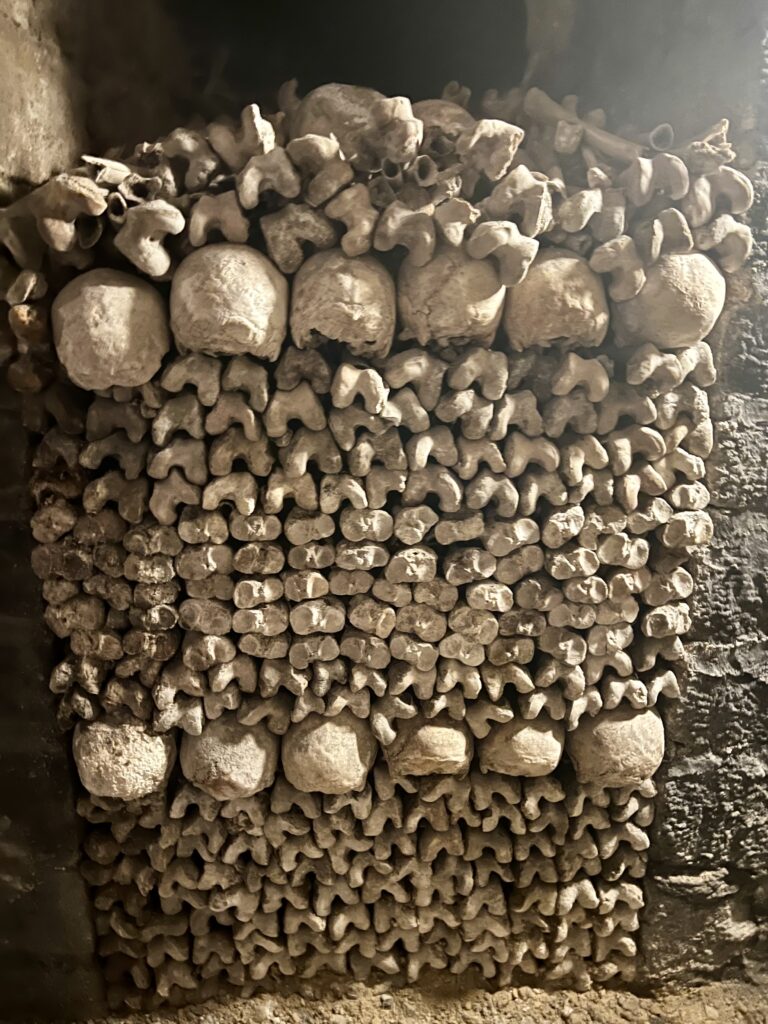
But the quarries proved to be a shaky building foundation. In 1774, due to the weight of the buildings, the first sink hole formed on Hell Street, taking down houses and people with it.
In 1776, the quarries were permanently closed. The state hired Antoine Dupont to map the underground spaces and stabilize them by erecting support walls and piers.
The task was so formidable he created a Quarry Inspection Unit run by Axel Guillaumot, who became known as the “Man Who Saved Paris.” He warned the king, Louis XVI, of the dire nature of the situation.
Guillaumot was authorized to fill in the open spaces and built an elaborate network of access tunnels to allow regular inspection and repair work. Interventions still continue today, with the last sinkhole occurring in 1961.
But what of the ossuaries of bones? Well, sink holes weren’t the only problem in Paris. There was also a horrific sanitation problem affecting the health of the citizens.

Paris had a lot of dead bodies and a limited amount of space to bury them in cemeteries. Bodies were stacked up in cemeteries and graveyards, rotting and poisoning the air with bacteria.
In response to the public health crisis, the French government decided to shut down and evacuate the city cemeteries. Beginning in 1785, bones from the cemeteries were transferred to the old underground limestone quarries.
To avoid public outcry, the bones were transferred at night and scrupulously ritualized.
To respect the formalities, priests led ceremonial processions of black-veiled, bone-laden carts into the quarries and requiems were sung during the transfer.
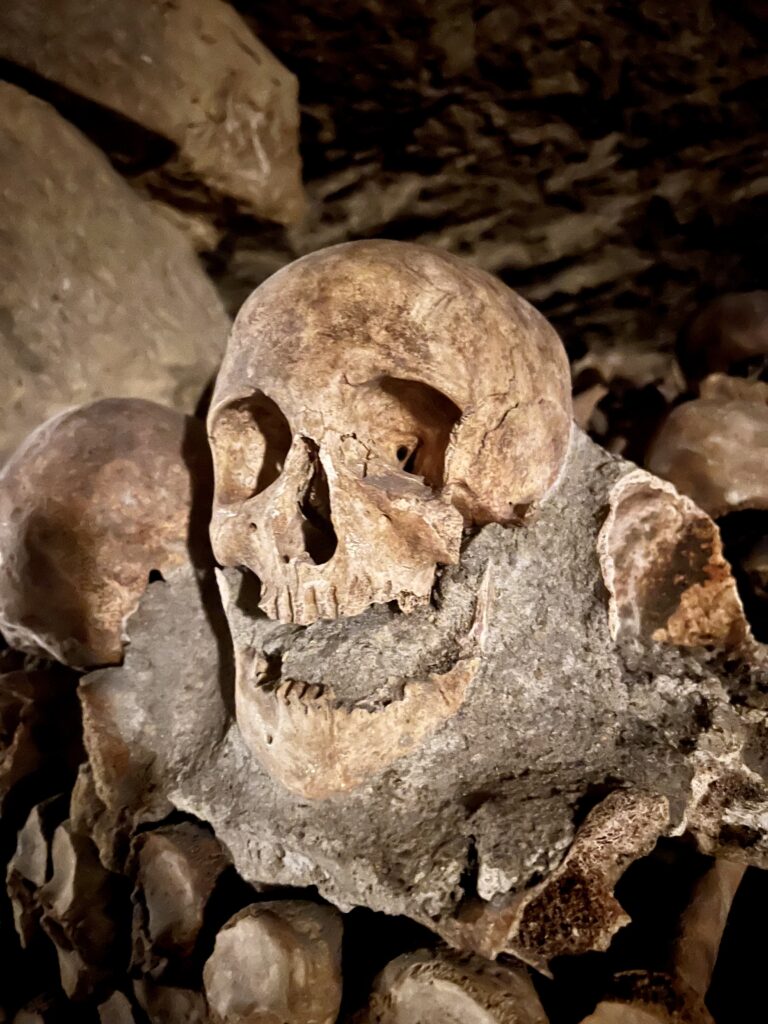
Each transfer was completed with the placement of a plaque indicating the church and district from which that stack of bones came and the date they arrived.
Starting in 1809, the Catacombs were opened to the wealthy elite by appointment. Later, they were opened to the public at large and became a fashionable place to visit.
Parisians contemplated their fleeting mortality in an appropriately Gothic decor. Visits were by candlelight until electricity was installed in 1987.

It was Napoleon who really transformed the underground tunnels into a tourist attraction, akin to the Catacombs of Rome. He hired people to redecorate bones that lay in large piles.
Macabre quotations were engraved on the stones. The walls were lined with tibias and femurs and punctuated with skulls. Bones were arranged in circles or hearts.
Although most of the bones are anonymous, it’s thought that some famous Parisians are buried there — Jean-Paul Marat, Maximillian de Robespierre, Charles Perrault, Nicolas Fouquet, Jean de La Fontaine, and 1343 people guillotined at the Place de la Concorde during the Reign of Terror.
Among those guillotined were King Louis XVI and Marie Antoinette. Some say the ghost of Marie Antoinette haunts the Catacombs.

Guide To The Paris Catacombs: What To See
When you visit the Catacombs, legally, you are only seeing a tiny part of this vast underground network.
There are two parts to a Paris Catacombs visit: the quarries and the ossuary. If you are on a tour, you will also have access to several restricted areas in the quarries.
When you enter, there is a series of informative placards in small rooms that explain the history of the catacombs. If you’re on a tour, the guide will give you a summary.
Your visit to the bony underworld begins by descending a 130 step spiral staircase that takes you 60 feet underground. You’ll first pass through the underground quarries. When you reach the ossuary, you’re greeted by a sign reading “Halt, this is the empire of the dead.”
You’ll walk along uneven limestone floors for about a mile and eventually emerge at a location quite far from where you entered.
Here’s what you can see along the way.
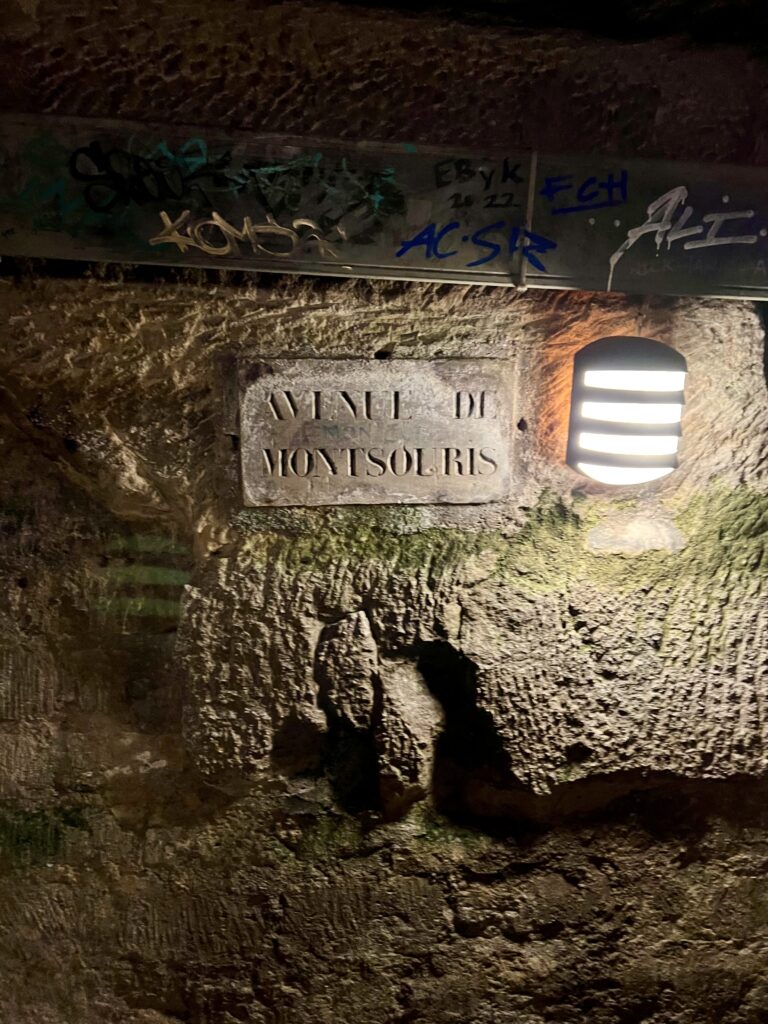
1. Signs, the “Negative” of Paris
As you begin to walk down the dark and narrow corridors of the quarries, you’ll see signs and a black tar line on the ceiling marking the direction to take.
The signs indicate the names of streets you are under, many of which no longer exist. The signs are referred to as the “negative” of Paris.
The architects and engineers of the Quarry Inspection Department also marked their works sites with years and initials. The engraved inscriptions allow historians to follow the progress of the work.
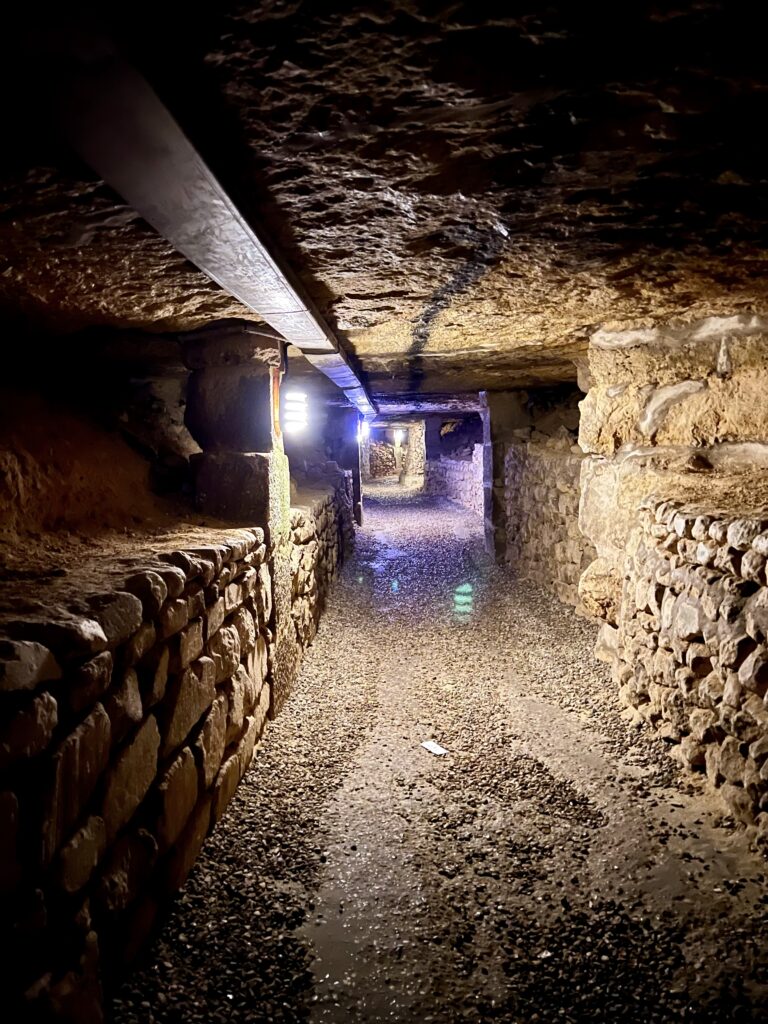
2. Stone Masonry Workshop
The part of the Catacombs called the “workshop” or “atelier” is the part of the quarry still visible.
Two pillars hold up the ceiling, put there by sheer human force. They date from the Middle Ages.
The workshop shows the quarryman’s use of a hagues et bourrages (dry stone wall and waste) quarrying technique. They would extract limestone and then fill in the void with construction waste.
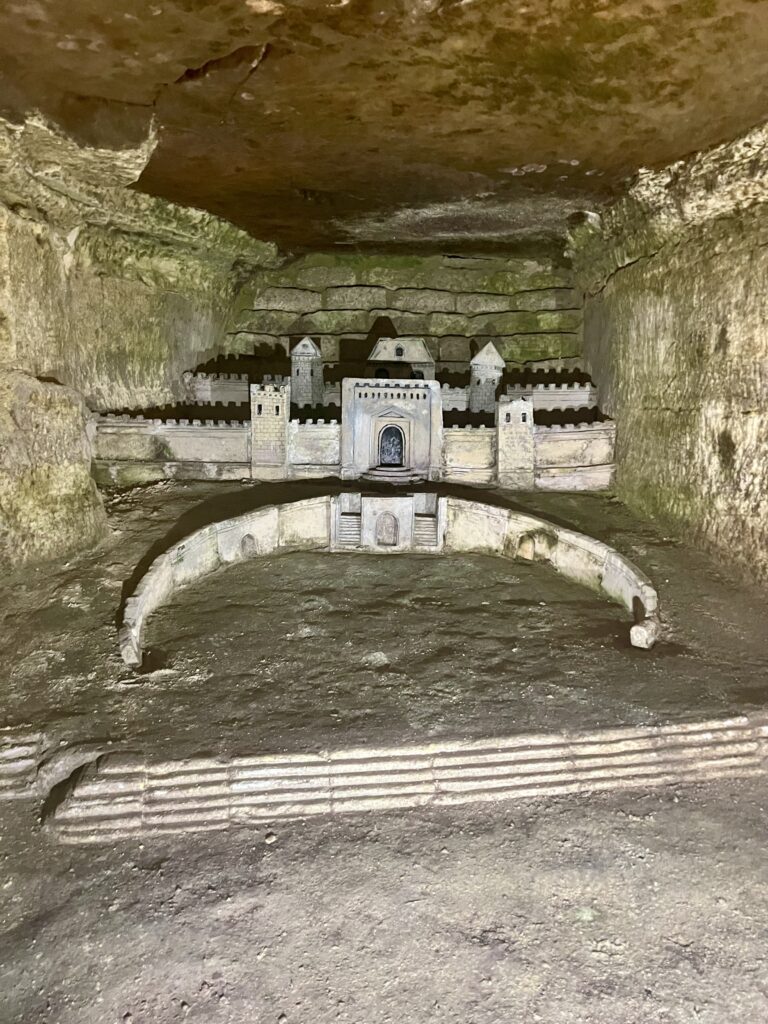
3. Decure Sculptures
If you are on a guided tour, you will make a small detour to a lower level and see two sculptures carried out by a member of the Quarry Inspection Unit named Decure. You may have to wait a bit for a guard to unlock this restricted area for your group.
Decure was the original Cataphile. He would come early or stay late in the quarries to work on his sculptures. The first one was competed in 1782 and is assumed to represent windmills in Minorca, an island he visited as a soldier.
The second one is more elaborate and represents the citadel of Port Mahon on Minorca. Decure worked on it from 1771 to 1782.
Unfortunately, while working on his masterpiece, he was fatally injured when a roof caved in on him.
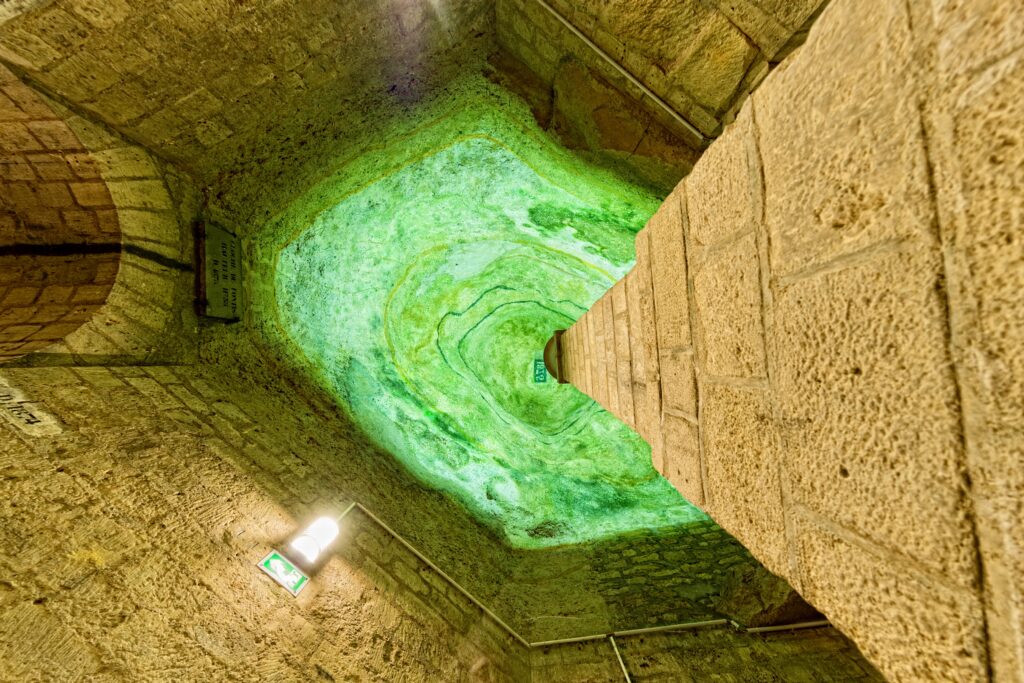
4. The Quarryman’s Foot Bath
Near the Decure sculptures is the Quarryman’s Foot Bath. It’s a water well that was the first geological drill to be used in Paris.
It got its name from the fact that the water was so clear you could only detect it by stepping into it.
One can imagine what fun a mischievous 19th century guide would have had with this feature.
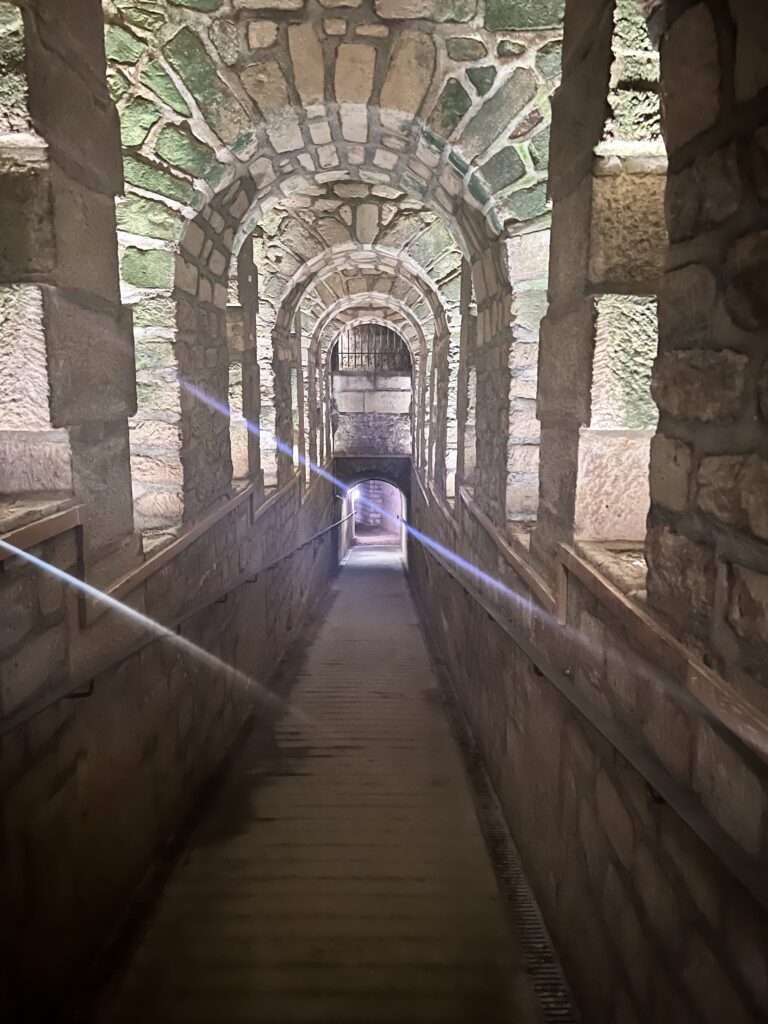
5. Crossroads
At this point, the quarry gallery overlooks a steep ramp that connects the upper and lower Catacombs. The ramp was installed when the Ossuary was created in the 18th century.
Tuscan pilasters are actually solid pillars holding up the ceiling.
Next, you arrive at the Catacombs’ pièce de résistance , the Ossuary. The sign “Stop, this is the empire of the dead” marks the entrance. Thus begins the path that leads you through the remains of millions of Parisians.
Another lintel forces you to bend down, as if mandating respect. On one side, it’s engraved with the words Memoriae majorum (in memory of ancestors). The reverse side warns that “However thou enterest, Death shadowlike will follow thy every step”
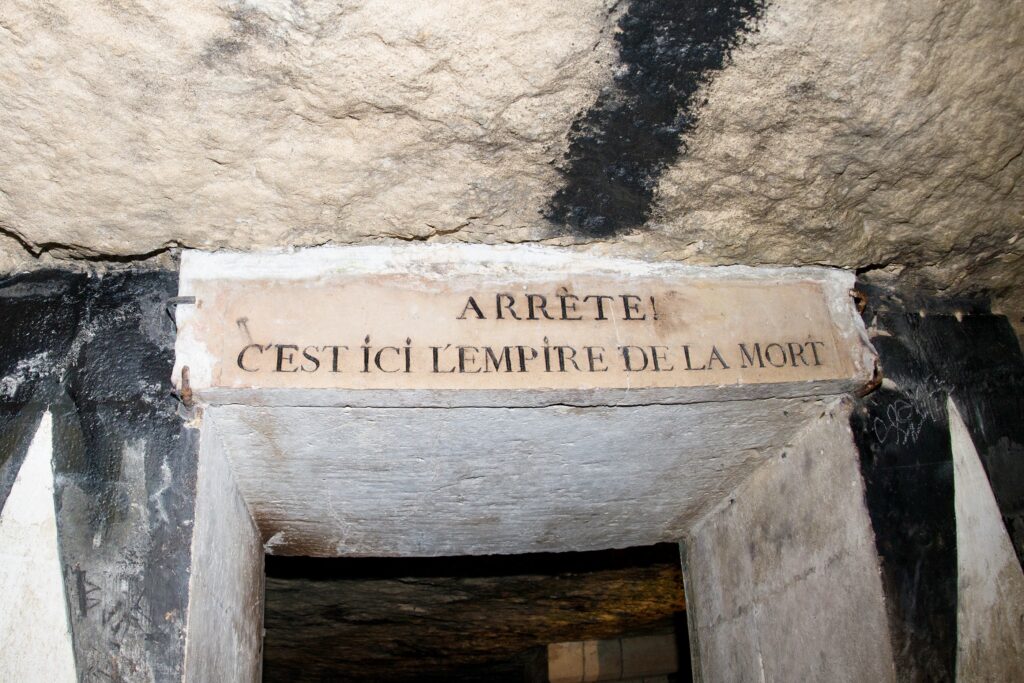
At first, the bones were thrown in somewhat haphazardly. But under Inspector General Herbert de Thury, this area was developed.
The long bones and skulls were arranged decoratively in different patterns to form a back wall. Behind that wall other bones were piled and you can see how far back they go.
To convey a strong sense of respect for the dead, Thury installed plaques specifying which cemetery the bones came from. They almost look like museum exhibits, making the Catacombs more of a monument with appropriate funeral decor.
You begin by walking between two walls of bones. The walls are ornamented with cranium-studded friezes arranged at different heights. Some craniums are arranged in the shape of a heart.
If you have a guide, they will point out the difference between male and female skulls in their eyebrows, eye sockets, and ears bones. You can also identify people who died of syphilis or leprosy.
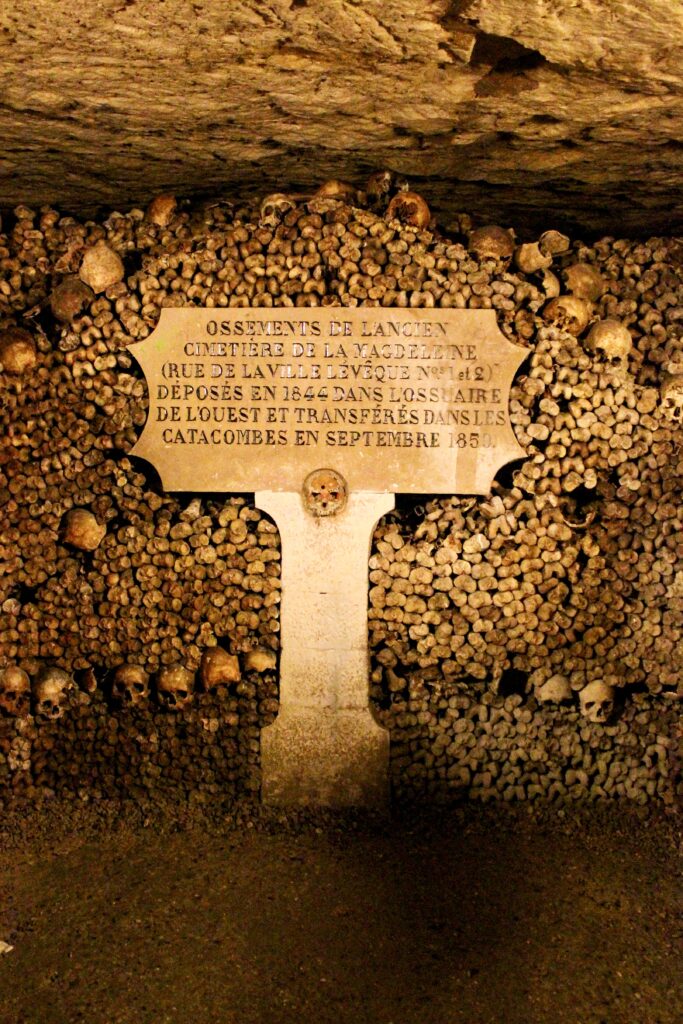
You will see a stone cross, the Croix de Bordeaux, which is a rare religious symbol in the Catacombs. Most religious markers and symbols of the monarchy (like fleur de lis ) were eradicated during the French Revolution.
The next monument you encounter is the Samaritan Fountain. Its name refers to a bible verse promising water to all. But the quarrymen inverted the verse warning that if you drink from it, you will always be thirsty.
If you are on a guided tour, you can also inspect the Altar for Mass. Once completely surrounded by bones, it was damaged and consolidated.
Today, it’s a reproduction of an antique tomb. The very first bones transferred to the Catacombs lie behind the altar. This is where you can have a seat.
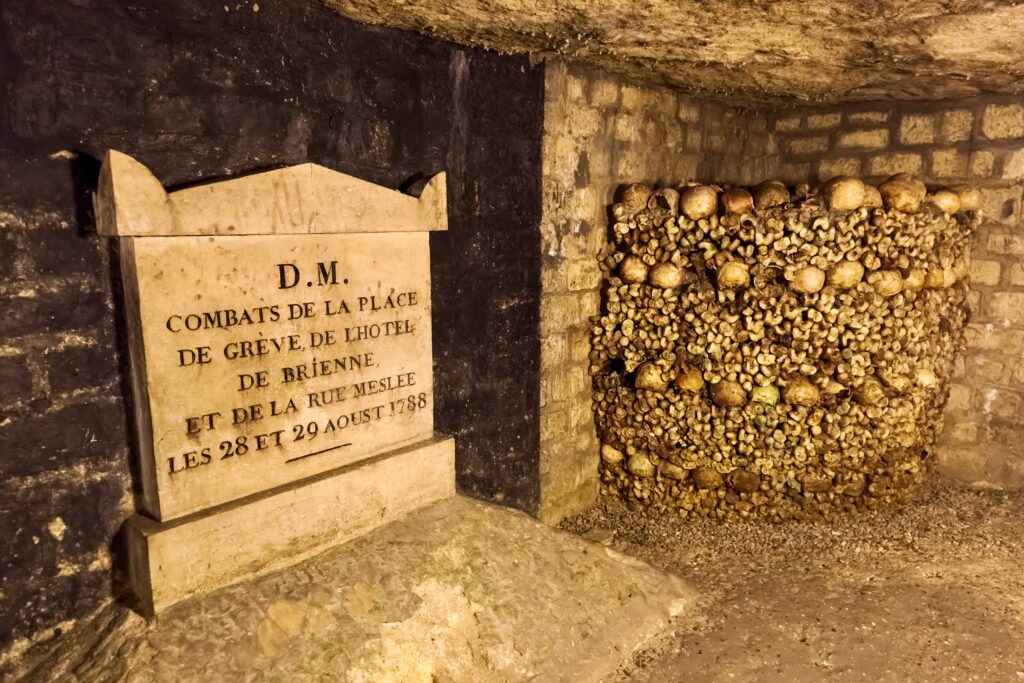
You will then walk past a massive support pillar called the Imitation Pillar, Gilbert’s Tomb, and the Le Mierre’s Gallery.
The latter is known as the Grand Gallery of the Catacombs. This is where Thury gathered together strange anatomical objects discovered during his tenure — fused bones, fractured bones, necroses, and oddly shaped specimens.
Then, there is a tomb monument in tribute to the French Revolution, one mentioning the 1871 Paris Commune, the French Revolution Crypt, a monument dedicated to Pierce Oscar of Sweden’s visit, and another for the bones from the Madeleine Cemetery.
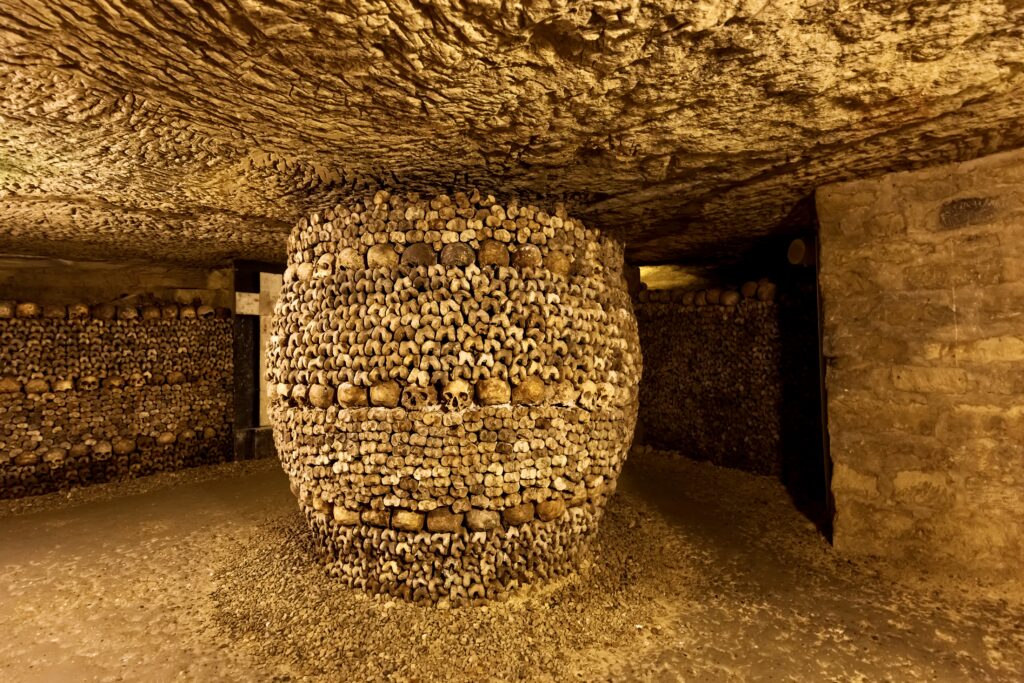
The next gallery space, a bit lower, is the Crypt of the Passion of Christ. You will see the Barrel, a steel pillar clad in bones that resembles a giant barrel vat.
At last, you will arrive at the exit staircase, which is narrow and spirals upward. Built in 1784, it dates back to the origins of the Catacombs.
What Is A Cataphile?
The official Catacombs are the only space open to the public. But there are still 170 miles of sprawling underground quarries.
Urban explorers who enter them illegally are called “Cataphiles.” These rule-breakers have a deep-rooted attraction to the underground.

They enter the Catacombs through secret unauthorized entrances via tunnels, drain covers, or sewers known as Cataflaps. Information on where to find entrances is a fiercely kept secret and the entrances are often camouflaged.
The fine for illegally entering is only € 60, so that doesn’t have much of a deterrent effect. Cataphiles are rarely caught and many inspectors look the other way.
Some Cataphiles come for the peace and quiet of the surreal place. Others create art or crave adventure. Still others set up party rooms and host concerts. Some like the camaraderie of their fellow Cataphiles, almost like a secret cult.
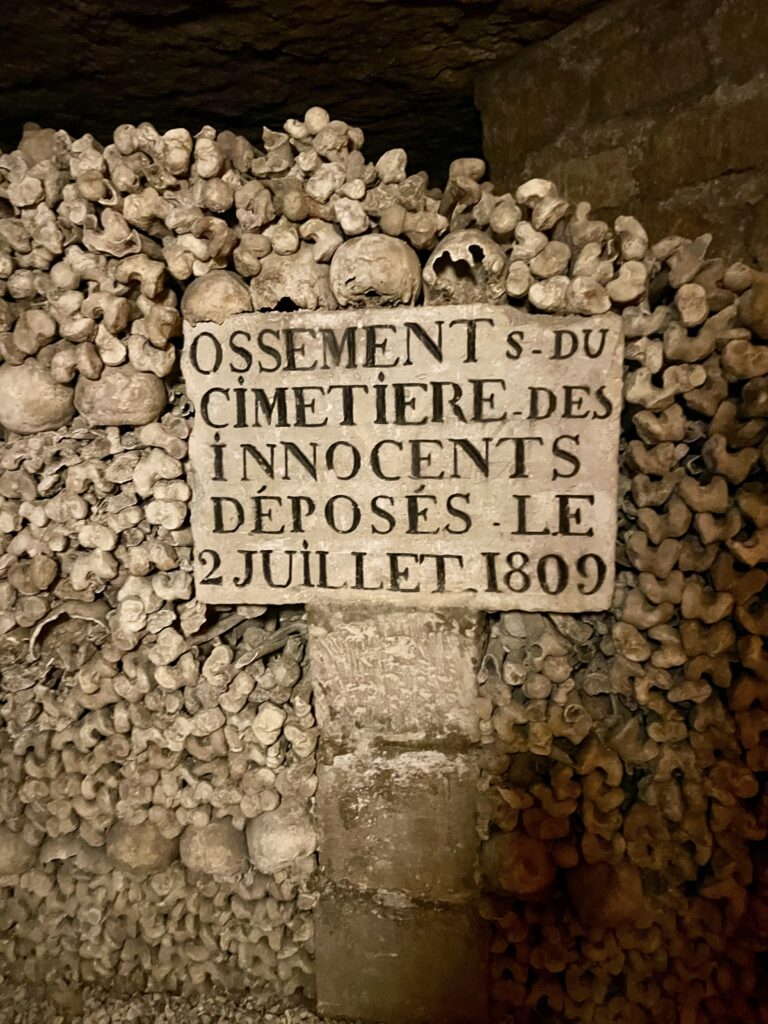
My guide told me that in 2004, near a metro station, Cataphiles pirated power from the station’s electricity. They built an underground bar and cinema with a full size move screen, complete with fairy lights. They guarded the space with a tape of dogs barking to scare people away.
The Cataphiles took the precaution of having surveillance cameras set up. When they saw inspectors (called Catacops), they whisked away all their things and vanished. They left a note saying “Do not try to find us.”
Still, as the unofficial custodians of the Catacombs, the Cataphiles can be useful.
With their expert knowledge of the networks, they help find people who stumble into the Catacombs and get lost. They also anonymously report dangerous spots to inspectors so that they can be fixed before a deadly cave in occurs.
The Cataphiles don’t like the thrill-seeking newbie explorers who have little interest in the history of the place. The Cataphiles call them “Cataclasts” because they often degrade the quarries and leave rubbish. The Cataphiles then do a “Cataclean” to spiffy up their special place.

Practical Information & Tips for Visiting The Catacombs Of Paris:
Here are some must know tips for visiting the Paris Catacombs.
Address : 1 Av. du Colonel Henri Rol-Tanguy. The entrance to the Paris Catacombs is located just outside the Denfert-Rochereau metro stop. At the end of your visit, you will exit at 21 Bis Avenue Rene-Coty.
Opening Hours : The Paris Catacombs are open Tuesday through Sunday from 10:00 to 8:30 pm. The last entrance is at 7:30 pm.
Ticket price : 29 € (audio guide included)
Metro : Denfert-Rochereau
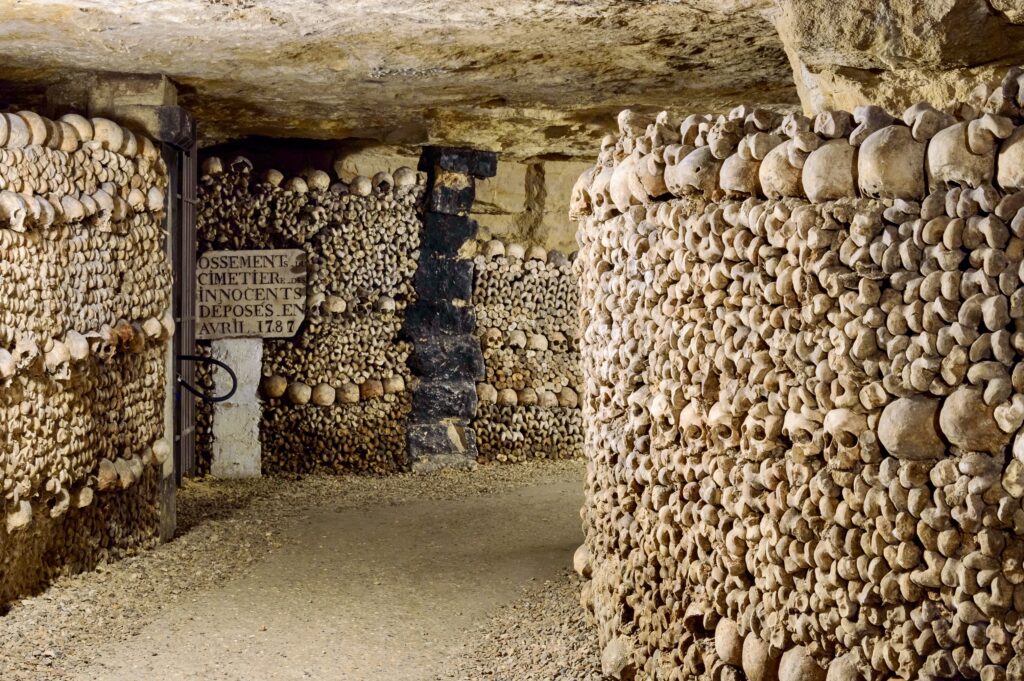
Here are some things to expect on a Paris Catacombs visit.
As you might anticipate, it’s cold below ground in the Catacombs. If it’s summer, bring something to put over your sundress or sleeveless top. The Catacombs are supposedly maintained at 57 degrees, but it felt colder than that on a winter visit to me.
You should also expect it to be humid and a tad smelly (perhaps from stale air).
It should go without saying that you can’t touch the bones at all. They’re very fragile. Taking bones is also considered grave robbing. Instead, you can buy a skull mug at the gift shop.
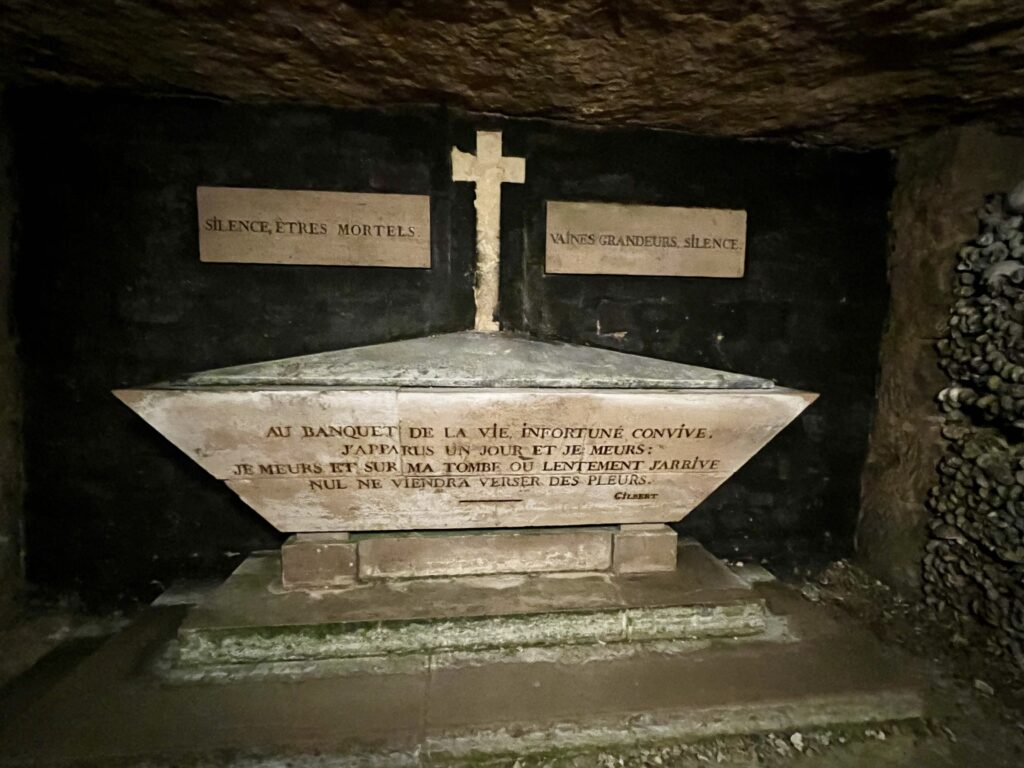
In fact, if you have a small backpack with you, you’ll have to wear it in front or carry it with your hand to avoid inadvertently bumping into the bones. Signs warn that bags can be checked at the exit.
You cannot bring large backpacks or luggage. And there are no cloak rooms for storage.
You can take photos, but you can’t use a flash.
If you are prone to claustrophobia, there may be a better destination for you. Though I thought, despite the low ceilings, that there was plenty of room to move around.
The Paris Catacombs were built for people in the 18th century, who weren’t as tall as most of us today. The height of the tunnels is approximately 6 feet. So, if you’re tall, you’ll need to bend down a bit and watch your head.
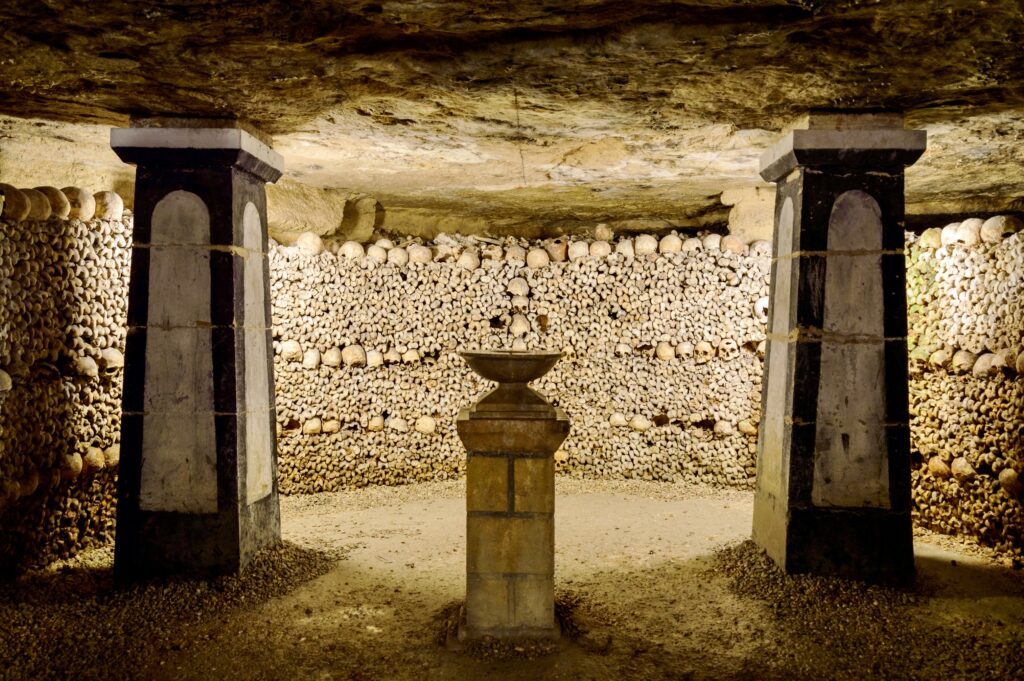
The paths are pebbly and uneven. If has been raining, they may be damp. So wear comfortable shoes and take care.
Unfortunately, the catacombs are not accessible and there is no wheelchair access or elevator. To visit, you’ll need to be able to navigate up and down the spiral staircases.
I hope you’ve enjoyed my guide to the Paris Catacombs. You may find these other Paris travel guides and resources useful:
- 5 Day Itinerary for Paris
- 3 Day Itinerary for Paris
- 2 Day Itinerary for Paris
- Tips for Planning a Trip to Paris
- Tourist Traps To Avoid In Paris
- Top Attractions in Montmartre
- Top Attractions in the Marais
- Best Museums In Paris
- Hidden Gems in Paris
- Best Churches in Paris
- Best Things To Do in Paris in Winter
- Guide to the Opera District
- Secret day trips from Paris
If you need a guide to the Catacombs of Paris, pin it for later.

Leave a Comment Cancel reply
Save my name, email, and website in this browser for the next time I comment.
Last Updated on November 27, 2023 by Leslie Livingston
- Otras Ciudades JavaScript-generated links will go here
Mejores free tours en París
No te pierdas este resumen de los 10 free tours en París más populares y mejor valorados
Free Tours en París

Anímate a explorar la ciudad del amor sin gastar demasiado dinero. Si estás planificando qué ver en París , te contamos sobre los mejores free tours en París para que conozcas su historia, cultura y costumbres de una manera divertida y económica.
En esta guía rápida sabrás cuáles son los free tours en París mejor valorados, más populares y en español , Además conocerás cómo funcionan, cuáles son sus ventajas y cuál es su costo (spoiler alert: ¡casi nada!).
¿Qué es un Free Tour?
Un free tour es un recorrido en el que puedes apuntarte sin necesidad de pagar de forma anticipada. Por lo general, los free tours son organizados por tour operadores o por guías independientes que sienten verdadera pasión por la labor que realizan.
¿Los Free Tours son realmente gratuitos?
Pese a usar la palabra «free», eso no quiere decir que no tengas que rascarte el bolsillo. Es cierto que no hay que pagar ninguna tarifa predeterminada, pero sí se espera que entregues una propina proporcional a la calidad del tour que hayas realizado.
Ventajas de realizar un (o varios) free tours en París:
- Podrás reservar de forma gratuita sin pagar por adelantado.
- Realizarás un recorrido acompañado de un guía, que no sólo te proporcionará información sobre los monumentos de París , sino que además podrás preguntarle sobre lugares dónde comer , dónde ir de compras o cualquier pregunta que tengas sobre París.
- Es una excelente ocasión para conocer a otras personas.
- Al final del tour sólo tendrás que pagar el dinero que consideres justo por la experiencia.
¿Es obligatorio reservar?
Sí. Para participar en cualquiera de los free tours en París debes realizar la reserva correspondiente. En nuestra lista de tours, además de una breve reseña sobre cada uno, también encontrarás los enlaces dónde podrás hacer las reservas.
Free Tour por Montmartre y Sagrado Corazón
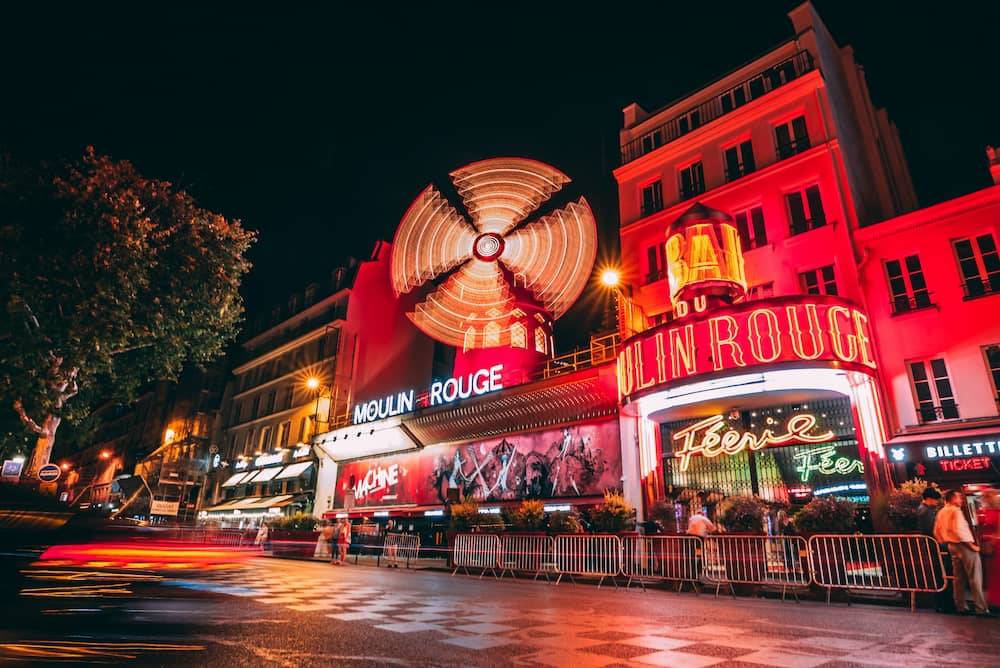
Para conocer el París artístico donde se refugiaban personajes como Dalí y Picasso, los cafés a pie de calle, los cabarets y algunas de las locaciones de la película Amélie, este free tour por Montmartre es la experiencia que andas buscando.
El tour por el barrio de los artistas comienza en la Place Blanche, frente al famoso cabaret Moulin Rouge (estandarte de La Belle Époque). A poca distancia, se encuentra el Café deux Moulins (donde se rodaron algunas escenas de la película Amélie) .
Este tour impregnado de arte, viene cargado de más sorpresas que no querrás perderte. El recorrido tiene una duración de unas 2 horas y media y termina frente a la Basílica del Sacré-Coeur .
Ver más detalles y reservar
Free Tour por el Barrio Latino
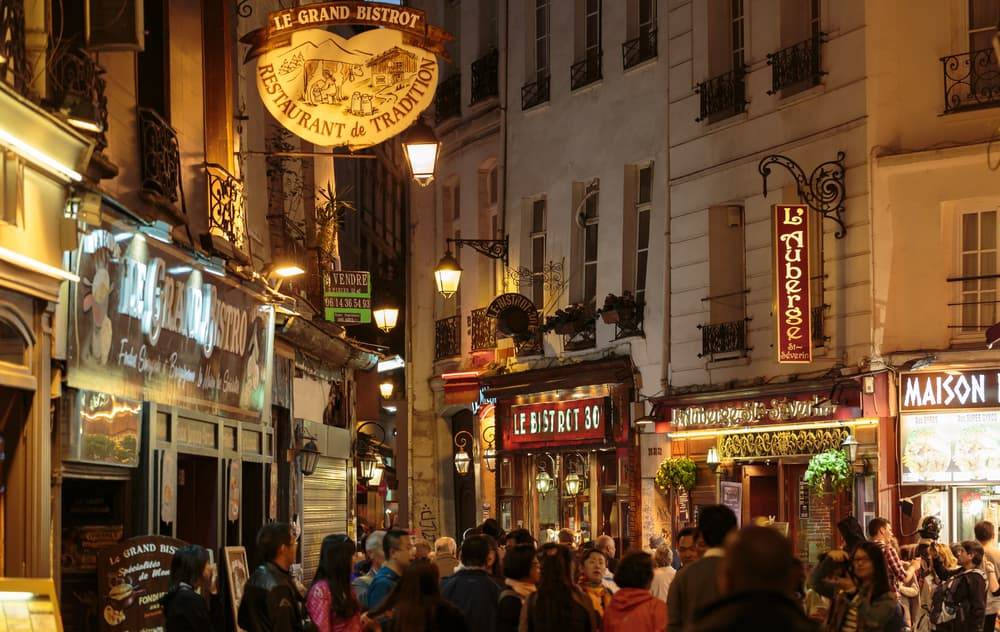
El free tour por el Barrio Latino de París recorre lugares muy pintorescos, como la Rue du Chat Qui Pêche (la calle más angosta de París), hasta monumentos solemnes, como el Panteón de París, donde reposan los restos de personajes ilustres como Marie Curie o Victor Hugo.
Conocerás la Plaza de la Sorbona, la iglesia San Severino, el Museo de Cluny (donde escucharás el relato sobre los desdichados que se atrevieron a retar al poder de Nôtre Dame).
Si eres de los que piensa que el Barrio Latino de París debe su nombre a la influencia de Bad Bunny y Shakira, deberías apuntarte a este tour, de dos horas de duración, para que conozcas la verdadera historia detrás del nombre.
Free Tour de los misterios y leyendas de París
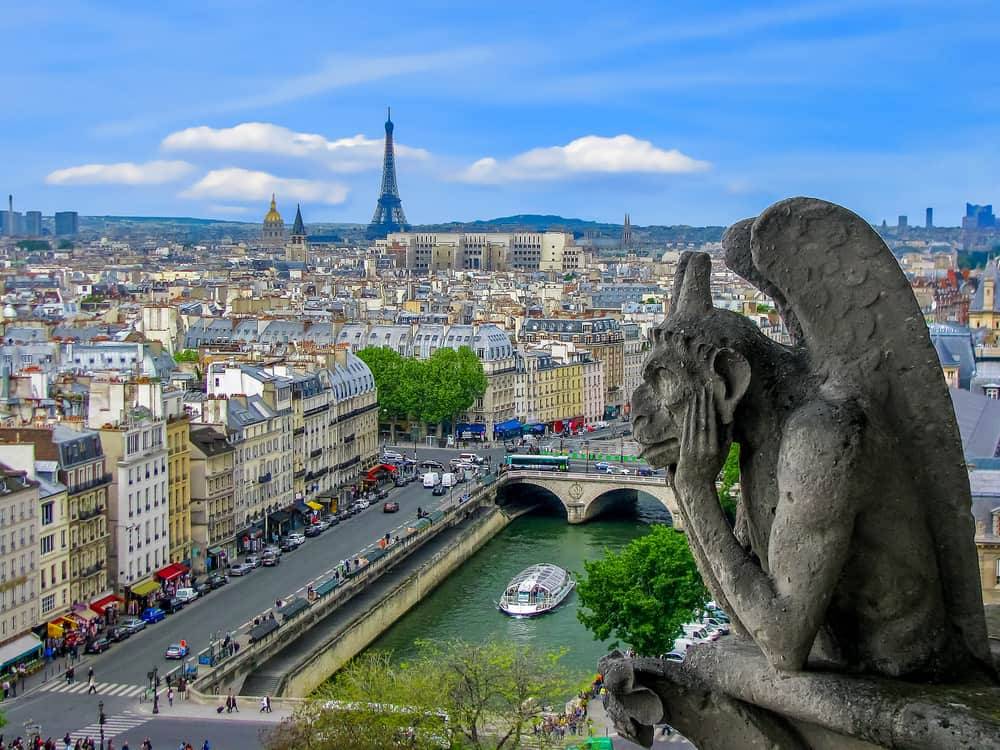
Asesinatos, guerras, pestes, conspiraciones y cabezas cortadas en la guillotina (el invento francés más influyente en el devenir del país) forman parte de la oscura historia de la capital francesa.
Si quieres conocer la ciudad del amor, mejor sáltate un par de párrafos. El free tour misterios y leyendas de París va sobre muerte, fantasmas y sangre ¿sabías que el Palacio de la Justicia era un lugar de torturas y ejecuciones?
Escucharás la leyenda del barbero y del panadero de la rue Chanoinesse, conocerás los relatos sobre las Catacumbas de París y la terrorífica historia sobre la maldición de los Caballeros Templarios.
¡Apúntate a este tour de 2 horas sólo si tienes lo que hay que tener!
Free Tour Torre Eiffel y Arco del Triunfo

Conoce a fondo los símbolos más emblemáticos de la ciudad de París en este free tour de la Torre Eiffel y Arco del Triunfo. Visitarás los Campos Elíseos y tendrás una visita exterior de la Mansión Louis Vuitton.
¿Sabes el significado de las inscripciones del Arco del Triunfo ?, ¡A que ni te imaginas que al momento de su construcción los parisinos aborrecían la Torre Eiffel! Entérate sobre estas y otras anécdotas en este inolvidable tour.
Le meilleur du meilleur!
Free Tour del París Imprescindible
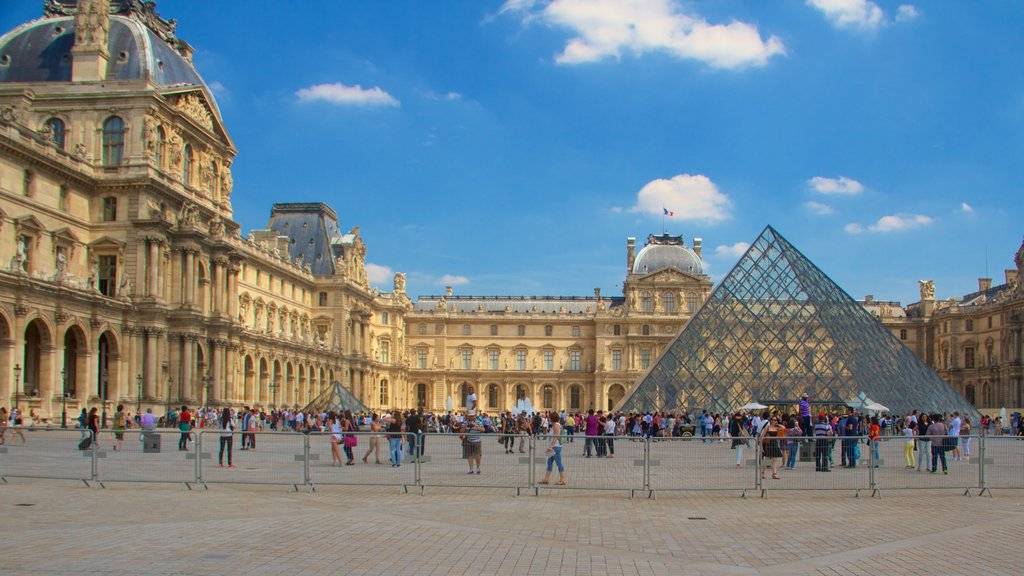
El free tour del París imprescindible, comienza cerca de la Catedral de Notre-Dame y prosigue cruzando el Sena sobre el Pont Neuf. A continuación, el recorrido continúa hacia la famosa pirámide de vidrio del Louvre hasta atravesar el Jardín de Tullerías. Desde donde podrás observar el Museo Orsay y el Arco del Triunfo del Carrusel.
Finalmente, el tour terminará en la Plaza Vendôme junto a las joyerías y tiendas más exclusivas de todo París. ¡No te lo pierdas!
Free tour por el París esencial
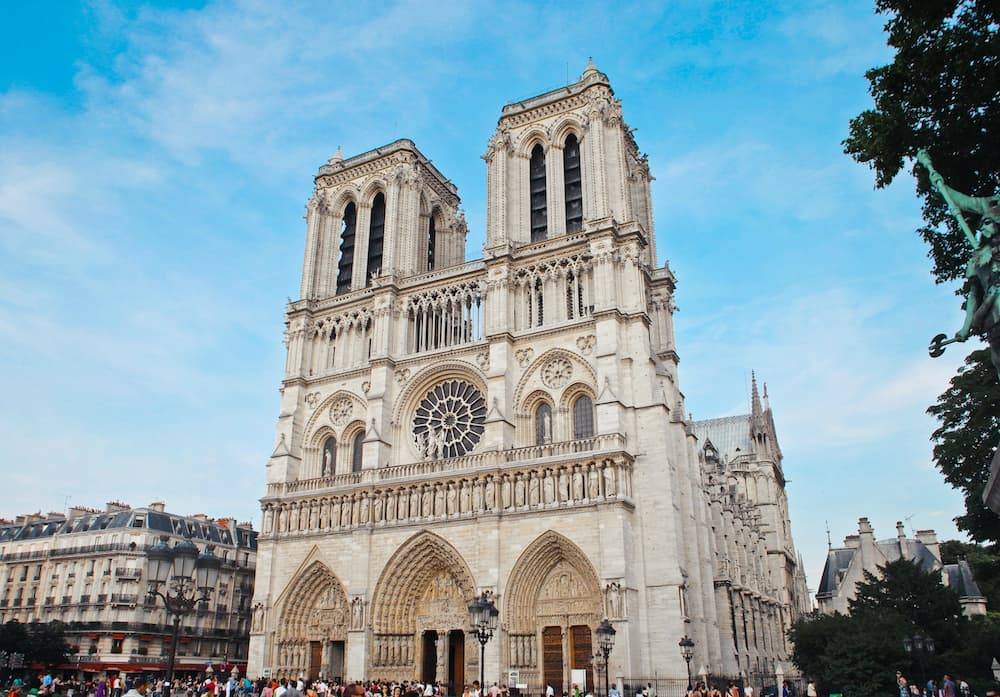
En este free tour por París en español (con una duración de 2 horas y 45 minutos), conocerás la île de la CIté, donde podrás admirar la fachada de la catedral de Notre-Dame , además de la Sainte-Chapelle , La Conciergerie, el Palacio de Justicia y el Pont Nuef .
La ruta a pie continúa junto al río Sena, pasando por el Pont des Arts. Aprenderás historias sobre el Rey Sol, Napoleón Bonaparte, la Revolución Francesa y otros acontecimientos importantes de la historia de Francia. A continuación, conocerás los jardines de las Tullerías y podrás echar un vistazo al Arco del Triunfo del Carrusel.
Finalmente, el tour termina frente al Museo del Louvre . Este free tour por París se encuentra entre los mejor valorados entre los más de 200 mil viajeros que lo han realizado.
Free Tour por el casco histórico de París

El free tour por el casco histórico de París te llevará a conocer los principales puntos turísticos de la ciudad. Desde la catedral de Notre-Dame hasta la Pirámide del Louvre, desde el Pont Neuf hasta la Torre Eiffel y muchos más ¡Todas las atracciones importantes en un sólo recorrido!
Más de 780 opiniones favorables otorgan a este tour la máxima valoración posible. Los usuarios cuentan que es excepcional, divertido, entretenido y que repetirían sin dudarlo. El paseo dura algo menos de tres horas y para reservar sólo tienes que entrar en el siguiente enlace.
¡Free tour imprescindible en París!
Free Tour de “Emily in Paris”

En este free tour único y original seguirás los pasos de Emily Cooper, protagonista de la popular serie de Netflix « Emily in Paris «, recorriendo los escenarios reales donde está grabada.
Visitarás el edificio de apartamentos donde vive Emily, su lugar de trabajo, el restaurante Gabriel , los Jardines del Palacio Real y el Louvre, entre otras locaciones de la serie.
El tour tiene una duración de poco más de 2 horas y más de doscientas opiniones positivas le recomiendan.
Free Tour por Montmartre, Moulin Rouge y Pigalle
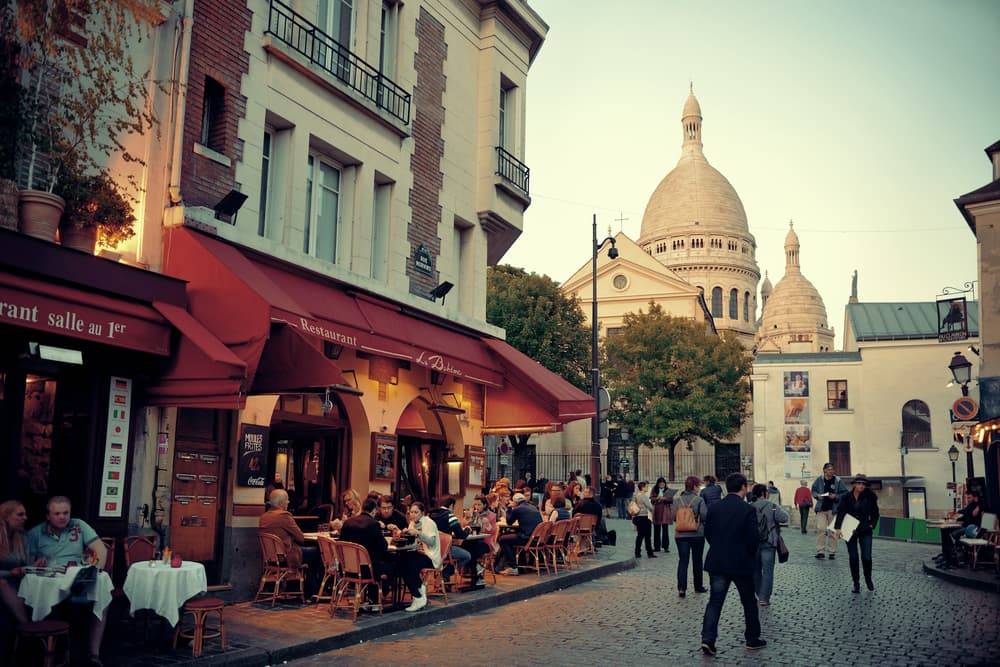
A los amantes del arte les encantará este free tour por Montmartre, Moulin Rouge y Pigalle. Además de recorrer dos de los barrios de París con más encanto , tendrás la oportunidad de descubrir cientos de anécdotas e historias relacionadas con la vida artística y bohemia propios del lugar.
Conocerás el Palacio de la Paiva, el Monumento de Gavarni, el Cabaret Le Chat Noir y el edificio que una vez albergó la Maison Close (un antiguo prostíbulo).
Recorrerás el Boulevard de Clichy hasta el famoso Moulin Rouge. Verás locaciones de la película Amelie, el Muro del Amor, la residencia Bateau-Lavoir donde vivió Picasso y muchos otros lugares.
La guía de este tour se llama Nuria, es de Madrid y es una experta en historia del arte.
Free Tour de la Plaza de la Concordia a la Torre Eiffel
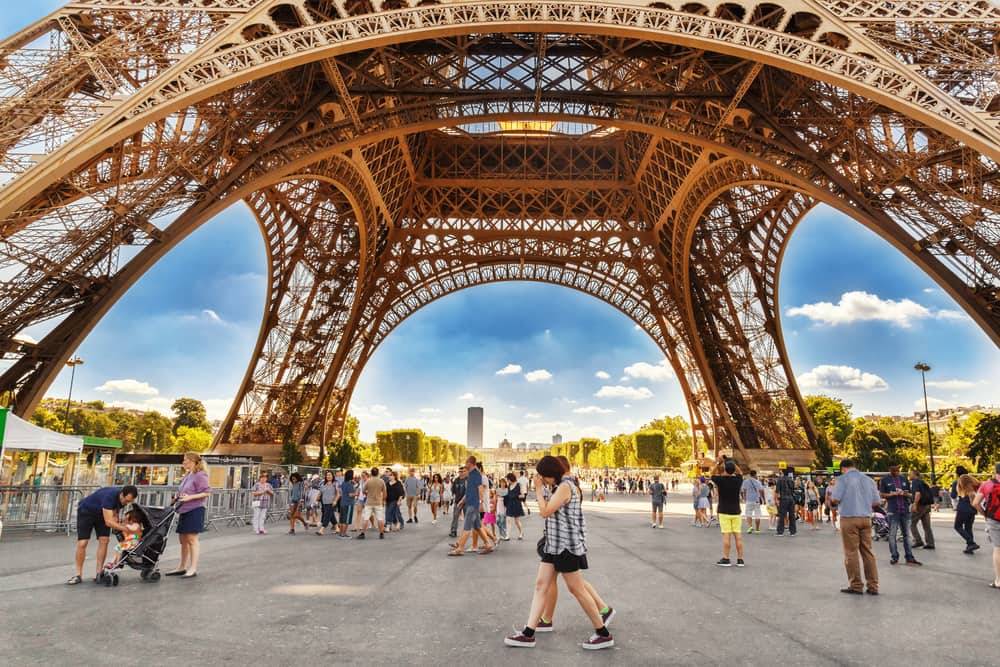
Finalizamos nuestra lista de recomendaciones con este free tour de la Plaza de la Concordia a la Torre Eiffel. En un recorrido de 2 horas de duración, verás lugares emblemáticos como la Asamblea Nacional, el Hotel Crillon y la Avenida de los Campos Elíseos.
La lista de monumentos continúa hasta llegar a la Torre Eiffel, pero el tour no sólo va de ver, también va de escuchar las interesantes historias que atesora la ciudad.
¡100% recomendable!
Más consejos para ahorrar en París
No es ningún secreto que la capital de Francia es una ciudad cara. Por ello, si buscas alojamiento, hemos preparado una guía donde te contamos las ventajas de cada distrito para que decidas dónde dormir en París .
Y si viajas acompañado por los más pequeños de la casa, no pierdas la ocasión de consultar nuestra página sobre qué hacer en París con niños . ni mucho menos toda la información que hemos recopilado para que organices tu visita a Disneyland París .
Para disfrutar de la ciudad de la luz ¡aprovecha al máximo nuestra guía de París ! Donde encontrarás toda la información que necesitas de una forma original y entretenida.
Ideas y consejos para viajar a París
Sigue planificando tu viaje a París y ahorra con estas ideas

Cómo viajar barato a París
Entérate cómo ahorrar en París en atracciones, transporte, alojamiento, comidas y mucho más

Pase turístico de París con entrada a más de 75 atracciones como el Louvre, y Versalles.
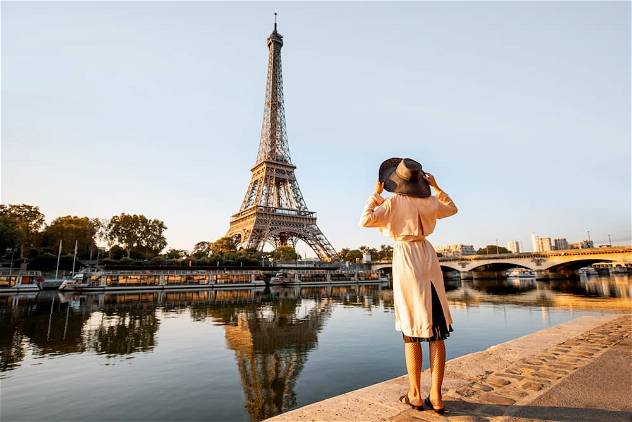
Consejos útiles si visitas París por primera vez
Si es tu primera visita a París, te damos algunos consejos prácticos que te harán las cosas más fáciles y te servirán para que te ahorres varios problemas.

Días gratis en los Museos de París
Ahorra en tu viaje a París descubriendo los días gratuitos de los mejores museos.

Ideas románticas en París
Ideas románticas clásicas para un fin de semana en pareja en la ciudad del amor.
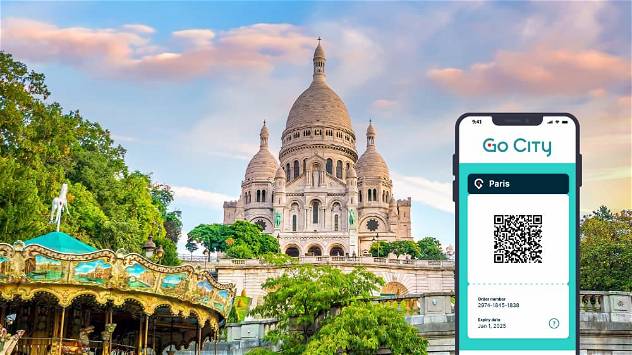
Go City Paris Pass
Tarjeta turística que te brinda acceso a las mejores atracciones de París mientras ahorras tiempo y dinero. Incluye la subida a la Torre Eiffel, tour y entrada sin colas al Louvre, entre muchas otras.

- Resumen de privacidad
- Cookies estrictamente necesarias
Esta web utiliza cookies para que podamos ofrecerte la mejor experiencia de usuario posible. La información de las cookies se almacena en tu navegador y realiza funciones tales como reconocerte cuando vuelves a nuestra web o ayudar a nuestro equipo a comprender qué secciones de la web encuentras más interesantes y útiles.
Las cookies estrictamente necesarias tiene que activarse siempre para que podamos guardar tus preferencias de ajustes de cookies.
Si desactivas esta cookie no podremos guardar tus preferencias. Esto significa que cada vez que visites esta web tendrás que activar o desactivar las cookies de nuevo.
Catacombs of Paris
A labyrinth of skeletons that you can visit in the city's subsoil.
Paris Catacombs
Paris Catacombs are located were originally excavated to obtain limestone for the construction of many buildings in the city. Years later, the overcrowding of the Parisian cemeteries changed its usefulness.
Today, in this underground labyrinth of more than 300 kilometers, are the bones of some 6 million people .

History of the Paris Catacombs
In 1786, Paris was struggling with epidemics and cemeteries without space. With the intention of freeing up places in their cemeteries, it was decided to transfer the corpses from various cemeteries and common graves to these tunnels. What you can visit today is a part of this complex labyrinthine structure.
At first the bones were simply deposited without any order, but from 1910 they began to be organized in the way that can be seen today: the longest bones, such as the femur and tibia, joined to form the walls on the sides of the bones. tunnels, were decorated with skulls and at the same time held the smaller bones behind the wall.
Some curious facts about the Paris Catacombs
Victor Hugo used his knowledge of the catacombs in his 1862 novel Les Miserables ( his house can also be visited ).
The German army built a bunker here and they were also used by the French Resistance during World War II.
Of the 300 kilometers that make up the catacombs, only one and a half kilometers is open to the public, for security reasons and to avoid acts such as black masses, which were held here in the past.
It is illegal to enter the catacombs without being accompanied by an official guide and no more than 200 people can visit the site at a time.
Visit the Paris Catacombs
The Paris Catacombs can be visited since 1874.
The ticket is around €30 with an audio guide included, essential to appreciate the history that surrounds the place and to really know everything that the place where you are standing represents.

You can book here tickets to visit the Paris Catacombs without queuing at the ticket office. Recommended, since on very busy days you can wait up to two hours. It also includes an audio guide.
€29 includes audio guide / buy
From Tuesday to Sunday 10:00 am-4:00 pm (closed on Mondays, Christmas and New Year)
Avenue du Colonel Henri Rol-Tanguy, 1
How to get there?
Metro lines 4 and 6, Denfert-Rochereau station / RER: line B, Denfert-Rochereau station / Buses: 38 and 68
More attractions in Paris
Places near the Catacombs of Paris that you can visit
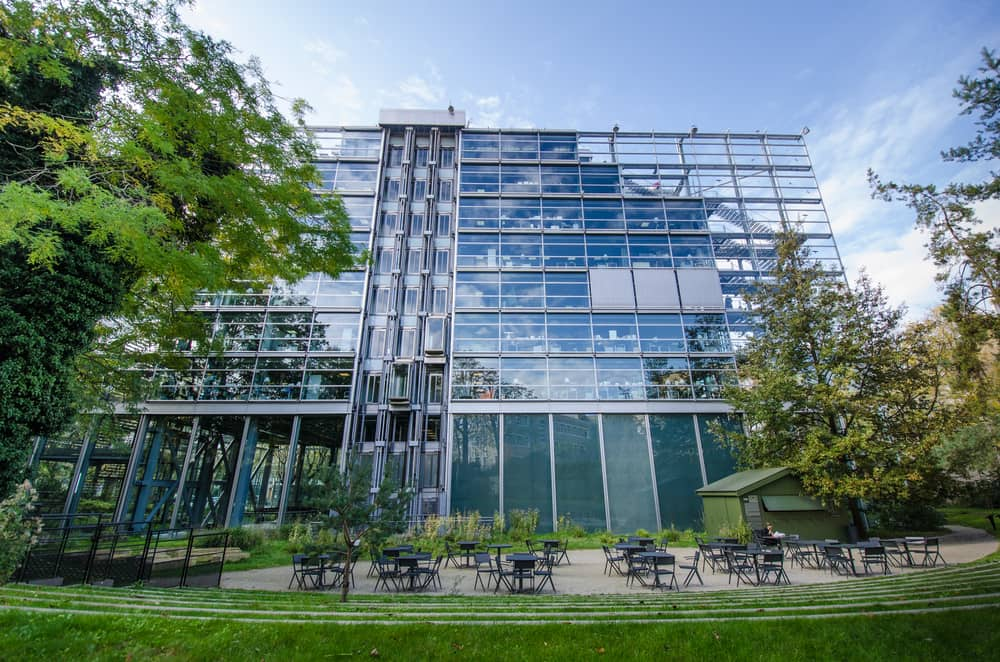
Cartier Foundation
Gallery with temporary exhibitions of contemporary art without restrictions of style or discipline, painting, sculpture, video and photography.
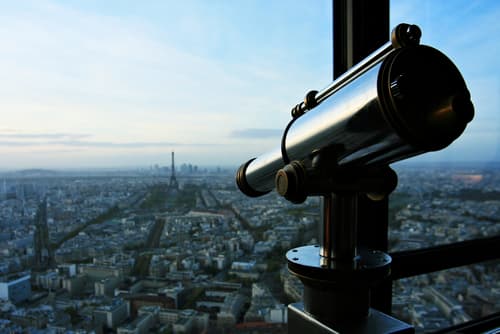
Montparnasse Torre
The skyscraper Tour Montparnasse is the second tallest in France, has an observation deck with incredible views of the entire city.
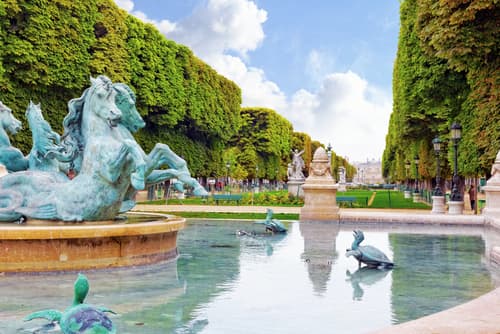
Luxembourg Gardens
Historic gardens of Paris populated with chestnut trees, lime trees, plane trees and other exotic species, are very popular among Parisians.


How to Visit the Paris Catacombs (and a Bit of History)
Last Updated on April 25, 2024

Few places in the French capital inspire the kind of morbid fascination that the Catacombs of Paris do– and that’s not a surprise. The relatively small section of the vast network that’s open to the public stretches in narrow underground tunnels for around 1.5km/1 mile, carved from limestone and neatly lined with the remains of some six million human corpses.
Amazingly enough, this macabre public exhibition only represents a tiny section of les catacombes . An anonymous memorial to millions of unnamed, deceased residents of ages past, the Paris catacombs are filled with human femurs, skulls, and other bones– piled in oddly ornate, neat displays, and narrated by poems and quotes about death.

Leave it to the French to make even something this dread-worthy artful and philosophical, right?
But however tidily the millions of bones and skulls may be arranged in their towering stacks , they also hit a taboo nerve.
The piles of corpses speak both to our dread of mortality, and to our fascination with how societies manage death, from a logistical standpoint. In the West, where death is rarely confronted directly in daily life, it seems apt that it would be driven deep underground. A bit like Hades, or the ancient Greeks’ subconscious realm of nightmares.
Created in the late 18th century, the Catacombs may seem like an old-fashioned oddity. But they are in fact the result of modern, more hygienic and efficient ways of managing human remains. And their almost poetic curation into a ‘museum’ of sorts is connected to the development of the tourism industry in the 19th century– another distinctly modern phenomenon.
{These Are The Weirdest Museums in Paris}
Keep reading to learn more about the history of this intriguing site, what to look out for when touring the Paris Catacombs, and for my full tips on making the most of your visit.
Explore This Article
A Horrific History: Exhuming the Cimetière des Innocents, an Overflowing Graveyard

The story of the Catacombs begins in the late 18th century, when officials began to recognize that traditional city cemeteries had become putrid, overflowing, deeply un-hygienic catastrophes.
For hundreds of years, the centrally located Cimetière des Innocents had been the postmortem home of generations of Parisians. With origins in the early medieval period, it served as a burial ground for the 5th-century Notre-Dame-des-Bois church. It soon became the city’s main cemetery.
{Related: Take a Self-Guided or Virtual Tour of Medieval Paris}
Located around the corner from the bustling Les Halles animal market (since transformed into a monstrous, confusingly laid-out shopping center), the cemetery was overcrowded and shambolic, with many layers of graves and human remains piled atop one another.
By 1780, conditions had worsened. To create space, the graves of Parisians who had been dead for decades or centuries were exhumed, their skeletal remains tightly packed together into charnier s (mass graves) built in the walls of the cemetery.

The main burial grounds reportedly rose two metres (more than six feet) above the ground compared to surrounding streets, with layers of graves separated only by loose mounds of earth.
16th-century French writer Rabelais alluded to the horrifying conditions at the cemetery in a section of his famous multi-volume work Pantagruel , describing Paris as
“a good city to live in, but not to die in, since the beggars of Saint-Innocent {cemetery} warmed their asses on the bones of the dead.” (« une bonne ville pour vivre, mais non pour mourir ; car les guenaulx (les gueux) de Sainct Innocent se chauffouyent le cul des ossements des morts ».
And during the mid-18th century, merchants and residents began to complain of fetid, horrifying odors emanating from the Innocents and infecting surrounding buildings. Most famously, in 1780, a restaurant owner named Gravelot was terrified to find that part of a mass grave had collapsed ; the cellars of his restaurant on rue de la Lingerie were “invaded” by corpses.
{More Weird French History: The Strasbourg Dancing Plague of 1518}
Some historians claim this horror-movie-worthy incident was “the” event that pushed local authorities to close the Innocents cemetery in 1785. This necessitated the creation of new burial places, and the Catacombs, of course.
To solve the problem of relocating millions of corpses from Les Innocents, city planners and officials had to get creative. They identified a vast network of underground limestone quarries on the left bank– much of them then outside the bounds of Paris– as an ideal place to store the historic remains of countless Parisians.
Creating the Paris Catacombs: A new site on the left bank

Beginning in 1785 and carrying through the following year, the city undertook a first major “evacuation” of remains from charnel houses and mass graves at Les Innocents. The transfers were completed at night in an attempt to fend off criticism or shock from residents and church officials.
Workers heaped bones into quarry wells, then piled them in the galleries of old subterranean quarries. The site, near modern-day Montparnasse, was deemed the “Paris Municipal Ossuary” in 1786.
{Related and nearby: A Walk Through Montparnasse Cemetery}
In later decades and following the French Revolution, other graveyards and cemeteries in the city center were exhumed, with more remains transferred to the Catacombs. The project significantly picked up after 1840, as Haussmann’s and others’ efforts to modernize the city picked up significant speed.
In 1809, the Catacombs were opened to the general public, but only by appointment. It quickly became a hit with locals and tourists, and even figures such as the Emperor Napoleon III and his son visited the site.
Part of the appeal was its mythical association with ancient Roman catacombs in nearby Italy. Another part of it a nineteenth-century, Romantic interest in the macabre (and the medieval). And by the mid-19th century, early photographers such as Felix Nadar brought worldwide attention to the Catacombs and their “empire of death”.

Today, the Catacombs are connected to and managed by the same team behind the Musée Carnavalet, dedicated to the history of Paris. Of course, I highly recommend a visit to both.
Touring the Paris Catacombs: Highlights & Tips

Touring the Parisian Catacombs is fascinating, but (at least to me) it’s more of an archeological adventure than a creepy attraction fit for a Halloween outing. The 45-minute circuit takes you down a long spiral staircase to enter the old limestone quarries.
{A Few Famous French Ghost Stories & Hauntings}
As you pass through the tunnels– some quite narrow and almost claustrophobic, others wide “galleries”, take note of how the thousands of bones and skulls tightly packed around the sides are have been arranged.
Some form crosses or other recognizable, symmetrical patterns, while others appear to be unceremoniously lumped together in tall stacks and lines, sometimes behind metal grates and under low ceilings.

There’s something overwhelming and moving, but also oddly impersonal, about the spectacle. Who are all these people, and what sorts of lives did they live? We know, as mentioned above, that many were plague victims. But beyond that, their particularity melts away, forming an uncanny sea of anonymous bones, eye sockets and grinning teeth.
It’s a reminder of our smallness, our impermanence, our fragility. It even suggests the limitations of human memory, since many or most of these unnamed people once had graves that marked their lives, differentiating them from others among the dead.
All of those individuating markers were swept away when these remains were exhumed and transferred to the catacombs. Who knows what skull belongs to which femurs?
The only way to distinguish between one cluster of bones and another? You’ll see signs that state the source of a particular set of remains, and the date of their exhuming, such as this one, reading “Bones from the former St-Jean Cemetery (Rue du Faubourg Montmartre, n. 60)/ Deposed in 1846-1847 in the Western Ossuary and transferred to the Catacombs in September 1859”:

If you’re a Buddhist, you might find the erasure of individual lives liberating or even slightly funny. With the exception of the odd tomb for notable Parisian aristocrats, no egos can thrive here, and the bounds between rich and poor, prominent and ordinary have essentially disappeared.
But if the idea of being remembered means something to you, there’s something quietly terrifying, and very sobering, about it all.
Luckily, you’ll be aided in your existential reflections by carefully placed poems and philosophical musings about mortality throughout the circuit– one of my favorite aspects of the displays.

The block above roughly translates as follows:
“What enclosures have opened! What narrow spaces Occupy, between these walls, the dust of races! It is in these places of forgetting, and among these tombs That time and death come to cross their false(hoods), That the dead are piled and pressed under the earth! The numbers here are nothing, the crowd is alone”
Whether you find these poems and musings pretentious or thought-provoking, their presence reminds you that you’re in a carefully constructed and curated space: one that has over the decades become one of Paris’ most popular tourist attractions.
How to Make the Most of Your Visit
The Catacombs can be easily visited year-round (scroll down for practical information on getting there, tickets, etc.) But I do have a few suggestions for making the most of your exploration:
Best time of year to visit: Try to go in the early morning or during low season (roughly, mid-October to March). The crowds will generally be thinner during these times, making for a more relaxed (and less claustrophobic) experience. Believe me, some of the tunnels are narrow enough. You don’t want to feel crowded as you pass through them.
What to wear: Even in the summer, go with long sleeves, closed, sturdy shoes, and possibly a light jacket. The Catacombs are kept quite cool (around 14 C/57 F) to preserve the remains from damage. Also, make sure your shoes have decent traction, as some areas in the passageways can be slippery and even wet.
Use an audioguide : Available in English as well as French, Spanish, and German, the audioguides cost only a few Euros extra and will allow you to gain a better understanding of the site’s history and highlights.
What About the “Secret” Parisian Catacombs? Can I Visit Those?

As documented in Atlas Obscura , BBC , and numerous other outlets, there are some 200 miles of “off-license” catacombs that have periodically been explored by cataphiles : curious residents, squatters, artists and DJs staging (literally) underground parties.
The non-official tunnels, accessed from several secretive points around the city, include swimming holes and pools , cataphile bars, sculptures, “street art”, and even a makeshift auditorium offering clandestine movie screenings and plastered with film references.
Sounds amazing, right? Unfortunately, it’s illegal for the general public to access these non-official parts of the underground network– and likely pretty dangerous. While I understand the appeal (and especially wish I could see the secret cinema myself) I strongly recommend against trying to visit them.
{Book Viator’s skip-the-line tour of the Catacombs with VIP access to restricted areas}
They may be structurally unsound, are reportedly infested with rats and riddled with electrical lines, and you may well not be able to find an exit unless accompanied by a very experienced local guide.
Even if you feel safe and think you can manage them, you can be fined or even arrested if found roaming in tunnels not open to the public.
In short: delight in the many interesting photo essays and podcasts out there on the topic of the secret catacombs, including the ones cited above. But unless you have a taste for breaking the law and putting yourself in danger, don’t try to go explore them yourself.
Getting There, Buying Tickets & Practical Info

The Catacombs are open year-round from Tuesday to Sunday, 10 a.m. to 8:30 p.m. The ticket window closes at 7:30 p.m. The attraction is closed on Mondays, and on January 1st, May 1st, and December 25th.
Where is the Entrance to the Paris Catacombs?

The entrance is located at 1, Avenue du Colonel Henri Rol-Tanguy , on Place Denfert-Rochereau, 75014 Paris ( 14th arrondissement ).
Metro/RER: Denfert-Rochereau (M Line 4, RER Line B)
Exiting the metro at Denfert-Rochereau, look for building with a light-green glass entrance area and ticketing booth, where you can access a long, winding set of stairs down to the catacomb tunnels (131 steps).
Accessibility & Rules for Visitors
Accessibility : Unfortunately, the catacombs are not accessible to wheelchairs, and visitors with other types of physical disabilities or cardiovascular disease may wish to avoid this attraction. This is especially true since you’ll have to climb 112 stairs back up to the street. In addition, visitors with sight disabilities must be accompanied by a guide.
The exit is from 21 bis, Avenue René-Coty. It can be a bit disorienting to exit in a different place from where you entered, so make sure you have a streetmap (whether digital or print) on hand to navigate back to the metro or to your next destination.
Only 200 people are allowed in at a time, so you may have to wait during busy times.
You can only bring a small bag or purse with you during your visit , and the catacombs are not equipped with coat or luggage storage. Leave large bags and other items at the hotel before visiting.
Buying Tickets for the Catacombs (in Advance & on the Day)
You can either buy tickets onsite/on the day at the booth near the entrance ( see current rates here ), or purchase them in advance.
- To save time and hassle, consider purchasing skip-the-line tickets (including audioguide) for the Paris Catacombs here (via Tiqets) .
- You can also opt for a semi-private guided tour in English (also from Tiqets).
- For a more in-depth exploration, you can also consider booking Viator’s skip-the-line tour of the Catacombs (with special access to restricted areas) .
Contact Details & More Info
Visit this page at the official website for more information on conditions and rules for visiting the catacombs, including current health and safety guidelines and up-to-date admission prices. You can write with any inquiries at this address: ca*********************@pa***.fr .
Like This? Pin & Share

Editor’s Note: This article contains a few affiliate links. If you reserve tickets or tours through these links, it comes at no additional cost to you, but helps to fund more free, in-depth features like this one at Paris Unlocked. Thank you.

Courtney Traub is the Founder and Editor of Paris Unlocked. She’s a longtime Paris resident who now divides her time (as well as she can manage) between the French capital and Norwich, UK. Co-author of the 2012 Michelin Green Guide to Northern France & the Paris Region, she has been interviewed as an expert on Paris and France by the BBC, Australian Broadcasting Corporation, Le Figaro, Matador Network and other publications. Courtney has also written and reported stories for media outlets including Radio France Internationale, The Christian Science Monitor, Women’s Wear Daily and The Associated Press. In addition to going down various rabbit holes of curiosity when it comes to French culture, history, food and art, Courtney is a scholar of literature and cultural history whose essays and reviews have appeared in various forums.
One thought on “ How to Visit the Paris Catacombs (and a Bit of History) ”
The first time I visited the Catacombs, I walked slowly imagining the people, and the lives they might have lead. All remains are from every walk of life.the rich, and the poor, and everyone in between. Some of the remains I was looking at could very well have been victims of the crazy times of the French Revolution. It was one of the tourist attraction I am glad I didn’t miss.
Leave a Reply Cancel reply
Your email address will not be published. Required fields are marked *
Explore Topics
Recent posts.
- Inside Strasbourg’s “Aubette 1928”, a Riveting Avant-Garde Experiment With Space
- Are Parisian Balconies Potential Security Risk During Summer Olympics?
- Remembering the Attacks of November 13th in Paris (& a Review of the Netflix Documentary)
- Movie Review: Saint Omer, Alice Diop’s Agonizing Portrait of a Woman on Trial
- Privacy Policy

Paris Unlocked

To See One of Paris’s Top Attractions, Go Underground
In paris, the streets show off domes, spires, and monuments that attract millions of visitors every year. but beneath this architectural splendor, there’s an entire subterranean world..
- Copy Link copied

An estimated 6 million people are buried in the Catacombs—more than the entire population of Paris.
Photo by Skreidzeleu/Shutterstock
The Paris underground has long been romanticized in books and on the screen . (Remember the police chase scene in the Netflix hit Lupin ? ) There’s such mystery and intrigue that certain habitants can’t ignore the siren song luring them to descend into these secret—and illegal—places. The so-called cataphiles notoriously engage in clandestine activities; urban legends abound of underground cinemas, all-hours parties, and galleries tagged with street art . These contemporary explorers aren’t the first. In the 19th century, abandoned tunnels were used as mushroom farms and breweries; during the Second World War, French Resistance fighters hid in a maze of old quarries stretching 200 miles. (The very buildings so admired on the surface of Paris today were built with limestone excavated from these quarries.)
Today, the only legal place to visit this underground realm is the Paris Catacombs, a nearly mile-long stretch in the 14th arrondissement that takes its name from the famous ossuary housed there. The circuit is lined with walls of skulls and bones, the adjacent stone plaques (etched with the names of old cemeteries) indicating the skeletons’ provenance. Scientists estimate that some 6 million Parisians are buried in the Catacombs: more than the current living population of Paris. With over 500,000 annual visitors, it’s a very popular tourist site.
What is the history of the Paris Catacombs?

It all started with a sinkhole. On one ill-fated day back in 1774, a stretch of the former rue d’Enfer (“Hell Street,” near today’s Place Denfert-Rochereau) caved in and swallowed the houses in a billowing cloud of dust. To avoid another catastrophe, King Louis XVI appointed the first ever Inspector of Quarries, who was to explore, excavate, and map the potentially dangerous underground quarry system. Charles-Axel Guillaumot reinforced the galleries and created what historian Graham Robb, in his book Parisians: An Adventure History of Paris , called “the largest architectural ensemble in all of Europe” in the Paris underworld.
At the same time that Guillaumot’s cartographers methodically worked, there was chaos in the market area of Les Halles. The neighboring Cimetière des Innocents—the largest cemetery in the city—was overflowing with decomposing bodies after nine centuries of burials had saturated the graveyard. The king ordered the closure of the city’s unsanitary cemeteries, declaring that new ones should be created outside the city limits. And so Guillaumot proposed the creation of an ossuary within the medieval quarries beneath the old Enfer customs house, at the time located at the Paris periphery.
Thus began the nightly transfer of bones, in candlelit processions led by chanting priests, which required 15 months alone to empty Les Innocents. The human remains from other deconsecrated graveyards were also carried in carts, shrouded in a black veil, to their final resting place in the old quarries. From ground level, they were unceremoniously dropped down a well, resulting in shattered bones and skulls missing mandibles. They were then meticulously arranged in artistic walls of femurs, humeri, and tibias.
Who is buried in the Paris Catacombs?
The creation of the ossuary wasn’t only about sanitation and public health. It also reflected changing cultural practices and philosophical perspectives. “During this age of Enlightenment, the idea of death was pushed from people’s thoughts and views, literally put underground,” says Hélène Furminieux, the director of communications at the Catacombs. Since the Middle Ages, devoutly Catholic Parisians had thought of life as merely a transitive passage before the afterlife. Funerary rites echoed this in their anonymity (there were no individual names on tombstones; mass graves were often used). Despite this fact, historians have still been able to name individuals buried in the Catacombs by studying parish archives.
As a result, we know that nobles like Jean-Baptiste Colbert and Madame de Pompadour, the favorite mistress of King Louis XV, are buried next to le petit peuple . The bones of such famed writers as François Rabelais, Jean Racine, and Jean de La Fontaine mingle with those of the sculptor François Girardon and Louis XIV’s architect Jules Hardouin-Mansart. And following the French Revolution, both the guillotined victims and their executioners (like statesman Maximilien Robespierre, the infamous architect of the Reign of Terror) now lie together in eternity. One of the largest necropolises in the world, the Paris Catacombs thus represents a massive mélange of humanity, regardless of class or birthright.
Why are the Paris Catacombs famous?

The Catacombs are built in the underground quarries of Paris.
Photo by Heracles Kritikos
Underground tourism began in 1809 when Louis-Étienne Héricart de Thury, the subsequent Inspector of Quarries, redesigned the ossuary to receive visitors. Not meant to be macabre nor ghoulish, the circuit was a contemplative meditation on death, the walls engraved with thought-provoking poetry by the likes of Lamartine and Horace. The entrance to the ossuary itself is inscribed with the words: “Arrête! C’est ici l’empire de la mort.” (“Halt! This is the empire of death.”) Taking inspiration from ancient Rome, the Catacombs features classical references and Doric columns. The site was so popular it attracted famous visitors like Emperor Francis I of Austria in 1814 and Napoleon III in 1860, and concerts have even been staged there.
The ossuary itself is 800 meters of the circuit. As you walk, you can see the markings of a medieval mason’s chisel, engraved inscriptions of the street names above, the initials of the various Inspectors of Quarries who have verified the strength of walls. (The most recent is beneath the exit pavilion’s boutique, which was unveiled in 2017 as part of a massive renovation of the site.)
The coolest part of all? The black painted line on the ceiling that Furminieux calls “Ariadne’s thread.” Before electricity was installed in the Catacombs in 1972, visitors were equipped only with a candle, often getting lost at intersections. To find their way out of the labyrinth, they could follow the black line. Even today there’s a labyrinthine feel to the Catacombs, with twists and turns sometimes dead-ending into doors or locked iron gates.
It’s a sensory experience: You can hear dripping water, the wind from a ventilation fan, the rumbling of the RER train. And if you look closely at the stone walls, you’ll encounter marine fossils embedded in the rock, a testament to the period 45 million years ago when Paris was covered by a tropical sea—the enormity of geological time dwarfing the brief lives of the humans whose skeletons adorn the Catacombs.
How to visit the Paris Catacombs

The catacombs of Paris are old limestone mines—the materials were used to create some of Paris’ most iconic buildings above ground.
Photo by Alex Guevara/Shutterstock
The full-rate ticket price is 29 euros (around US$32), with last-minute tickets priced at 15 euros (about US$17). Tickets for children age 5–17 years are 5 euros (US$6), but keep in mind that the ossuary may not be appropriate for young children. With narrow passageways and stairs, this site is not wheelchair accessible.
The visit is one hour and the temperature is 57 degrees Fahrenheit year-round, so dress appropriately with footwear meant for walking. (Book a guided tour via the group booking form on the website and you’ll be privy to parts of the Catacombs that are usually off limits to other visitors.) These include the replica of a Roman tomb where Catholic mass was once celebrated, a well of turquoise water, and stunning sculptures carved into a wall by a quarry worker depicting the Menorca fortress where he was kept prisoner as a soldier in the army of Louis XV.
A notorious line used to wrap around the custom house for visitors waiting their turn to descend the 130 steps into the darkness. This is no longer the case. When Paris cultural sites reopened after the pandemic lockdown, new health restrictions were imposed requiring reservations to be made online in advance for a particular hour. “As a result, the visitor experience is streamlined and more fluid,” Furminieux says.
Last but not least: The ossuary is a place of repose for centuries of deceased Parisians, and it’s important to visit with respect. There have been stories of badly behaved tourists stealing bones; sometimes they’ve been mailed back, along with letters of remorse. Bags are thus searched at the exit.
See more information on how to visit the Paris Catacombs .
>> Next: AFAR’s Guide to Paris

This website uses cookies to improve your browsing experience and analyze the use of the website. Learn More

Paris Catacombs Tickets and Tours

This post provides details about how to find the catacombs of Paris, guided tours you can take, and tips on safely enjoying a self-guided tour.
We’ll also cover some of the best ways to save money on this activity.
- Guided Tours
Paris Catacombs Deals
- Where Are The Catacombs?
- Things to Do in Paris
Tickets to the Paris Catacombs
If you’re feeling confident enough to explore the catacombs on your own, you can actually purchase tickets to the Catacombs of Paris which include an audio guide at no extra cost.
One of the best things about this option is that tickets are available almost every day of the week.
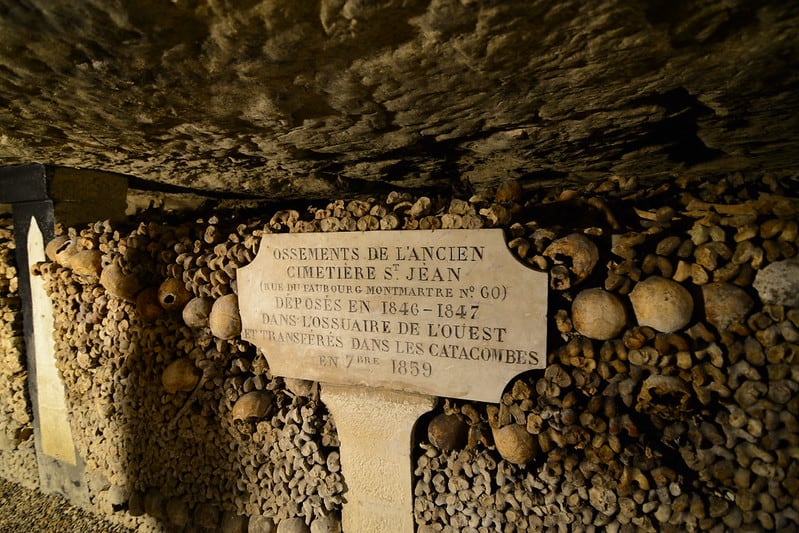
Guided tours tend to either fill up quickly and they aren’t offered as frequently, which means that you typically need to plan them out at least a month in advance.
If you don’t have the time or patience to wait, this is going to be your best option.
Here are the ticket prices for the Paris Catacombs:
- €31 per person (18+)
- Includes an Audio Guide.
- Availability: Tuesday - Sunday
- Hours: 10:15 am - 5 pm.
- Duration: 1 hour
- Purchase tickets or learn more .
Guided Tours of the Paris Catacombs
There are a lot of great companies offering guided tours of the Paris Catacombs, and this is probably one of the safest and most reliable ways to both see this part of the city and learn about its history.
Each of these outings includes admission to the catacombs and some of them provide access to areas that are usually off-limits to visitors.
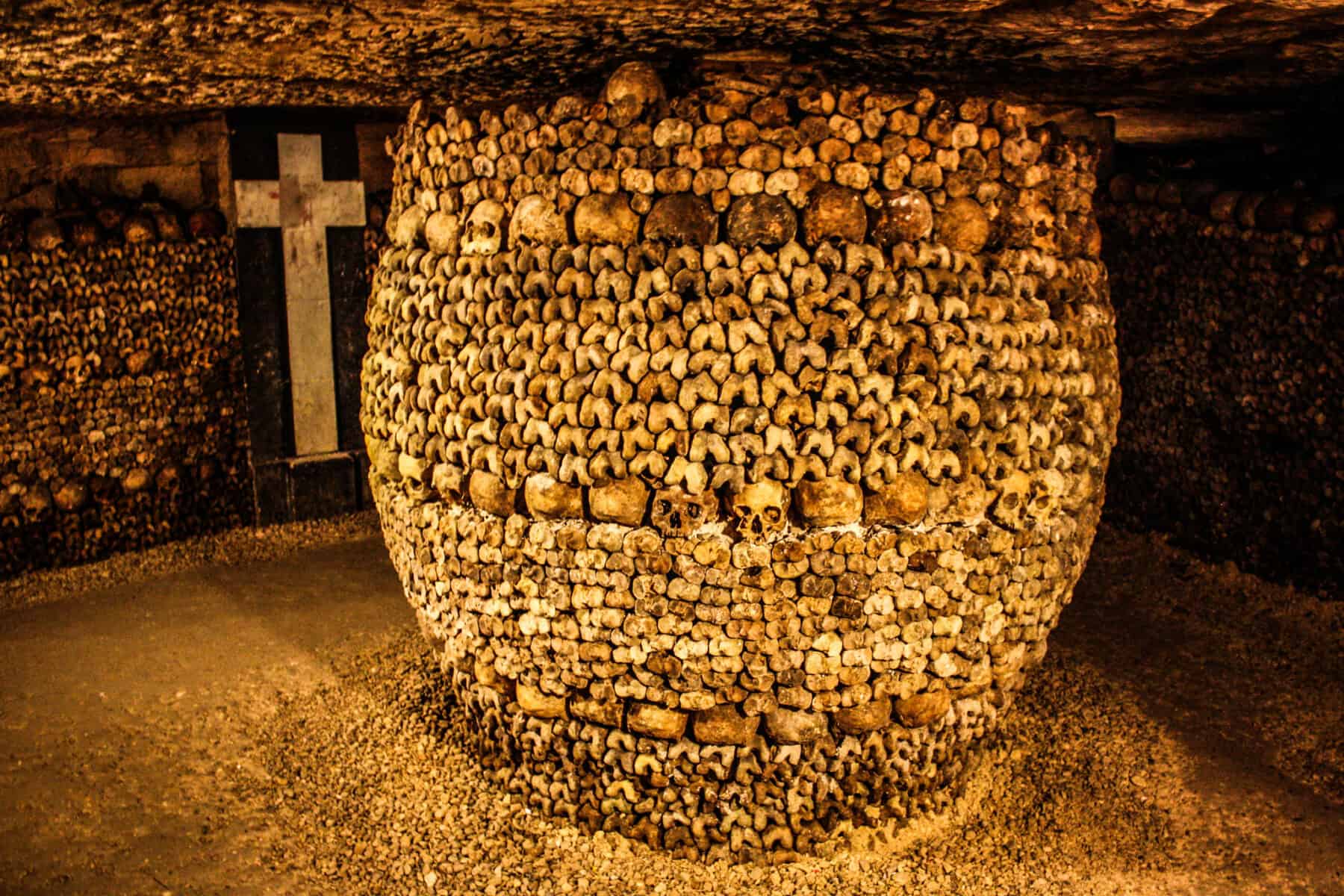
You can expect guided tours to cost anywhere from €80 - €120 on average.
Most of these tours have limited availability, and depending on when you get tickets, you may find they are only being offered a few times each month.
With that in mind, we recommend purchasing tickets at least a month in advance to avoid missing out.

This company offers a lot of excellent tours around the world and in Paris.
Their tour of the catacombs includes skip-the-line tickets, so you don’t have to worry about admission prices.
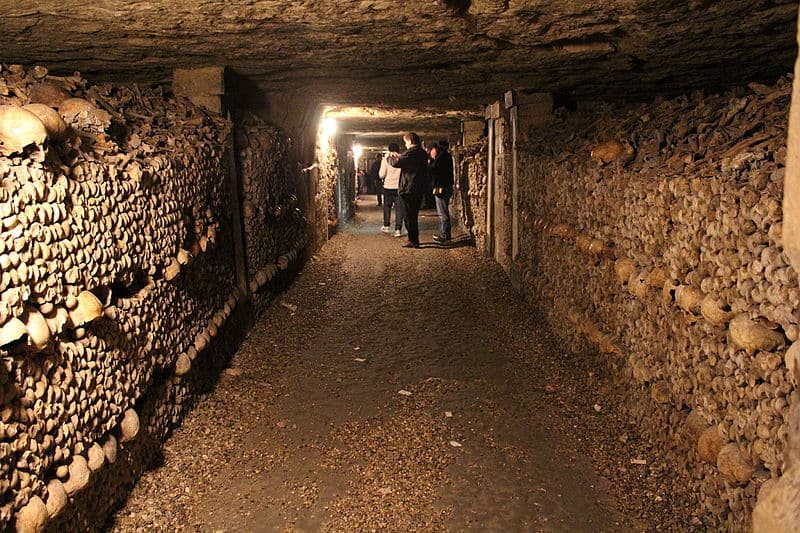
In addition to tickets for the Paris Catacombs, this outing also includes a 2 hour guided tour from a professional guide who will tell you about the history of the tunnels beneath the city and events that led to the need for these communal burial grounds.
Some of these tours start in the evening at 5 pm and run to 7 pm, which is about as close to a night tour as you’ll find from any other company.
- €168.43/Adults | €158.69/Children (2-14)
- Includes Paris Catacombs tickets.
- Availability: Tuesday - Friday
- Hours: 12:30 pm, 5 pm
- Duration: 2 hours
City Wonders (not available for now)
Much like its competitors, this company also offers several great tours in Europe, and one of its services is a tour of the Paris Catacombs.
This outing includes admission to the catacombs, so you won’t have to worry about getting tickets.
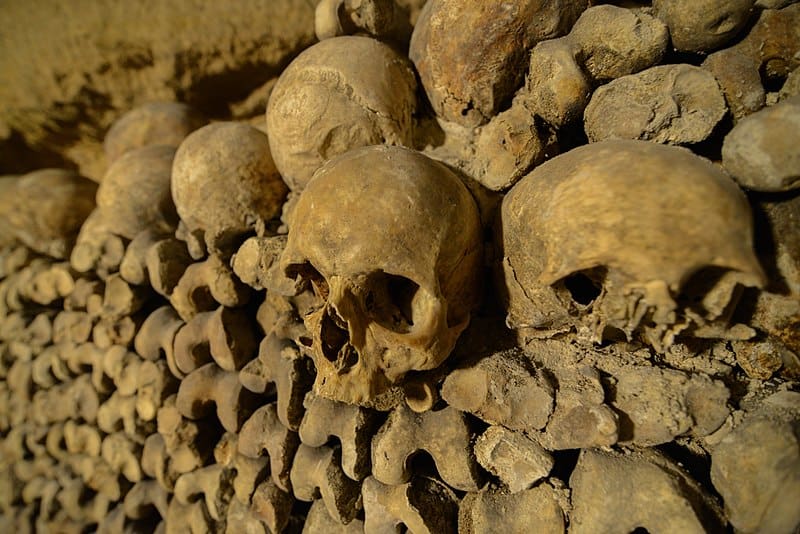
During the course of this 2 hour guided tour, you’ll learn about how the catacombs were constructed.
You will also learn details about why they were necessary and what was here before it served as the final resting place of over 6 million people.
As with their competition, they also offer tours that start at around 5 pm, so it’s a good alternative to a night tour.
- €99/Adults | €94/Children (2-14)
Memories France
This service is very similar to all the other guided tours of the Paris Catacombs, but there are a few noteworthy differences you might want to consider.
For one thing, this tour is limited to a small group of just 6 people, which means you’ll enjoy more personal attention from your guide.

You can also expect special access to certain areas that are closed off to other tour groups.
This tour is approximately 2 hours in length and it starts at either 4:30 pm or 5:30 pm, which means they are also pretty close to being night tours.
- €119.90 per person
- Hours: 4:30 pm, 5:30 pm
Voyages LLC (not available for now)
This company currently offers one of the most affordable guided tours of the Paris Catacombs.
As with their competitors, they also cover the costs of admission and provide details about the history of this location and why it was constructed.
The main difference between this Paris Catacombs tour and others is that it’s only 90 minutes in length, making it shorter than most other outings.
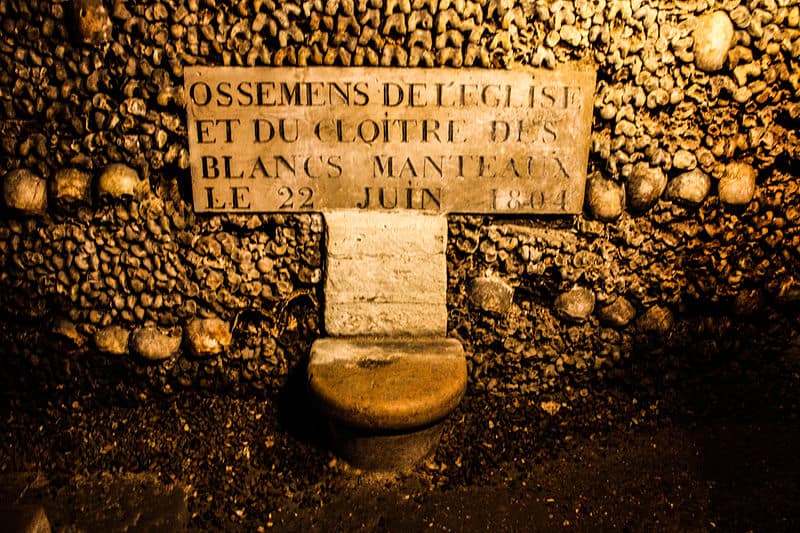
That said, if you’re looking to save money, this guided tour is an excellent option.
- €79 per person
- Duration: 90 minutes
There are a few different ways to save money when visiting the catacombs of Paris, including tourist passes, combo packages, and concession sites.
No matter which option you choose, you can expect to save between 5% - 25% on average.
Use a Tourist Pass
Although some Paris tourist passes have offered admission to the Paris Catacombs in the past, at the moment there is only one pass offering a deal on this activity: The Paris City Card.
This service includes admission to the Eiffel Tower, the Louvre, a cruise on the Seine, a Paris audio guide, and 10% off any additional attraction in the city.
The 10% off would bring the cost of a ticket to the Paris Catacombs down to about €26 per person.
Alternatively, you could also use this concession on a guided tour of the catacombs, and that could cut the cost by €8 - €12 .
Purchase the Paris City Card or learn more .
If you’re curious about how these services work, please read our full post covering Paris tourist passes .
Combo Packages
There are a few combo packages currently being offered which include admission to a Paris Catacombs guided tour and one additional activity or attraction.
Catacombs of Paris: Guided Tour + Montparnasse Tower
- Includes admission to Montparnasse Tower 56th Floor Terrace
- Includes admission to the Memories France Paris Catacombs Guided Tour
- €18/Adults | €13.50/Youth (12-18) | €9.50/Children (4-11)
- Purchase this combo package or learn more .
Catacombs of Paris: Guided Tour + Eiffel Tower 2nd Floor
- Includes admission to Eiffel Tower 2nd Floor
- €119.90 per person

Promo Sites
Both Memories France and Voyages LLC offer their Paris Catacombs guided tours on Groupon .
This website frequently offers special deals on local activities, and they usually have additional promo codes you can use to save an extra 10% - 25% off on average.
If none of the other deals are of interest, this is an excellent alternative to consider.
Children’s Deal
If you’re visiting with kids, please remember not to purchase tickets for them online .
The reason for this is that children’s tickets are sold at the front desk for just €5, which is a savings of €24!
Anyone from the age of 4 - 17 is eligible for a children’s ticket concession. The only requirement is that they must be accompanied by adults.
Keep in mind that adult tickets must be booked online .
Last Minute Tickets
If you buy tickets on the day of your visit, you might be able to score one of these last-minute tickets at the following concessionary rates:
- €13/Reduced
- Free for children under 18
The only catch is that the audio guide must be purchased separately with this concession, and it will cost an extra €5.
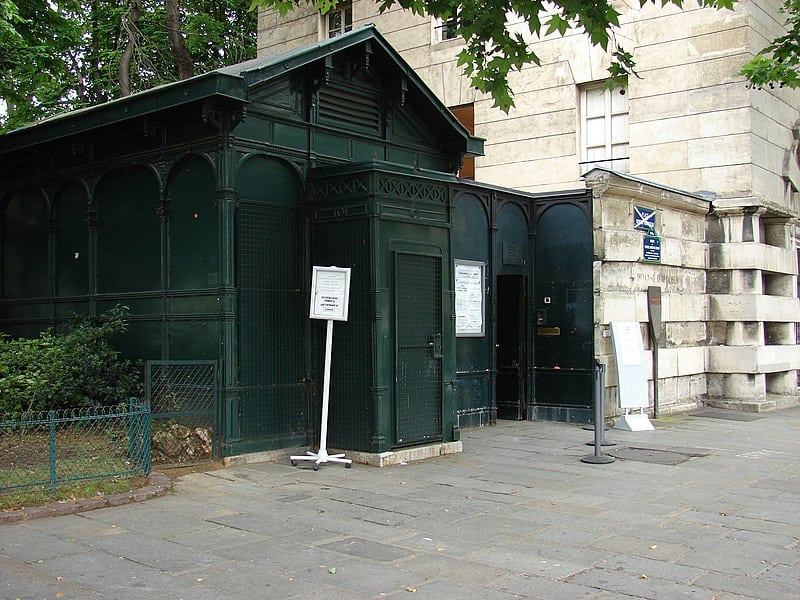
Reduced Rate
The reduced rate of €27 is available to all visitors who are 18-26 years old and/or students.
Last-minute reduced tickets are just €13. This may just be a savings of €2, but every euro counts!
Where Are the Catacombs?
The Catacombs of Paris (or Les Catacombes de Paris) are located at 1 av. du Colonel Henri Rol-Tanguy 75014 Paris.
This location is just south of the main city center, but it’s far enough that you might want to consider some form of transportation other than walking.
Take the Bus
The entrance is at the center of a pretty major intersection, so there are several bus stops nearby.
- Right across from the Paris Catacombs, you’ll find a bus stop servicing lines 38 and N21.
- There is a stop just across the street from the catacombs on av. Denfert Rochereau that services lines 38, N14, N21, and N122.
- You’ll find another stop opposite Square de l’Abbe-Migne at the corner of pl. Denfert-Rochereau and av. Rene Coty servicing line 68.
- Another stop is located at Jacques-Antoine Square, and it services lines 59 and 88.
- There’s also a bus stop across the street from Musee de la Liberation de Paris servicing lines 68 and N14.
Take the Metro
This is probably the easiest and quickest option because there’s a Metro station right next to the entrance of the Paris Catacombs.
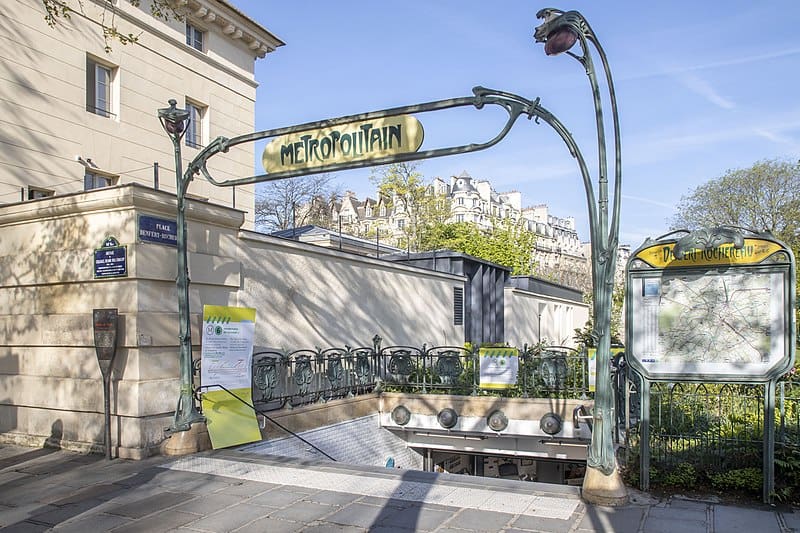
If you want to make sure you’re going to the right location, hop on Metro line 4 or 6 and head to the Denfert-Rochereau station.
For more information about public transportation in this historic city, make sure to read our full post covering how to use the Paris Metro .
Rent a Bike
Since the Catacombs of Paris isn’t too far from the city center, chances are it wouldn’t take more than 10-15 minutes to ride a bike here from sites like the Pantheon, Sainte-Chapelle, or Notre Dame.

If you are planning to get the Paris Passlib , keep in mind that it actually includes a free bike rental at no extra cost.
Consider Uber/Lyft or a Taxi
If all else fails or you don’t feel like waiting rideshare services and taxis will definitely know how to get here, and it won’t take much time if you’re in or near the city center.
FAQ - Frequently Asked Questions
Are the paris catacombs dangerous.
The Paris Catacombs, while being a popular attraction, are not typically dangerous. However, like any historical site with old structures and sculptures, they should be navigated carefully. Bones, human remains and even ossuary elements could pose a risk if not treated with respect.
Are the Paris Catacombs open to the public?
Yes, the Paris Catacombs are open to the public. The opening hours are established to facilitate visitation, but be prepared for long queues as the site is often visited by Parisians and tourists alike. It's recommended to check the latest updates on their official website for accurate information.
Can you see the Paris Catacombs without a tour?
You can explore the Paris Catacombs without an expert guide, but it's not recommended. To understand the rich 18th-century history and significant elements like the sepulchral lamp, the Empire of Death inscription or Gilbert's tomb, guidance is usually beneficial. Remember, you might need to navigate stairs and meters of labyrinth-like passages.
Are the Paris Catacombs free?
Unfortunately, the Paris Catacombs are not free. Tickets must be purchased for entry. While the cost can vary, it's important to note that the price includes access to the fascinating world beneath the city, which once were limestone quarries. Consider it a small price to pay for a unique glimpse into Paris' crypt-like underbelly.

Choose a Destination... I want them all PLUS general travel tips. Amsterdam Berlin Boston Charleston Chicago Dubai Lisbon London Los Angeles Miami Nashville New York City New Orleans Paris Philadelphia Prague Rome San Francisco Washington DC
About The Author
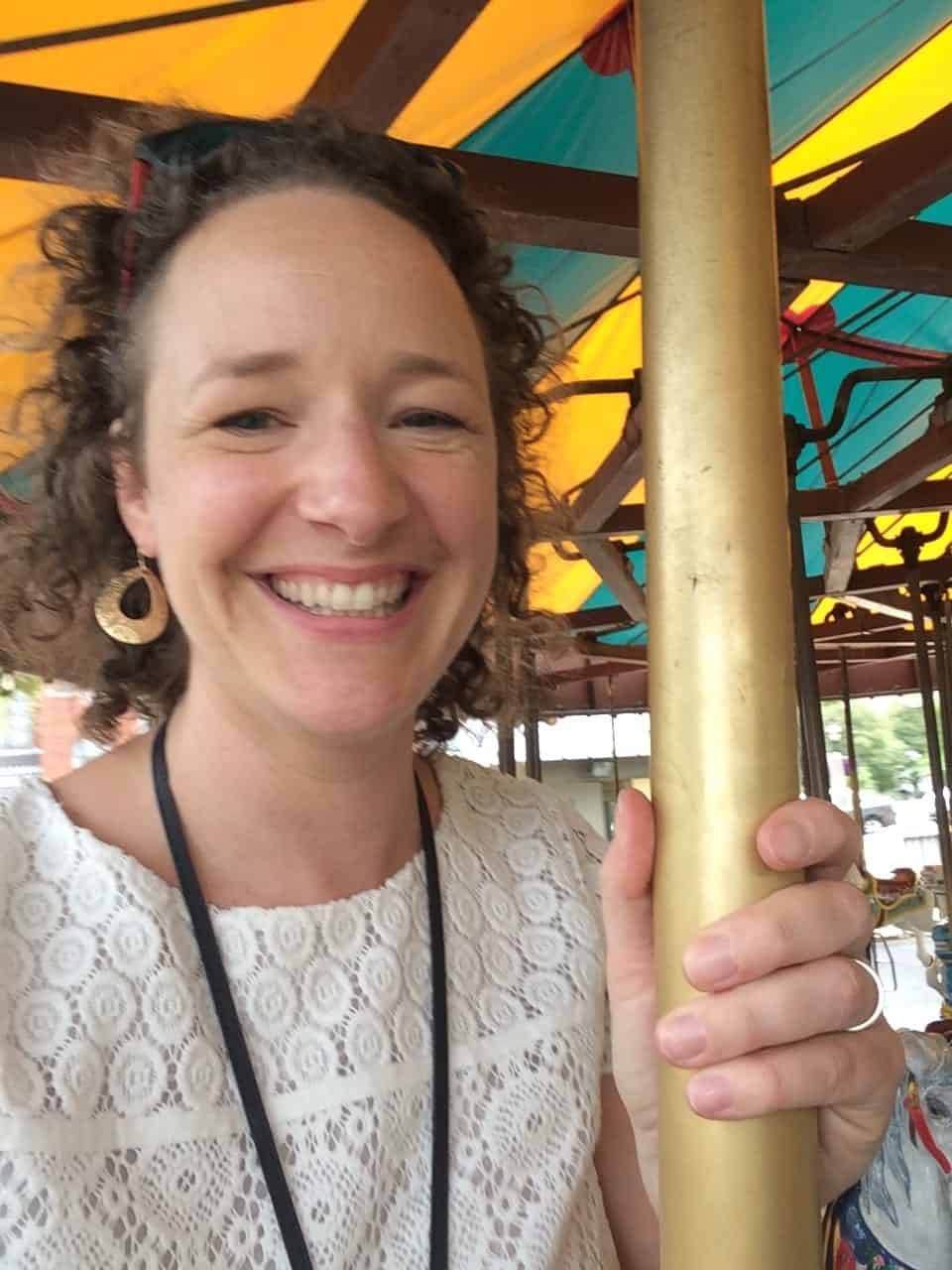
North America
United kingdom & ireland, middle east & india, asia & oceania.
%20(3).png?w=auto&h=400)
Catacombs of Paris
Overview for catacombs of paris.
Visit the famous Catacombs of Paris to witness a nerve chilling labyrinth of tunnels under the ground in the heart of the city. The complex labyrinthine ossuary was set up years ago and continues to astound visitors today with its incredibly complex maze-like network that holds the mortal remains of millions of Parisians. If you are visiting Paris with the notion of pure romance in the air, you are in for a staggering surprise. Take a tour of the dimly lit tunnels of this Parisian ossuary called the Catacombs of Paris to witness a side of the city that is certainly not for the faint hearted. It is an underground space that houses over six million bones of the deceased after a heavy storm caused the walls of a local cemetery to collapse.
The Paris Catacombs, despite its horrific history and gruesome halls that are adorned with human skeletal remains, happens to be one of the most popular albeit unsettling places of attraction here. You can take an audio-guided tour of the macabre tunnels to learn all about its history and how the construction was done, as you move along the uneven, gravel paths.
Book Catacombs Tickets Online
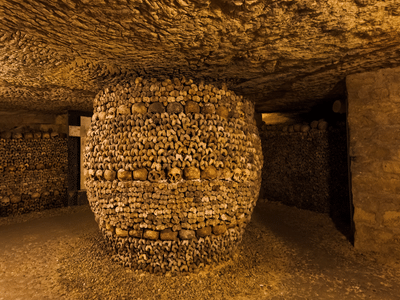
Catacombs of Paris History

The origins of the Paris Catacombs dates back to the late eighteenth century when a major catastrophic situation brought the city together to move its dead to an underground site. The groundwork was laid down in 1786 when King Louis XV passed a decree that banned the burial of the deceased in cemeteries within the city limits.
This was because the rise in population was making the city burst at the edges as it was not able to keep up with the rate of expansion. Cemeteries were beginning to get overcrowded and graves started becoming shallow. The surfaces started emanating the rotting smell of decomposing flesh as bio-fluids started oozing out of the ground. Things came to a critical juncture one night when a huge storm hit the city and incessant rainfall caused the land to collapse at the cemetery due to an overload of corpses. The dead bodies began to fall out and into the neighborhood areas when the big decision was taken to move the remains of the dead into the tunnels that ran below the streets of Paris. Overnight carts were loaded with millions of human bones and taken to the ossuary where they were stacked neatly for several kilometers, forming the Catacombs of Paris.
You can Also Checkout: Tickets for the Eiffel Tower
Things To See Inside Catacombs Of Paris

This structure is located in an area at the center of all skulls and bones within the Catacombs Of Paris, known as the Crypt of Passion. The massive eerie barrel shape holds more bones and skeletons within it and was erected in 1897 when an illegal concert featuring Chopin’s Funeral March and the Danse Macabre by Camille Saint-Saens in the middle of the night was being held here.
Must Checkout: Buy Palace of Versailles Tickets

The underground world of the Catacombs of Paris has been brilliantly organised so that visitors can cross from the upper catacombs to the lower ones with the help of a support ramp. While at most parts, the quarry was dug out only at one level, there are certain areas where the quarrymen explored the area at two different levels.
Also Read: Catacombs of Paris History

There were certain exhibits placed within the Catacombs of Paris, one of the most fascinating being the Citadel de Mahon carved out by Decure. A veteran of the French Army, he did the sculpting completely from memory of the actual structure. However, legend goes that he was killed within the very walls of these catacombs when he was trying to construct a stairway that would lead visitors to the exhibit.
Also Explore: Things to Do Near Catacombs of Paris

When you are traversing through the tunnels comprising the Catacombs of Paris, you will reach a point where you will face a winding staircase that leads to a small well. This is considered to be the first-ever geological drilling that was done in Paris, intended at seeing the geological layers of the city. You will also see a back wall here with light shining on the words that mean ‘Foot Bath of the Quarrymen’.
Plan Your Visit to Catacombs of Paris
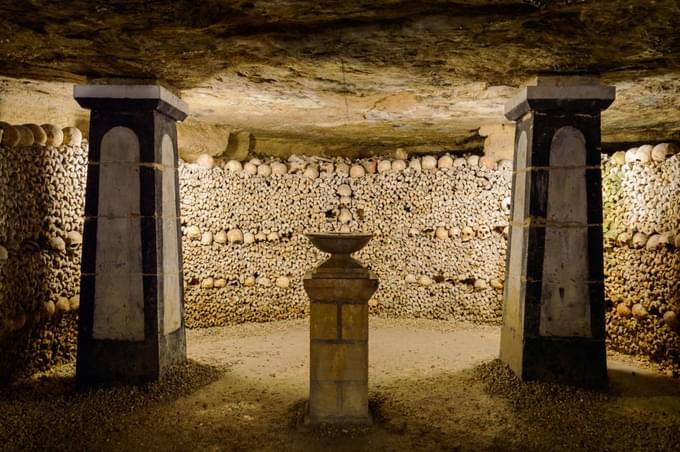
Location : 1, Avenue du Colonel Henri Rol-Tanguy (place Denfert-Rochereau), 75014 Paris
Opening hours :Tuesday to Sunday from 9:45 AM to 8:30 PMThe Catacombs of Paris are closed on Mondays and certain holidays including January 1, May 1, and December 25
This is a one way circuit that runs for a kilometer and a half and exit is at 21 bis, Avenue René-Coty.
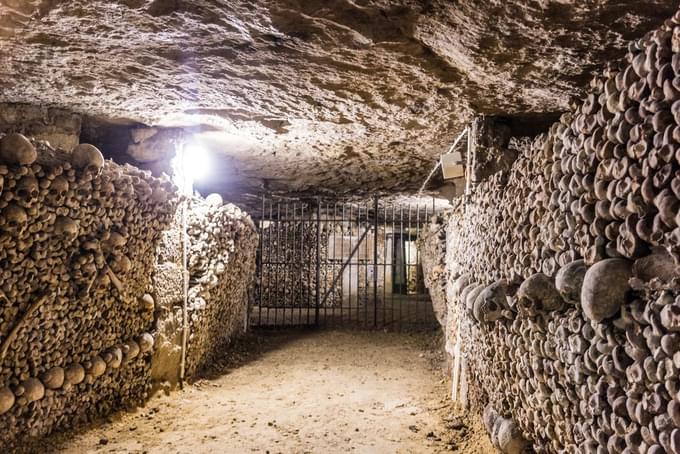
There is no coat or luggage room here and you will not be allowed to carry suitcases and large bags inside the Catacombs of Paris to ensure its safety and preservation. Visitors are allowed to carry bags that measure less than 40X30 cm. in front of the body or in the hand. There are over a 100 steps to go down, and the site is not wheelchair accessible.
The dimly lit passageways are narrow, with an uneven path that may get slippery in parts. There is a constant temperature of 14 degrees Celsius maintained within the Paris Catacomb and the number of visitors inside is limited to 200 at a time.
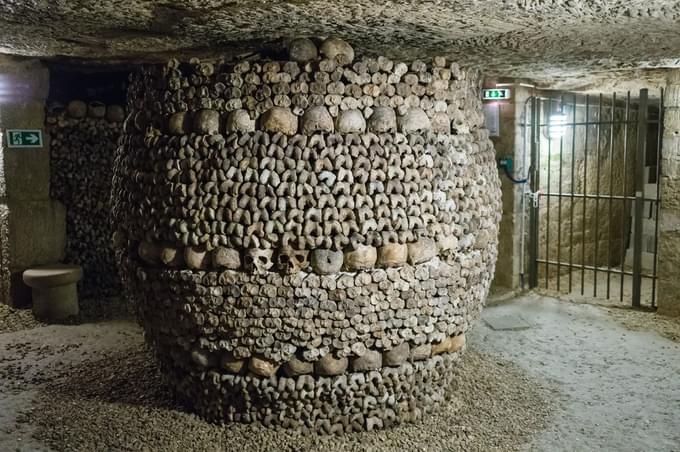
The Paris Catacombs are not recommended for sensitive individuals who may find the site disturbing, pregnant women, motor disabled, or individuals suffering from Claustrophobia, cardiac and respiratory insufficiency, etc. Individuals with mental disabilities may find the atmosphere anxiogenic and thus is not recommended for them.
Sight-disabled individuals and children who are under the age of 14 and visiting the Paris Catacomb must be accompanied by an adult at all times.
Places to visit near Catacombs of Paris

This Museum is one of the most important places of tourist attractions and a great site to visit when you are at the Catacombs of Paris. The world’s largest museum, the Louvre is housed within the Louvre Palace on the banks of the Seine. Visit Louvre Museum not only for its awe-inspiring façade and architecture, but also for the impressive collections of Egyptian antiques, Roman antiquities, Greek, Etruscan, and Islamic art, paintings, prints, and its most famous exhibit, the Mona Lisa by Leonardo di Vinci.

Head to the renowned Jardin du Luxembourg, or the Luxembourg gardens after you visit Catacombs Paris, a complete contrast to its grimness. This is the garden of the French Senate and the second largest public park in Paris inspired by the Boboli Gardens in Florence. Take a stroll around the beautifully manicured park to soak in the local vibe and the cosmopolitan air of the city amid the lush greenery of the garden. You can also catch visitors here spending a relaxed evening playing chess and even bee keeping.

This iconic structure towering high into the Parisian sky, is in all likelihood, the prime symbol that defines the country. Your visit to the city of Paris may well remain incomplete without a visit to the Eiffel Tower and so head down to the Champ de Mars area after you see the Paris Catacombs. The 300 feet marvel also has an observation deck at one of its three levels where visitors are hosted. In the evenings, the glittering light show here is an absolute marvel and one you must not miss.

Constructed in the mid-thirteenth century, Sainte Chapelle was commissioned by King Louis IX with the sole purpose of storing his collection of relics. These include important antiquities from the last days of Jesus Christ until his crucifixion, including the Christ’s Crown of Thorns that was later hosted by the Notre Dame Cathedral. You can also see in this classic Gothic structure, one of the most enviable stained glass collections in the world.

Visit the most famous religious landmarks of the city after you have seen the renowned Catacombs of Paris. Constructed by the French colonists in the late 1800s. The Notre Dame Cathedral is a classic example of Romanesque architectural features. Its distinctive red façade along with twin bell towers, stained glass windows, and a tall statue of the Virgin Mary in front, makes it stand out. It is one of this city’s most visited and beloved landmarks not only for its holy sanctity but for its symbolic importance.

Situated calmly by the banks of the River Seine, the Musee d’Orsay houses an enviable collection of Impressionist and Post-Impressionist collective art. The exquisite architecture of the building is in itself a sight to behold apart from hosting the works of famous artists including Renoir, Dali, Monet, Cézanne, Gaugin, and Van Gogh to name a few. You can witness decorative arts, sculptures, and architectural structures among its collection including several classic pieces like The Artist's Studio, Self Portrait, Starry Night over the Rhone, and Whistler's Mother, among several others.
Catacombs of Paris FAQs
Can you touch the bones in the paris catacombs.
No, you cannot touch the bones in the Paris Catacombs. This is to ensure the preservation of this ancient site which houses the delicate remnants of thousands of Parisians in the form of bones, skulls, and skeletons.
Must Read: A Guide to the Catacombs of Paris
Is it okay to visit the Catacombs of Paris alone?
Yes, you can visit the Catacombs of Paris alone, but can venture only into certain parts of it that are open to the general public. The rest of the area is closed and visitors are not allowed in these parts. Children below the age of 14 cannot visit alone and need to be accompanied by an adult. You can take a self-guided tour to find your way around. However, since the interiors are dank and dreary, it is best to travel with someone.
Also Checkout & Book: Catacombs of Paris Tickets
Are there any guide services available with Catacombs of Paris tickets?
There are audio guides you can borrow from the staff here that you can use. It will guide you along the way as well as tell you about the history of how it was constructed
Can we click pictures inside Catacombs of Paris?
Yes, you can take pictures inside the Catacombs of Paris although you are not allowed to touch the ancient remains that are housed here. Most parts of the catacomb are very dimly lit and thus you may need to use a flash when clicking pictures.
How long does it take to visit the Paris Catacombs?
The average time it takes to go through the Catacombs of Paris independently is about one hour. The walking route stretches around 2 km and consists of almost 130 stairs to descend into it.
Are the catacombs of Paris haunted?
The Catacombs of Paris look extremely grim and sinister for their very location deep underground. Moreover, most of the tunnels are very dimly lit and there have been cases where people have lost their way touring the tunnels. All these coupled with the fact that the ossuary houses millions of bones of the dead, give the catacombs a haunted vibe.
When were the catacombs of Paris built?
The Catacombs of Paris were built during the years between 1787 and 1814 after the then Saints-Innocents cemetery was closed. It took the Parisians almost 12 years to transfer all the remains of the dead into the ossuaries.
What is the best time of day to visit the catacombs of Paris?
The best time to visit the Catacombs of Paris is during the early morning in order to avoid long queues. The catacombs allow a maximum of 200 visitors within it at a time.
Attraction Tickets
Museum tickets, cruise tickets, theme park tickets, explore paris.
%20(3).png?w=auto&h=400)
The content and images used on this site are copyright protected and copyrights vests with the respective owners.
© 2024 www.thepariscatacombs.com All rights reserved.

How to Get Tickets for the Paris Catacombes

In this Post:
Where to purchase your tickets, guided tours of the catacombes: worth it, practical tips for visiting the catacombes, what about the “secret” catacombe tunnels.
The Paris Catacombes are known for their long lines to get in. No one likes wasting time in lines, right? Before Covid, people without tickets would try and get there first thing in the morning to avoid lines. But, like many popular Parisian sites, today it’s only possible to visit the Catacombes with a pre-paid ticket for entry at a specific time. The biggest risk now is purchasing an expensive (or worse, counterfeit ) “skip-the-line” ticket through a third-party reseller. To avoid headaches, the best way to visit the Paris Catacombes is by purchasing your timed entry ticket directly through the official website.

I almost ALWAYS recommend purchasing tickets for museums and monuments directly through the official website. The first reason is that it’s usually the cheapest option. The second reason is that you don’t have to go through any middlemen if there’s a problem (like strikes closing down the monument the day of your visit). And in recent years there have been so many counterfeit tickets being sold by both fraudulent online websites and in person by scammers looking for clueless tourists who showed up without reserving tickets in advance that the Paris Catacombes website now only sells tickets up to one week in advance , so you’ll have to put a reminder on your calendar before your visit. In low season, basically anytime outside of summer, you can also check their website for last-minute, discount tickets for a visit on the same day (using your smartphone if you don’t have access to a computer).
As of October 2023, the official “skip the line” tickets (including an audio guide in multiple languages) are €29 for adults, €23 for students 18-26, and €10 for kids 5-17 with an adult (they don’t get an audioguide). Purchase them at this link (scroll all the way down to “Official ticket // Catacombs”). The last-minute tickets sold online in the off-season are €13-€15, plus €5 for an audio guide, and free for kids under 18 if they are with an adult who has a ticket.
Note that kids under 14 must be accompanied by an adult.

There are official guided tours of the Catacombes, but only in French. You can find many guides online who will do tours of the Catacombes for €75-€95/person for groups of 15-20 people.
It’s up to you if it’s worth the extra cost and time to take a guided tour, but honestly, it’s one of the places I recommend simply reading up on in advance (or downloading your favorite audio tour to your phone), because there’s only one route that everyone follows, so it’s not like you’re going to miss anything or get “lost” on your own. Some of the guided tours being sold online use scare tactics in their marketing, implying you need a guide to avoid getting lost or to skip the lines: “Learn why the bones of more than six million people were deposited under the city in a complex maze of tunnels that you definitely need a guide to navigate.” Er…no, the parts open to the public are gated off so that you can only go one way. Another says “The lines at the Catacombs are very long and are known to make people wait for up to 3 hours.” This is no longer true since everyone now needs timed entry tickets. Even if you do shell out for a guided tour, as one site mentions in the fine print, you might still end up waiting if there’s a bottleneck of visitors: “Please be aware that at busy times there may be a long queue to enter the Catacombs.”

If, once you’ve read up on the history and think you’d like to spend more than an hour down there, and possibly see a few of the extra corners that are usually behind locked gates, then go ahead and splurge on a guided tour (preferably a private guide if you want to be able to ask lots of questions and get the personalized attention you wouldn’t have with a group of people you don’t know). There are several local tour companies offering reasonably-priced small-group and private tours of the Catacombes by licensed guides in English, such as Memories France .
There’s one entrance at the Place Denfert Rochereau (specifically 1 Avenue du Colonel Henri Rol-Tanguy) right across the street from the Liberation of Paris Museum and the main entrance to the Denfert-Rochereau metro station. The exit and boutique are actually a few blocks down the street, at 21bis Avenue René-Coty.

- There are 131 spiral steps going down at the entrance and another 112 stairs going back up at the end. The Catacombes are not wheelchair accessible, nor adapted for anyone with mobility issues. The official website also says the site is not recommended if you’re pregnant, have claustrophobia, or suffer from cardiac or respiratory conditions.
- Normally the 1.5-kilometer circuit of the Catacombes takes about 45-minutes to walk through while listening to the official audio guide, unless you’re taking your time on lots of photos or listening to anecdotes on your own audio tour. The guided tours are usually about two hours. It’s a one-way circuit, so you can’t just wander around (or, as mentioned above, get “lost”).
- It’s usually quite cool down there, 14°C/57°F.
- The lighting is quite dim in many places. Seeing eye dogs are allowed, but not white canes.
- There are no bathrooms until you reach the end of the visit, and there is no coat check nor baggage storage. Strollers, bags larger than 40cmx30cmx20cm, motorcycle helmets, and tripods are not allowed.
- You’re not allowed to eat, drink, or smoke in the Catacombes. You’re also not allowed to touch anything, but I hope none of the Secrets of Paris readers need to be told that. 😉
- Even though you have to purchase a timed-entry ticket, you’ll find the Catacombes the least crowded in the first and last hours of the day (so don’t hesitate getting the 7pm entry ticket if that time works for your schedule).
Paris Catacombes 1 Avenue du Colonel Henri Rol-Tanguy (Place Denfert-Rochereau), 14th Metro/RER Denfert-Rochereau Opening hours are Tuesday-Sunday 9:45am-8:30pm (last entry 7:30pm). Closed Mondays and on January 1, May 1, and December 25.

Finally, a short note to remind readers that even though there are tunnels extending much further under Paris (and many people who love to share stories of sneaking into them for “parties”), it’s only legal to visit the ones that are open to the public or with an official guide. I don’t recommend participating in illegal “tours” of them any more than I advocate breaking into museums or shoplifting. If you’re curious about them, however, you can learn more in Scott Carpenter’s article, Creeping Beneath Paris .
Share This Secret:
- Click to share on Facebook (Opens in new window)
- Click to share on WhatsApp (Opens in new window)
- Click to share on Twitter (Opens in new window)
- Click to share on LinkedIn (Opens in new window)
- Click to share on Reddit (Opens in new window)
- Click to email a link to a friend (Opens in new window)

You may also like

Val-de-Grâce: From Royal Abbey to Military Hospital to Museum

Insider Tips for Attending the Annual Ball of Versailles

Hôtel-Dieu: Visit One of the City’s Best-Kept Secrets Before It’s Too Late

Itinerary: Secrets of the Bastille & the Faubourg Saint-Antoine District
23 comments, have something to say join the conversation cancel reply.
What time do the tickets go on sale for the week before?
Is it worth the extra money to pay for the special access or private guide tour? Or is the audioguide the way to go?
Hi Gab, It actually takes 1-1.5 hours to just walk through the space (entrance and exit are in different places). So you could simply split off from the group and continue on your own to leave earlier, just tell your guide when you have to go. :-)Regards, Heather
Hey! This was so helpful! I want to see the catacombs desperatly but i only have two hours. Guided tours are 3 hours long but the website says differe t. How long can it take to go through the cataombs?
Seeking confirmation/clarification, and Quick question – so we book tickets on the museum site http://b12-gat.apps.paris.fr/Offres.aspx, for date and time. Confirmation, we book the skeleton story? Also we have 2 adults and 2×17 year olds, it says they are free if under 18, but how do I book tickets for them? There is a comment of: T. Young Cup file without audioguide 4-17 years included, is this what I click for my teens?TIALinda
I created an account and although I was able to translate to English, I somehow ended up purchasing under "group". They had me elect myself the leader of the group and they charged me 30 per person in the group as well as a 30 group charge. What does this mean? Will we still have access to the audiobooks? Will we get skip the line priority???
Hi, do you need to get tickets ahead of time to get into the catacombs, or can you just buy them at the place? Do they often sell out for the day, or is it just a really long wait?
Hi Oscar, you've got the right ticket. Go to the front of the line about 15 minutes before your scheduled time with your printed ticket voucher. There are indeed only a certain number of people allowed in at once.
Luckily, I found this website. I finally purchased my tickets. Yes!!! All the trip advisor tours were sold out for the date I wanted. Just confirming this is for the actual tour inside the Catacombs, correct. My ticket says "Catacombs Skeleton Story". It does mention where to go or meet at my scheduled time. I'm assuming just go to the front of the line. There's plenty of spaces left for the noon and afternoon. Isn't this place limited to a number of people visiting? Please advise.
The catacomb website says there is a disturbance and is not currently selling tickets. Does anyone now if this is temporary or are tickets sold out and they're just trying to move folks around to accommodate the situation.
Hi, I've just purchased my tickets through the official website with the help of google translator. On the ticket it says in french 'attention vous ne pourrez plus rentrer 30 min apres le debut' which translates to 'be careful you will not be able to return 30 minutes after the start'What exactly does that mean? I've booked the 1400-1600 timeslot.
I'd get there about ten minutes before 4pm. 😉
Hi, I got my ticket using the website above. I did have to keep using the translator to read what it said in English. I think I did the same when I got the email so I had a way of printing the ticket. So, my ticket says 4:00pm – 6:00pm. Does this mean I can go anytime after 4:00pm or do I need to be there right at 4:00?
You can also purchase the front of the line tickets directly from the Catacombs website now for $29 USD per adult. It is a timed entry, with skip the line status. It seems to be the same as what's mentioned in this article, but easier to do. The website is mostly English.That website is: http://www.catacombes.paris.fr/en/homepage-catacombs-official-website
So I went to the Museum site, I created an account, and the only choice it gave me to book was the Skeleton Story – and tickets were 5 Euros each – the line said children 5-17 included? I didn't purchase because I cannot quite tell if this is the right thing or if I am only purchasing the Audio guide? Any thoughts? Thanks.
Hello,Does anyone know a good place to store a bag nearby? It says that it doesn't have a place at the site itself.Thanks!
I just want to let you know, I used the whole "french site audio tour" thing in September last year and it worked like a charm! I definitely recommend it to those who want to avoid lines.
Hi,Must of the questions here are about whether or not you get to skip the line if you have a purchased a ticket online and have a set entry time.And the answer is – yes! You can simply go to the front of the queue a few minutes before your scheduled entry time. The tombs are not the most organized, so you may have to wave someone down but usually you can just go to the front desk person and show them your entry ticket.And yes, they do email you your entry ticket once you've booked it. But you can also log back into the account you've created with the museum (you create an account when you purchase the tickets) and download them at any time from there.Enjoy!TomasAeon Tours
Hi,I noticed there are some updated information but wanted to make sure. The catacombs you can purchase individual tickets in advance now for a specific time slot. If you purchase the tickets in advance will there still be a wait and is there a different queue for ticket holders?Thanks.
Hello Jim, When you purchase tickets it's for a specific time, so you don't wait in line, you show up at that time (15 minutes early would be smart). I don't know if they email you a confirmation, but I'm guessing that is how it works. Try and print it off to be sure.
Two quick questions. I have created an account with the museum's website (thank you Google translator!). Before purchasing our tickets, however, I'd like to confirm … with pre-purchased tickets, do you get to skip the line when you arrive at the site? AND do they EMAIL you your tickets upon purchase? If you happen to know, please, feel free to email me? Thanks.
A few years ago it was fashionable to have parties in the Catacombs, reached by entering through certain manholes but I suppose these are now all locked up. Tis a pity. Or should I call it a boner?Barney Kirchhoff
Heather, thought you'd like to know something I inquired about recently at the Catacombs. They no longer want long lines of people waiting, so if the line extends beyond a 20 minute wait, they now hand out coupons with a return time to those waiting in line. You return at that time and will wait less than 20 minutes for entry (similar idea to a Disneyland FastPass). I'm not sure when they began doing this, but I heard about it in December and confirmed with staff when I passed by in January. I should have asked if you can choose your return time, which would be helpful for people trying to fit in multiple venues in a day.
Discover more from Secrets of Paris
Subscribe now to keep reading and get access to the full archive.
Continue reading

Get the free Secrets of Paris Newsletter for the best insider tips delivered directly to your inbox each month.
Thanks, I’m not interested
- NUEVO : Free Tours en París

- Ahorra tiempo ! entradas cortafilas
- Alojamiento : Mejores Zonas de París
Las Catacumbas
- Cementerios de Paris
- Visita : 2h
- Distrito 14 de París
Comprar tickets y entradas
- Precio de taquilla, sin intermediarios.
- Pasa directo, evita las filas.
- Cancelación gratuita.
Las Catacumbas de París son cada vez más frecuentadas y se trata de uno de los sitios turisticos de paris más solicitados por los viajeros de paso que buscan conocer otros lugares menos famosos que los clásicos monumentos y museos.
Se trata del mayor osario subterráneo del mundo de casi de 1,7 kilometros de largo, a 20 metros de profundidad. Se trata del cementerio más importante de París en cuanto a cantidad de restos humanos.
Llegas pronto a parís ?
- Imprescindible para pasarlo bien en París.
- Visitas Guiadas y Gratuitas.
- Paseos en español.
- Inscríbite ahora y reserva tu lugar.
Alternativo y misterioso, te va a encantar si buscas lugares fuera de lo común.
Las catacumbas, son antiguas canteras subterráneas de finales del siglo XVIII en donde se han puesto millones de huesos humanos de antiguos cementerios de Paris. Ante todo … si sufres de claustrofobia o si eres muy sensible, no vayas a pisar este lugar.
Dicho esto, te apuesto que te cautivará por su originalidad !
El paseo por las catacumbas puede ser muy interesante ya que nos muestra una cara de Paris totalmente desconocida.
El osario más grande del mundo
Abiertas al público en 1809, las Catacumbas de París logran atraer 600 000 visitantes por año. Situadas a 20 metros de profundidad y con una superficie de 11.000 m2, estas galerías representan el mayor osario urbano del mundo.
Sin embargo, la parte que se puede visitar sólo mide 1,7 km, es decir, el 0,5% de la superficie total de la totalidad de los subterráneos parisinos.
La historia de este sorprendente lugar comienza a finales del siglo XVIII pocos años antes de la Revolución por el problema de falta de espacio en los cementerios que sufrían de superpoblación.
Durante más de diez siglos, millones de cadáveres se habían amontonado en pequeñas parcelas a la altura de la ciudad y su peso, que se había hecho demasiado grande, empezaba a hacer ceder los tabiques, las paredes e incluso los suelos circundantes.

Un laberinto de túneles de piedra caliza y muros de cráneos
11.000 m2, 1,7 km de recorridos visitables, 20 metros de profundidad y 6 millones de seres humanos… 110 años después de su apertura al público, las cifras de las Catacumbas siguen siendo tan impresionantes como siempre y cada año cerca de 600.000 visitantes se sumergen en las entrañas de Paris para descubrir este increíble lugar.
Orígen de las Catacombes
En 1780, toda una sección de la fosa común de los Inocentes, el cementerio más grande de la capital, localizado en pleno centro de Paris, se derrumbó.
Varios colapsos sucesivos empezaron a provocar importantes problemas de salubridad.
Las autoridades alertadas, para evitar un principio de epidemia, decidieron trasladar los cadáveres y restos, fuera de París y bajo tierra para evitar nuevos derrumbes.
El lugar elegido fue la antigüa cantera de la Tombe-Issoire , en el subsuelo de Montrouge y en el actual distrito 14.
En pocos años, los millones de cadáveres del Cimetière des Innocents fueron trasladados al entonces llamado Ossuaire Municipal de París .
En las décadas siguientes, se añadieron millones de huesos más a medida que se cerraban los distintos cementerios parroquiales de París.
No pasó mucho tiempo antes de que las Catacumbas, que llevan el nombre de las catacumbas romanas, se convirtieran en una de las atracciones estrella de la ciudad luz .
En 1809 se abrieron al público con cita previa y las mayores personalidades de la época se apresuraron a descubrir bajo tierra los millones de restos humanos cuidadosamente ordenados por tipos y formando decenas de paredes y esculpturas de huesos.
Fotos de Instagram #catacumbasparis

Recomendaciones de visita
- Para visitar las Catacumbas, no dudes en llevar tenis o calzados deportivos con suela de goma.
- El uso de zapatos tanto para hombres como para mujeres es fuertemente desaconsejado debido a la humedad reinante y el riesgo de resbalar.
- No es recomendado para todo el mundo ya que puede impresionar a los niños más pequeños.
- Se desaconseja la visita a las personas que sufren insuficiencia cardiaca o respiratoria, a las personas sensibles y a los niños menores de 14 años.
- Te recomiendo, si quieres evitar esperar 2 y hasta 3 horas delante de la entrada, llegar de mañana unos 20-30 minutos antes de que abra para evitar la cola. Trata de llegar de mañana a las 08h45 – 9h00 !
- El lugar es húmedo y fresco asi que lleva un abrigo aunque sea liviano. Al final una pequeña boutique te propone curiosidades relacionadas con el lugar.
Dónde quedan las catacumbas ?
Cómo llegar ?
- Metro :Denfert-Rochereau
- Todos los días de 10h a 17h, excepto lunes y días feriados.
- Cierre de las taquillas a las 16h.
Lugares Similares

Paris Travel Guide
Last Updated: March 1, 2024
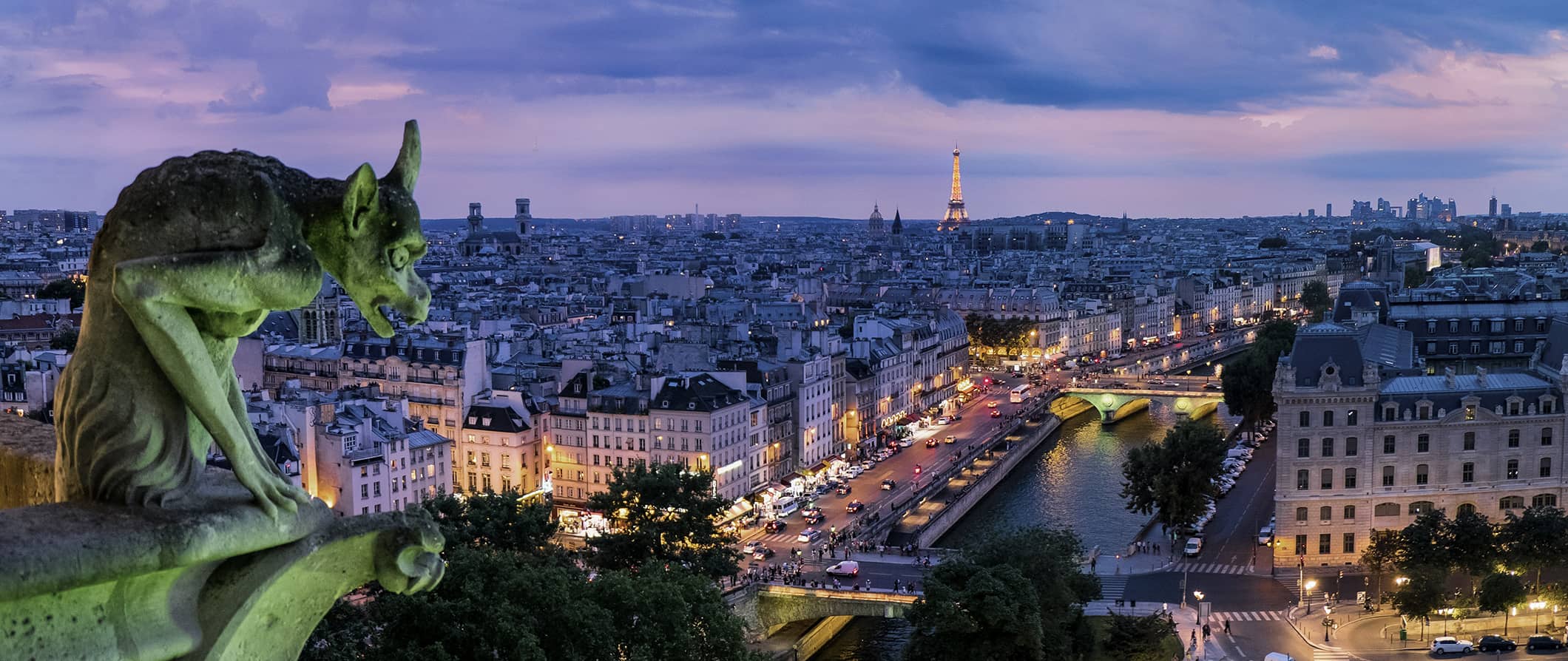
Paris. Poets, artists, playwrights, writers, journalists, and more have all written about their love of this city. It’s a place that exudes culture, sophistication, class, and style. Like the millions before me, I fell in love with this city the first time I visited.
Settled by Gallic tribes around the 3rd century BCE, the region was conquered by the Romans a couple of centuries later, turning it into a prosperous settlement. By 508, Paris was made the capital of the Merovingian dynasty. The city was sacked by Vikings in 845 but recovered to repel further Viking incursions. By the 12th century, Paris was the economic and cultural hub of all of France.
Today, Paris is one of the few iconic cities in the world that truly lives up to its hype. I’ve spent years visiting the city, have organized tours here, and even lived here for a bit. It is one of my absolute favorite places in the world. As Hemingway said, “If you are lucky enough to have lived in Paris as a young man, then wherever you go for the rest of your life, it stays with you, for Paris is a moveable feast.” He wasn’t wrong.
As iconic as it is, Paris is also gigantic, with thousands of years of history and a plethora of things to see and do, from world-class museums to Disneyland Paris . It would take a lifetime to explore it all. Fortunately, with a little planning, you can see the highlights over just a few days.
This travel guide to Paris can help you plan your trip, save money, and make the most of your visit to the City of Light!
Table of Contents
- Things to See and Do
- Typical Costs
- Suggested Budget
- Money-Saving Tips
- Where to Stay
- How to Get Around
- How to Stay Safe
- Best Places to Book Your Trip
- Related Blogs on Paris
Top 5 Things to See and Do in Paris
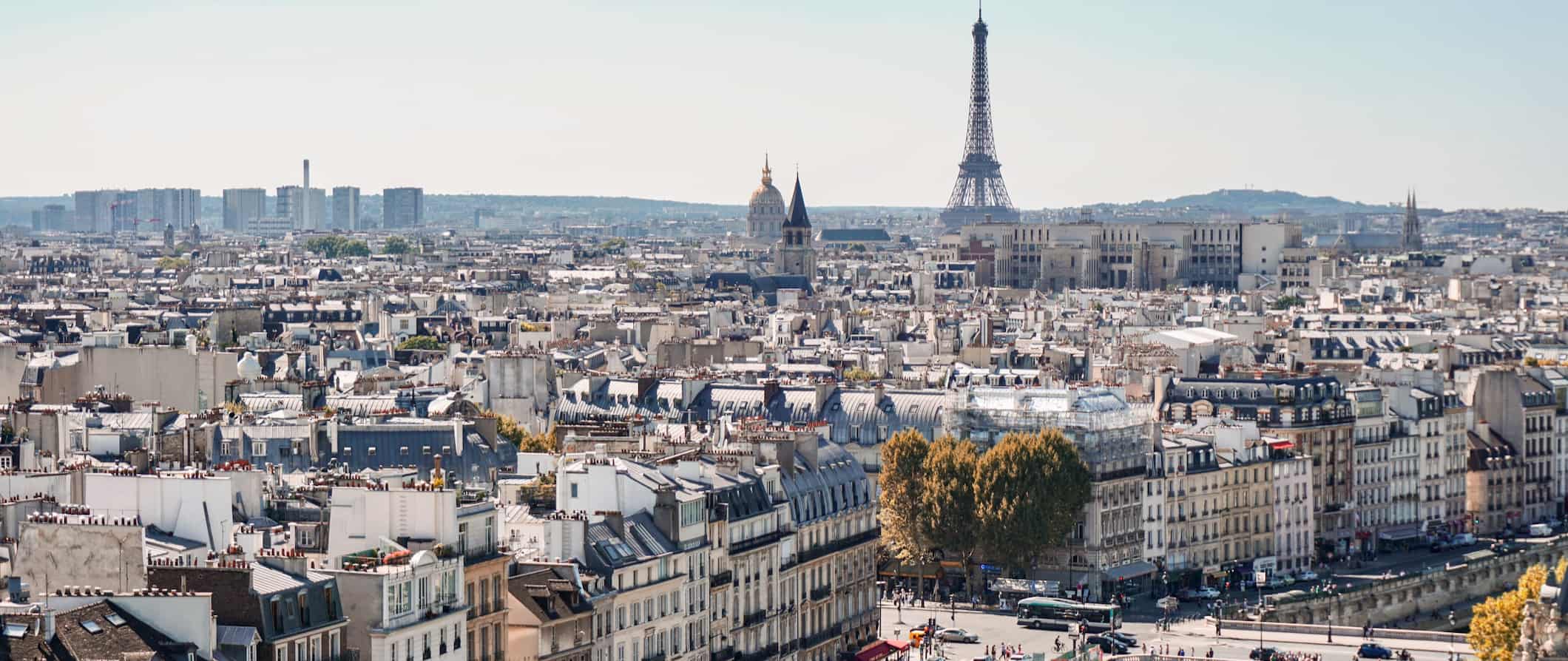
1. Scale the Eiffel Tower
Built for the 1889 World Fair, the 300-meter tower is an engineering feat that was originally hated by locals. They called it “the metal asparagus” and hoped it would be torn down. Now, it’s the most famous symbol of the city and every local will tell you they love it. It’s a beautiful building. If you’re going to go up to the top, get there early to avoid the lines. Tickets range from 16-26 EUR but I strongly suggest paying for direct access via an elevator that takes you to the top. It’s worth spending the money on as the line can take upwards of an hour on busy days. You can also get joint Eiffel Tower and river cruise tickets which help you save if you plan on doing both activities. Post-COVID, I would get your tickets in advance because the crowds and lines for tickets are really long.
2. Tour the Palace of Versailles
Visiting the famed 17th-century palace requires a whole day (don’t skip Marie Antoinette’s home or the spacious gardens that are located here). Originally, a hunting lodge, Louis XIV built this opulent palace to get the nobles out of Paris so they wouldn’t plan any coups. It was expanded over the years and filled with tons of allegorical statues and symbols reminding people that the power of the state rested with the king! The palace gets super crowded so try to go during the weekday, though summer weekends are the best time to visit the gardens, as the fountains are set to music then. Admission to the palace is 18 EUR and admission to the entire complex (including the gardens) is 27 EUR. For a more in-depth experience, this Versailles tour is led by a local expert guide and includes round-trip transportation from Paris at a time that avoids most of the crowds.
If you want to beat the crowds (which I highly recommend), skip-the-line tickets are available for 55 EUR. Since upwards of 10,000 people visit per day, skipping the line will save you a ton of time. The wait to get tickets can last hours.
3. Explore the Louvre
The Louvre is the biggest museum in the world, with thousands of square feet of space and millions of artifacts and works of art (including the Mona Lisa and the Venus de Milo). To see it all, you need at least two full days, but you can do the highlights in a full afternoon (especially if you take the Louvre Highlights Tour , which includes skip-the-line entry). Admission costs 17 EUR, while timed skip-the-line tickets are an additional 17 EUR. Due to capacity restrictions, you MUST get your ticket in advance. They sell out these days so if you don’t get your ticket in advance, you run the risk of showing up and being denied entrance.
Moreover go on Wednesday night when the museum is open until 11pm. There’s hardly anyone there after 7pm.
4. Wander the Latin Quarter
A historic area near Notre Dame, the Latin Quarter is filled with tiny, winding streets that turn at weird angles to open into little cafe-lined squares. I love wandering around here; it always feels like you’re stepping back a few hundred years in history. There are a lot of restaurants, bars, and jazz clubs here too. If you’d like to learn more about the area, this in-depth walking tour meanders through the Latin Quarter and includes skip-the-line tickets to the incredible Sainte-Chapelle, my favorite church in the city (read more below!). The tour is a perfect way to connect with a local guide who can share their insider tips and help you make the most of your visit.
5. Visit Sainte-Chapelle
This is my favorite church in Paris. Built in 1238 by Saint Louis, it was meant to house holy relics he found during the Crusades as well as serve as the Royal Chapel. I find this tiny Gothic chapel to be far more beautiful than the nearby Notre Dame. The (mostly) original interior décor is exquisite, including some of the few remaining examples of original stained glass in France. It’s absolutely beautiful. Entry costs 11.50 EUR and is likely to sell out so book your ticket in advance . Ticket holders skip the line too!
Other Things to See and Do in Paris
1. go museum hopping.
Paris has hundreds of museums worth seeing. Make sure to check out the Musee D’Orsay for great impressionist work, the amazing Rodin Museum, Holocaust Museum (one of the best in the world), Musee D’Orangerie (more impressionist work), and the interesting sewer museum. A Paris Museum Pass is the most affordable way to see them all as it provides access to over 50 museums in Paris and the surrounding region. A two-day pass costs 52 EUR, a four-day pass costs 66 EUR, and a six-day pass costs 78 EUR. It’s a must if you’re going to see at least 3 museums while in the city. Get it, save money, and (importantly) get to skip all the long lines that plague the city these days.
2. Stroll down the Champs Elysees
This is one of the most famous streets in the world and stretches from the Arc de Triomphe to the Louvre. It’s lined with expensive shops and restaurants and is always busy, but it’s a great place to club hop at night or shop during the day. Come in the very early morning to see the place utterly deserted. It makes for great photos. You can also take a guided tour if you want to learn more about the street and its history.
3. Visit the Panthéon
Located in the Latin Quarter, this Neoclassical building was originally built as a church but was turned into a state burial site for France’s heroes, including Marie Curie, Victor Hugo, Jean-Jacques Rousseau, Louis Braille, and Voltaire. Admission is 11.50 EUR . Like everything else, you’ll want to buy a ticket in advance to avoid the lines.
4. Relax in Jardin Du Luxembourg
The Jardin du Luxembourg (Luxembourg Garden) is the largest public park in Paris, covering 56 acres. The garden, which was first created in 1612, contains over a hundred statues, monuments, and fountains, all scattered throughout the grounds. The park was neglected for years until the French Revolution, after which Jean Chalgrin (the architect of the Arc de Triomphe) set about restoring and expanding the park. In the morning, you’ll see lots of runners exercising here. At lunch on a nice day, join park-goers in having a picnic.
5. Admire the view from Montmartre
Home to starving artists for over a century (since the Belle Époque in the 19th century), the neighborhood of Montmartre offers a stunning view of Paris, arty cafés and bars, cobblestone streets, and the only winery within the city limits (Vignes du Clos Montmartre). It’s one of the hipper parts of Paris, even if it has lost some of its old grandeur. It’s great for those wanting to visit the hangout spots of folks like Hemingway and Gertrude Stein. The iconic Sacré-Cœur basilica sits at the top of the hill. Climb the steps or sit on the sloping lawn and admire the views at dusk. Entrance to the basilica is free.
If you want to learn more about this iconic neighborhood, guided walking tours are the best way to do so (there’s a lot of history in this area and all the signs are in French) and include a visit to the basilica.
6. Visit Notre Dame
Paris’s Gothic masterpiece was constructed between 1163-1334. Climb from the north tower to the south to appreciate the masonry and get a close-up view of the Gallery of Chimeras, the fantastic birds and beasts gazing over the balustrade. The outside facade has been cleaned up in recent years, but the inside has a bit of that old Gothic grimy charm. To climb the tower, it costs 10 EUR. NOTE: Notre Dame is currently closed due to the 2019 fire.
7. Stand under the Arc De Triomphe
This monument stands in the center of the Place Charles de Gaulle and is one of the most famous landmarks in Paris. Inaugurated in 1836, the arch is dedicated to those who died in the French Revolutionary and Napoleonic Wars. For 13 EUR, visitors can climb 284 steps to the top of the Arc for stunning panoramic views and information about the city’s history. I think it’s one of the best views – and photo spots – in the city.
8. Celebrate Bastille Day
Every July 14th, a series of spectacular events in Paris celebrates the infamous storming of the Bastille during the French Revolution. The Bastille was a medieval armory and fortress and represented royal authority in Paris. Its capture was one of the biggest milestones of the Revolution. These days, there’s a huge televised parade and a never-ending fireworks display (head to Champ de Mars or the Jardins du Trocadéro for the best views of it all).
9. Experience the Cinema en Plein Air
Every July and August, Paris rolls out an inflatable screen in the Parc de la Villete for this major outdoor cinema event in the 9th arrondissement. It’s hugely popular with locals who tend to bring food and wine! It’s free to attend too.
10. Visit Maison du Victor Hugo
This beautiful apartment dates to 1605. Its most famous resident was the writer Victor Hugo (author of Les Misérables and The Hunchback of Notre Dame ), who moved here when he was 30. His old apartment is now a museum dedicated to his life and writing. The museum is quite small, but Hugo lovers (like me) will find it very interesting. Each room is designed to showcase a specific period in his life, from his childhood to his death. Admission is free.
11. Climb through the Paris Catacombs
Underneath the city of Paris, you’ll find a honeycomb of tunnels, originally constructed as mining tunnels. The French resistance used these tunnels during World War II and rave parties flourished there during the 90s. Within this maze of tunnels lie the famous Catacombs of Paris, an ossuary containing the remains of over 6 million Parisians. This burial site was created in the 18th century due to public health concerns about overflowing cemeteries. It’s one of the freakiest and coolest sites in Paris. This walking tour with a local historian includes skip-the-line access (lines can regularly stretch around the block), while last-minute tickets cost 14 EUR, when available (they are often sold out, however).
12. Listen to Paris’ famous jazz music
Whether you prefer modern clubs or classic jazz joints, you shouldn’t leave Paris without tasting the music that attracted some of the best musicians and artists to the city. There is an especially abundant amount of good jazz clubs in the city. Le Duc des Lombards, which opened in 1984, is one of the most famous jazz clubs in the city. Harry’s Bar also has a lot of great music there too.
13. Take a walking tour
There are dozens upon dozens of companies covering all aspects of life in Paris, and it can be hard to make sense of all those endless Viator and TripAdvisor listings. Some are free, like New Europe’s tour, and go around the center of Paris, giving a historical overview of the city. Walks offer amazing in-depth tours starting from about 55 EUR. You’ll get specialized guides and skip the lines to big attractions, like the Louvre. I wrote a whole guide to the best walking tours in Paris!
14. Walk amongst the tombstones
The Pere-Lachaise Cemetery is Paris’ largest and most famous cemetery. In fact, it’s the most visited cemetery in the world and a peaceful, hauntingly beautiful area worth exploring. Look closely to spot the famous graves (Jim Morrison, Chopin, and Oscar Wilde are all buried here.) The cemetery was built in 1804 but locals considered the cemetery too far from the city. For that reason, Père Lachaise only had 13 graves its first year, however, administrators devised a plan to transfer the remains of Jean de La Fontaine and Molière, two of Paris’s most famous artists, to Père Lachaise. After that, everyone wanted to be buried here! You can read more about the cemetery here .
If you want, take a guided tour of the cemetery . You’ll learn a ton and won’t miss out on the most popular (and interesting) tombs. There’s no signs here so, without a tour, you won’t really learn much.
15. Visit the Mémorial de la Shoah
Despite having an excellent exhibit on France, anti-Semitism, and the Holocaust, the Mémorial de la Shoah never draws a lot of people. It’s a real shame, as there is a lot of in-depth information and a great collection here. I’ve been to many Holocaust museums, and this is one of the best and most detailed in the world. I highly recommend it. Admission is free.
16. Take a food tour
To learn more about the history and culture behind Parisian cuisine, take a food tour. It’s the best way to eat your way around the city, sampling the best eats Paris has to offer, all while learning what makes the cuisine unique. Devour Tours runs in-depth food tours led by expert local guides that will introduce you to the food culture and its history. If you’re a foodie like me who wants to learn more about the history and culture behind each dish, this tour is for you! Food tours range from 89-109 EUR.
For more information on other cities in France, check out these guides:
Paris Travel Costs
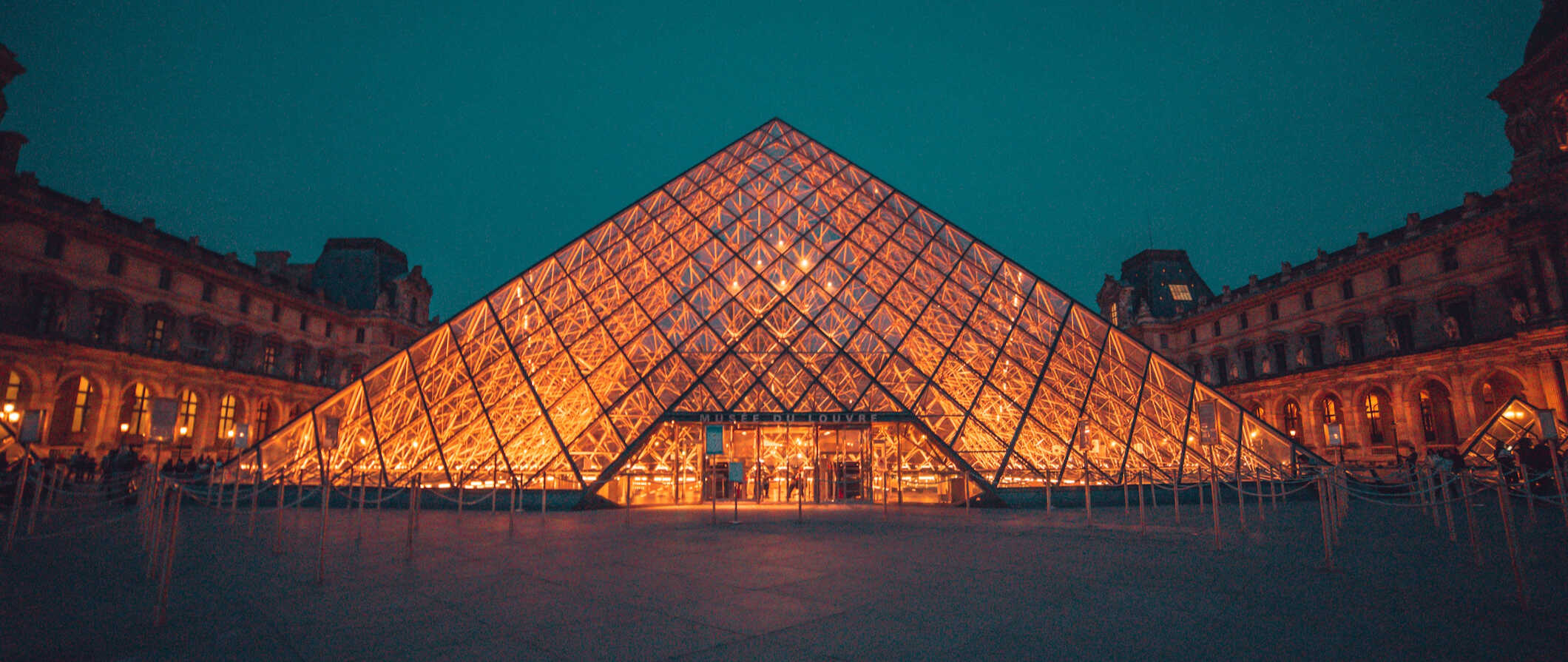
Hostel prices – A bed in a dorm ranges from 40-75 EUR per night, depending on location and how popular the hostel is. Double private rooms start at 97 EUR per night, but are more often in the range of 155-200 EUR. Free Wi-Fi is standard and most hostels also have self-catering facilities. Expect prices to be on the higher end during the summer travel season.
Budget hotel prices – Budget two-star hotels start around 120 EUR per night for a room with a double bed. You’ll get normal basic hotel amenities like free Wi-Fi, TV, coffee/tea maker, and occasionally free breakfast. For a more mid-range three-star hotel, expect to pay at least 150-180 EUR per night. Expect prices to rise in the summer.
On Airbnb, the private rooms start at 65 EUR, while full apartments start at 150 EUR per night (but usually cost at least double that if you don’t book early). Prices will be double this in the summer.
Food – Food in France has a long history and is intricately intertwined with the culture. Fresh bread (especially baguettes), tasty local cheeses, and plentiful wine may be stereotypical staples of the cuisine, but they really are some of the must-eat foods in the country. Be sure to try croque monsieur (a hot ham and cheese sandwich), pot-au-feu (beef stew), steak frites (steak and fries), and if you’re real adventurous you can sample traditional delicacies like frog legs, escargot (snails) or foie gras (a fattened duck or goose liver).
If you’re on a budget, pick up some ingredients at the local market and have a picnic in one of the city’s many parks. Creating your own meal costs around 7-10 EUR and is a fun way to take in the city as you relax.
Pre-made sandwiches from the city’s takeaway shops, crepes, or fast food generally cost between 6-12 EUR (a combo meal at McDonald’s is around 10 EUR). If you want to eat at a restaurant (the French are known for their culinary skills, after all!), try doing a “prix-fixe” meal. It’s a set menu that offers you a deal on a 2-3 course meal for about 22-35 EUR for lunch.
A cheap meal at a casual restaurant costs around 15-18 EUR, while you should expect to pay between 30-50 EUR for dinner at a nice restaurant including wine. Try to avoid the tourist areas, where prices are around about 10-30% higher.
Beer costs 6-7 EUR, a glass of wine is 4-6 EUR, and cocktails are around 10-13 EUR. A cappuccino/latte is around 4 EUR while bottled water is 2 EUR.
Some of my favorite places to eat in the city are Bouillon Pigalle, Café Marlette Martyrs, Père & Fils, Bong, Crêperie des Arts, Le Dit Vin, Five Tea Or’normes, Florence Kahn, Le Relais de l’Entrecôte, Juveniles, Clamato, Wine Therapy, and La Recyclerie, Septime La Cave, Le Barav, and L’Assiette.
For an in-depth list of tons of restaurants and bars, check out my guidebook to Paris , which goes in-depth into the city!
If you’re cooking for yourself, expect to pay about 50-60 EUR for a week’s worth of groceries. This gets you basic staples like rice, pasta, bread, seasonal produce, and some meat.
Backpacking Paris Suggested Budgets
If you’re backpacking Paris, my suggested budget is about 70 EUR per day. This budget covers staying in a hostel dorm, cooking your own meals and having picnics, taking public transit to get around, limiting your drinking, and doing most cheap or free activities like free walking tours and free museums.
A mid-range budget of about 150 EUR per day covers staying in a private Airbnb room, eating out for most of your meals at cheap fast food places, enjoying a few drinks, taking the occasional taxi to get around, and doing more paid activities like going up the Eiffel Tower and visiting the Louvre.
For a “luxury” budget of 280 EUR or more per day, you can stay in a budget hotel, eat out for all your meals, take more taxis, drink more, and do whatever tours and activities you want. This is just the ground floor for luxury though. The sky is the limit!
You can use the chart below to get an idea of how much you need to budget daily. Keep in mind these are daily averages – some days you’ll spend more, some days you’ll spend less (you might spend less every day). We just want to give you a general idea of how to make your budget. Prices are in EUR.
Paris Travel Guide: Money-Saving Tips
Since Paris is expensive to visit, it’s important to find ways to save money. Luckily, there are A LOT of ways to save money while still experiencing the city’s beauty, charm, and cuisine. If you want to lower your costs, here are some high-impact ways to save money in Paris:
- Buy a metro card – Paris has over 300 subway stations, so it’s easy to get around the city using public transportation. A day pass is 13.20 EUR while a 10-ticket pass or “carnet” costs 16.90 EUR (both of these are much cheaper than paying the 1.90 EUR for an individual ticket). The day pass, called ParisVisite, also provides discounts to some major Parisian landmarks.
- Have a picnic – With so many beautiful parks and outdoor gardens, it would be hard not to take advantage of picnicking. Eating in Paris is cheap when you do your own shopping. Buy some bread, cheese, and meat at the local shops and have an outdoor picnic. It’s fun and costs a fraction of what a meal in a restaurant would.
- Get the Paris Museum Pass – This prepaid card provides access to over 70 museums and monuments around Paris. A two-day pass costs 52 EUR, a four-day pass costs 66 EUR, and a six-day pass costs 78 EUR. This is perfect for the museum hopper. Since most people visit lots of museums in the city, you’re pretty much guaranteed to save money.
- Get the Paris Pass – This is a super-sized version of the Paris Museum Pass and is for people who want to do heavy sightseeing in a short period of time. You can purchase a two-day pass for 109 EUR, a three-day pass for 129 EUR, a four-day pass for 149 EUR, or a six-day pass for 169 EUR. It includes a TON of sights (75+ attractions), the ability to skip lines, and a hop-on, hop-off bus tour (in addition to everything in the Paris Museum Pass). You can order your pass here .
- See museums for free – All national museums offer free admission on the first Sunday of every month. If you happen to hit this day, be aware of potentially large crowds and long lines.
- Dine out during lunch – Food in Paris is not cheap. It costs you an arm and a leg to eat here, but during lunch, many restaurants offer a pre-fixe menu for 10-20 EUR. It’s the same food you would buy for dinner but at half the cost. When I eat out in Paris, I do so during lunch so I can still eat amazing French food without it eating my entire wallet!
- Cook your meals – The best way to save money on the road is to cook your own meals. Many hostels, campsites, and guest houses have kitchens. No kitchen? Pack your own container and silverware and make some sandwiches and salads on the go.
- Stay with a local – I highly recommend trying to find a host on Couchsurfing (or similar apps) so that you can get a kitchen, a place to stay, and a local friend to show you around. The community here is very active and friendly!
- Take a free walking tour – If you want to get a great overview of Paris, take a free walking tour with New Europe Tours. These 2-3 hour tours will give you a good overview of the city, help you get your bearings, and give you someone to ask for cheap eats and things to do! Just don’t forget to tip your guide at the end!
- Remember that water is free – When you order water at a restaurant, make sure you ask for tap water. They’ll try to provide bottled water and charge you for it, but tap water is free and safe to drink.
- Bring a water bottle – Since the tap water here is safe to drink you should bring a reusable water bottle to save money and reduce your plastic use. LifeStraw is my go-to brand as their bottles have built-in filters to ensure your water is always clean and safe. There are water filling stations throughout the city.
Where to Stay in Paris
Paris has lots of awesome hostels and budget hotels. Here are some of my recommended places to stay in Paris:
- St. Christopher’s Canal
- Les Piaules
- Generator Hostel
- St. Christopher’s Gare du Nord
- Hôtel Thérèse
For more hostel suggestions be sure to check out my list of the best hostels in Paris.
How to Get Around Paris
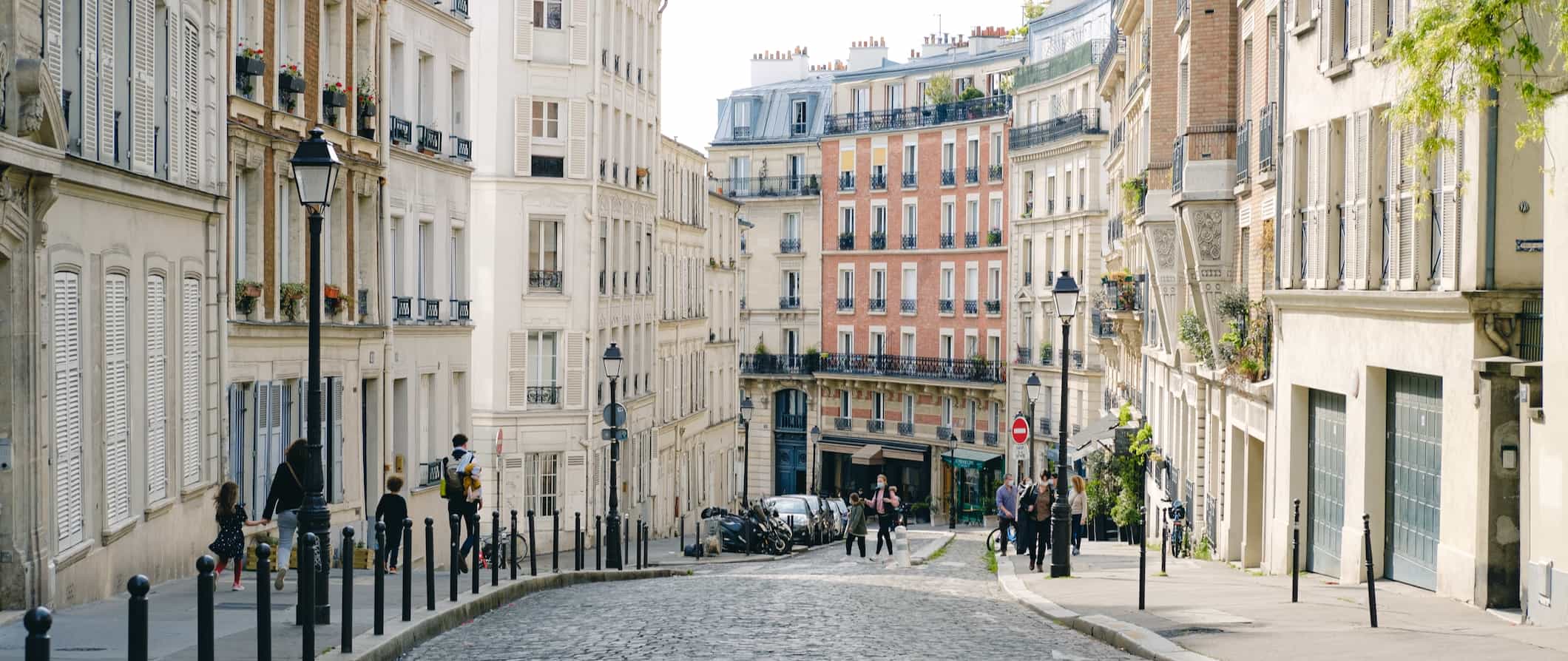
Public transportation – The Paris public transport system is one of the world’s most comprehensive and efficient. Every other block has a metro (subway) stop. A single-use metro/bus ticket costs 1.90 EUR (2 EUR if you buy it on the bus).
A “carnet” of 10 single-use tickets costs 16.90 EUR. You can get a one-day to five-day pass (a ParisVisite) for all modes of public transportation (bus, metro, trams, and suburban trains called the RER) for between 13.20-42.20 EUR. It also gives you discounts to some major Parisian landmarks. You can buy tickets at any metro station.
( Note: There are cheaper day passes available if you are under 26, as well as discounted prices on weekends and holidays, but they are only explained on the French website. If you can speak passable French and are under 26, you can ask for those reduced fares instead.)
The RER is an above-ground train that has five lines serving Paris and Ile-de-France. It works exactly like the metro and uses the same tickets, although you’ll have to use your ticket in the automatic barriers on your way out of the station as well (unlike the metro). If you have a connecting journey with the metro, you can use the same ticket.
There are 64 bus lines in Paris’s metro network. If you already have your single-use metro/bus ticket, it costs 1.90 EUR. Otherwise, you’ll have to buy a ticket on the bus for 2 EUR. Your ParisVisite pass also works on the bus.
There are four tram lines in Paris that navigate the city’s perimeter. They work on the same ticketing system as the metro, RER, and bus.
The airport RoissyBus to Paris-Charles de Gaulle (CDG) costs 12 EUR each way. The bus to Paris-Orly (ORY) costs between 9.50-12.10 EUR depending on which bus you take/where you are going in Paris.
Bike-sharing – Velib’ is Paris’s public bike-sharing program. A single trip is 3 EUR, while a one-day pass is 5 EUR and a 3-day pass is 20 EUR. If you’d like to take out an electric bike, a one-day pass is 10 EUR.
E-scooters – Electric scooters have quickly become a popular way to get around in Paris. There are a few different companies, including Lime and Tier, but most cost around the same price: around 1 EUR to unlock the scooter, .15-.20 EUR per minute thereafter.
Taxi – Taxis in the city are expensive (rides cost a minimum of 7.10 EUR regardless of where you are going). With the metro running late into the night, there’s little reason to take them. Avoid them if you can.
Uber – Uber is available in Paris but, again, it’s largely unnecessary as the public transportation is so great.
When to Go to Paris
Summer is the most popular (and most expensive) time to visit Paris. Average daily summer temperatures are in the low 20°Cs (high 70°Fs). While the weather is great, that also means the crowds are huge and wait times for major attractions are long. This is the most crowded time of year. (And, keep in mind, most French people leave during August for vacation.) If you are visiting in the summer, be sure to book your accommodation and activities in advance.
I think the best time to visit is May-early June and September-October. During these times, there are fewer crowds, prices are lower, and the weather is still sunny and warm. Temperatures are often around 20-23°C (68-73°F) making this a good season to stroll around outside without tons of layers on or the sweltering sun beating down on you.
Winter can be dark and chilly, but while the weather may not be perfect, Paris is particularly beautiful in the winter. It’s also the best time to find cheap airfare and hotel deals. Although Paris is never free from tourists, it does get less crowded at this time of year. This can be a great time to visit if you plan on spending most of your time in museums and historic sites. It’s also the rainiest during this time. Expect daily highs around 7°C (44°F).
How to Stay Safe in Paris
Paris is very safe, and the risk of violent crime is very low. That said, as in all major cities, petty theft and pickpocketing are pretty rife here, especially on crowded public transportation and in busy tourist areas. Avoid flashing your valuables and always keep your possessions secure and out of reach.
There’s a lot of tourist scams here, especially one involving people getting you to sign a petition and then demanding money. Simply avoid anyone urging you to sign a petition by politely declining their offer.
If you’re worried about getting scammed, you can read about common travel scams to avoid right here.
Solo female travelers should feel safe here, though the standard precautions occur (don’t leave your drink unattended at the bar, never walk home alone at night if intoxicated, etc.). For specific tips, I’d google solo female travel blogs as they can best give advice for Paris. To be extra safe, avoid walking around at night by yourself in certain neighborhoods, including Gare du Nord, Stalingrad, Jaures, and Les Halles.
Generally, your biggest issues in Paris will be tourist scams and petty theft.
If you experience an emergency, dial 112 for assistance.
Always trust your gut instinct. Avoid isolated areas at night and be aware of your surroundings at all times. Make copies of your personal documents, including your passport and ID.
The most important piece of advice I can offer is to purchase good travel insurance. Travel insurance will protect you against illness, injury, theft, and cancellations. It’s comprehensive protection in case anything goes wrong. I never go on a trip without it as I’ve had to use it many times in the past.
Paris Travel Guide: The Best Booking Resources
These are my favorite companies to use when I travel. They consistently have the best deals, offer world-class customer service and great value, and overall, are better than their competitors. They are the companies I use the most and are always the starting point in my search for travel deals.
- Skyscanner – Skyscanner is my favorite flight search engine. They search small websites and budget airlines that larger search sites tend to miss. They are hands down the number one place to start.
- Hostelworld – This is the best hostel accommodation site out there with the largest inventory, best search interface, and widest availability.
- Booking.com – The best all around booking site that constantly provides the cheapest and lowest rates. They have the widest selection of budget accommodation. In all my tests, they’ve always had the cheapest rates out of all the booking websites.
- Get Your Guide – Get Your Guide is a huge online marketplace for tours and excursions. They have tons of tour options available in cities all around the world, including everything from cooking classes, walking tours, street art lessons, and more!
- SafetyWing – Safety Wing offers convenient and affordable plans tailored to digital nomads and long-term travelers. They have cheap monthly plans, great customer service, and an easy-to-use claims process that makes it perfect for those on the road.
- LifeStraw – My go-to company for reusable water bottles with built-in filters so you can ensure your drinking water is always clean and safe.
- Unbound Merino – They make lightweight, durable, easy-to-clean travel clothing.
- Top Travel Credit Cards – Points are the best way to cut down travel expenses. Here’s my favorite point earning credit cards so you can get free travel!
- BlaBlaCar – BlaBlaCar is a ridesharing website that lets you share rides with vetted local drivers by pitching in for gas. You simply request a seat, they approve, and off you go! It’s a cheaper and more interesting way to travel than by bus or train!
- Take Walks – This walking tour company provides inside access to attractions and places you can’t get elsewhere. Their guides rock and they have some of the best and most insightful tours in all of France.
GO DEEPER: Nomadic Matt’s In-Depth Budget Guide to Paris!

While I have a lot of free tips on Paris, I also wrote an entire book that goes into great detail on everything you need to plan a trip here on a budget! You’ll get suggested itineraries, budgets, even more ways to save money, my favorite restaurants, maps, prices, practical information (i.e. phone numbers, websites, prices, safety advice, etc.), and cultural tips.
I’ll give the insider view of Paris that I got from living and running tours here! The downloadable guide can be used on your Kindle, iPad, phone, or computer so you can have it with you when you go.
Paris Travel Guide: Related Articles
Want more info? Check out all the articles I’ve written on backpacking/traveling France and continue planning your trip:

The 8 Best Hotels in Paris

How to Spend 5 Days in Paris
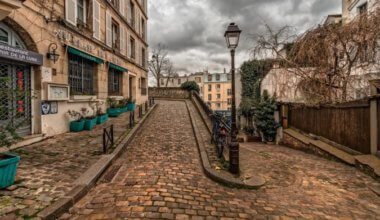
13 Off-the-Beaten-Path Things to See and Do in Paris
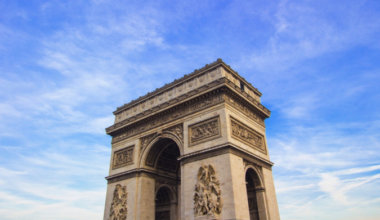
The Best Walking Tours in Paris

Life in Paris, Part 3: Nothing Lasts Forever

The 10 Best Day Trips from Paris
Get your free travel starter kit.
Enter your email and get planning cheatsheets including a step by step checklist, packing list, tips cheat sheet, and more so you can plan like a pro!

- Where To Stay
- Transportation
- Booking Resources
- Related Blogs
Protect Your Trip »
18 best paris tours of 2024: food, versailles & more.
Enhance your visit to the City of Love with one of these specialized tours.
The Best Paris Tours

Getty Images
From the Eiffel Tower to the Moulin Rouge – plus day trips to Versailles, Normandy and beyond – there are so many things to do in Paris . To make the most of your trip, it can be helpful to rely on the expertise of a few locals via a guided tour. Read on to discover some of the top-rated Paris tours for a variety of interests.
Bike About Tours – Hidden Paris Bike Tour
Price: Adults from 45 euros (around $49); kids 3 and younger from 20 euros (about $22) Duration: 3.5 hours
On this roughly 3.5-hour cycling trip, a guide takes you on back streets to both notable and lesser-known attractions throughout Paris. Along the way, guides share historical and cultural anecdotes. Sights include the Place des Vosges, Jardin des Plantes and the Paris mosque, to name a few. Reviewers love seeing an array of attractions at a leisurely pace and applaud the expertise of the guides. Bike About Tours also offers cycling excursions through Versailles.
Check prices & availability on:
Big Bus Paris Hop-On Hop-Off Tour
Price: Adults from $45; kids 4-12 from $25 Duration: About 2 hours
Create your own Parisian adventure with the Big Bus Hop-On Hop-Off Tour. Double-decker, open-top buses take you to 10 stops near top attractions, including the Arc de Triomphe, the Eiffel Tower, Musée du Louvre and the Grand Palais. All buses are equipped with a prerecorded audio tour in 11 different languages. Reviewers love the convenience of the bus, but some express disappointment that buses are often overcrowded.
Buses run from around 10 a.m. to about 7:30 p.m. daily and typically frequent stops every seven to 15 minutes. If you choose to ride the whole route, you'll be on the bus for two hours and 15 minutes. Ticket discounts may be available if you book online in advance. Big Bus also offers two-day passes, a night tour and combo tours that include a river cruise.
Paris Charms and Secrets
Price: From 59 euros (about $64) Duration: 3.5 to 4 hours
If you're a sucker for a good story, a secret passageway or a long-forgotten historical tale, the Paris Charms and Secrets tour will be right up your alley. On this roughly 12-mile tour, a guide will lead you through the city on an electric bike, stopping at some of Paris' most famous attractions and storied monuments. Hear the legends of Élysée Palace, the controversies of the Eiffel Tower and the curious past of the Notre-Dame Cathedral. Reviewers love the knowledgeable guides and the unique stories.
Older children and teens are welcome to ride their own bikes if they meet the height and weight requirements; a child seat must be reserved ahead of time for younger kids (for 12 euros).
Paris By Mouth – North Marais Food Tour
Price: 130 euros (about $141) Duration: 3.5 hours
If you want an intimate look at one of Paris' most fashionable and beautiful areas, snag a spot on Paris By Mouth's North Marais Food tour. This 3.5-hour tour welcomes up to eight participants to create a more personal feel. For the first part of the tour, your guide will bring you to some of the neighborhood's most prestigious shops, which specialize in bread, cheese, pastry and charcuterie. The second part of the tour stops at a wine shop and includes a seated tasting with wine pairings. Paris By Mouth's guides are experienced food journalists, chefs and foodies – a highlight among reviewers.
The tour is recommended for adults, though children older than age 12 can join. The tour runs daily at multiple times. Paris By Mouth also hosts tours of Saint-Germain-des-Près, south Marais and the Left Bank.
Retro Tour Paris – Retro Classic
Price: From $75 Duration: 40 minutes
Hop into the vintage sidecar of an experienced motorcycle driver and cruise through the city with views of the Champs-Élysées, the Eiffel Tower, Champ de Mars and more on the Retro Classic tour of Paris. Local guides will share unique stories and provide an experience worlds apart from a typical city tour. Reviewers rave about the thrill of riding in the sidecar and the local insight.
If you love your first sidecar experience, you can also opt for the company's 90-minute tours, as well as a ride through Paris after sunset (with a Champagne tasting, naturally).
Blue Fox Travel – Versailles Bike Tour
Price: Adults from 109 euros (around $119); kids from 95 euros (about $104) Duration: 9 hours
The Versailles estate encompasses 2,000 acres, and there's no better way to see it than on a bike with Blue Fox Travel. Spend roughly nine hours with an expert guide and a small group (up to 14 people) touring the royal grounds, including the Grand and Petit Trianon chateaus, Marie Antoinette's private domain and the grand palace with a skip-the-line pass included in your ticket. Guides tell stories of French royal history, including the conquests of the Louis XIV, also known as the Sun King, the controversies surrounding Louis XV, the French Revolution and Marie Antoinette. Reviewers love biking the grounds at a leisurely pace and rave about the expertise of the guides, as well as the picnic lunch with finds from one of the local farmers markets.
Tours include train tickets to and from Paris. Blue Fox Travel also guides visitors on cycling tours of Paris at night and the city's top attractions.

Secret Food Tours Paris – Montmartre
Price: Adults from 109 euros (about $119); kids from 99 euros (about $108) Duration: 3.5 to 4 hours
Peruse and stroll through the Parisian dining scene like a local with Secret Food Tours. On this up to four-hour tour of one of Paris' most picturesque and lively arrondissements, dessert is first (c'est la vie!) . You'll gather chocolates and macarons from local specialty shops, followed by baguettes, cheeses, meats and crêpes – all while learning more about food and Parisian traditions from your local guide. When your bag is full, the guide will lead you to a prime picnic spot to enjoy your bounty with a few wine pairings. Reviewers love the historical tidbits and local insights, as well as the animated and entertaining tour guides.
An upgraded drinks package is available for an additional charge. Tours run daily at several different times, depending on the day. Secret Food Tours also hosts walks through other Paris neighborhoods, such as Saint-Germain-des-Prés and Le Marais.
Intrepid Urban Adventures – Paris Marais Bites and Sights Tour
Price: From $97 Duration: 2 hours
Wander through Paris' gorgeous Marais with a local guide and a lineup of French treats. Intrepid Urban Adventures' Bites and Sights Tour takes you through the well-preserved (and very fashionable) area of the Marais. Throughout the approximately two-hour tour, you'll hear local insights and historical tales as you admire Marais' treasured architecture. Stories are accompanied by stops in neighborhood shops for pastry and macaron samples, plus a French cheese platter and two glasses of wine. Reviewers appreciate the expertise and entertainment provided by the guides, as well as the intimate and conversational environment.
Children 5 and younger can tag along for free, as long as they sample items from their parents' plate. Paris Urban Adventures also offers tours of bohemian Paris and several private excursions.
Paris by Martin & Friends – Walking Tour
Price: 70 euros (about $76) Duration: 2.5 hours
For a truly bespoke experience with a passionate local, take a tour with Martin Muda and his friends, all residents of Paris. On the 2.5-hour walking tour, Muda or one of his tour guides will lead you to treasured spots throughout the city, with stories that give life to Paris' history and legends. Reviewers give high praise for the tour guides and their attention to detail, as well as the customization of each tour.
Tours are available at 10 a.m. and 3 p.m. daily. Children younger than 3 can join the tour for free. Inquiries can be made through the website. The company also offers walking picnic tours at night and electric bike tours.
Fat Tire Tours – Versailles Bike Tour
Price: Adults from 109 euros (about $119); kids from 95 euros (about $103) Duration: 8.5 hours
To see Versailles in all of its glory, take a ride with Fat Tire Tours. On this daylong tour (approximately 8.5 hours), a guide will take you through the Versailles open market to grab a picnic lunch before visiting the Petit Trianon, the Grand Trianon and the estate gardens. The tour also includes skip-the-line access to the palace and an audio guide. Riders love the bicycles and tour guides, and appreciate the sweeping views of the iconic palace and grounds.
Tours are offered Tuesday through Sunday and all depart before 9 a.m. Kids younger than 4 are free to join the tour. Fat Tire Tours also offers a variety of biking excursions around Paris – including an "Emily in Paris"-inspired tour – and the surrounding region, as well as guided walks and Segway rides.

SANDEMANs NEW Europe – Montmartre Free Walking Tour
Price: Free; tips appreciated Duration: 2.5 hours
Stroll through one of Paris' most famous and charming neighborhoods with the help of SANDEMANs NEW Europe. This 2.5-hour tour will take you by the area's most photographed sights, including the Moulin Rouge and up the steps to Sacré-Coeur. You'll recognize streets featured in paintings and in cinema as guides share tales of Montmartre's famous artists, musicians and other notables, including Van Gogh and Picasso. Tourgoers appreciate the guides' expertise and recommend the tour for art history lovers.
Tours depart daily at 4 p.m. (Spanish language) and 5 p.m. (English language). Tickets are free, though tips are appreciated. If you're looking to explore more of the city, the company offers an array of other tours covering Latin Quarter, the Seine River and more.
Boutique Bike Tours – Versailles Food & Palace Bike Tour
Price: Adults from 145 euros (about $158); kids 5 and older from 99 euros (about $108) Duration: 9 to 10 hours
If you're looking to escape the city, let Boutique Bike Tours take you on a ride and stroll through the gardens of Versailles. On this approximately nine- to 10-hour tour, guides lead the way through the sprawling estate before stopping for a picnic lunch with provisions purchased from the market in town. After lunch, you'll skip the line at the famous palace to explore the rooms and hallways of Versailles. Reviewers enjoy the leisurely pace, a day full of activities and informative guidance.
Tours generally depart Tuesday and Friday through Sunday; expect to leave at 8 or 9 a.m. and return around 6 p.m. The company also hosts an evening bike and boat tour of Paris.
2CVParisTour – Legendary Paris Tour
Price: From 160 euros (about $175) Duration: 2 hours
If you're looking for a memorable and personalized drive through Paris, allow 2CVParisTour to take you for a whirl in a Citroën 2CV, a classic French car. Take in sights like the Arc de Triomphe, Luxembourg Gardens, Palais de l'Élysée , Église Saint-Sulpice and more as you cruise through the Paris streets for two hours. Reviewers praise the classic car experience and entertaining guides.
Champagne can be added to the tour for an extra charge. Tours depart at multiple times daily, starting at 11 a.m. and ending after 10 p.m. If you can't get enough of the vintage car experience, you can also sign up for a tour of Montmartre, one that features a picnic and others.
City Wonders – Paris Catacombs Underground Tour
Price: Adults from $119 Duration: 2 hours
City Wonders will take you on a two-hour tour of what's below Paris: a network of tunnels, crypts and tombs that are home to nearly 6 million skeletons. On this Paris Catacombs tour, you'll skip the line with a small group to explore the Port Mahon gallery, the Sacellum Crypt and Gilbert's Tomb. Throughout the tour, you'll hear historical anecdotes from insightful guides. Along with the entertaining guides, reviewers also appreciate the skip-the-line access and recommend this experience in lieu of a self-guided tour.
Ticket prices may increase during busier times of the year. Tours depart Tuesday through Sunday at several times each day. City Wonders also hosts traditional aboveground tours of the Louvre, Versailles and the Eiffel Tower.

Paris City Vision – Half Day Guided Tour of Giverny Monet's Gardens from Paris
Price: From 89 euros (about $97) Duration: About 5 hours
On this roughly five-hour tour, a guide will take you through the life of celebrated painter Claude Monet as you explore his home and garden in Giverny. His garden is what inspired some of his most prized works, including "Irises" and "Water Lilies." Reviewers value the views and insight provided by tour guides, though others warn that the company can be disorganized.
Tours generally run daily at 8:15 a.m. and 2:30 p.m. The company hosts a number of other tours throughout Paris and greater France , including tours to Normandy .
Street Art Tour Paris – Murals XXL
Price: From 26 euros (about $28) Duration: About 2 hours
There's no museum pass needed to see some of the city's largest artwork with Street Art Tour's Murals XXL. An expert guide leads groups through the city to view contemporary works created by the world's most famous and talented muralists, such as Jorge Rodriguez-Gerada and Obey. Reviewers love the insider information and find the tour reveals details (and murals) often overlooked. Plus, the route is accessible for those with limited mobility.
Tours last just over two hours and run Tuesdays and Saturdays at 2 p.m. Discounts are available to groups of five or more. Street Art Tour Paris also offers tours in Montmartre and Belleville, among other options.
Babylon Tours – Louvre Museum + Orsay Museum Guided Combo Tour
Price: Adults from 199 euros (about $217); kids from 159 euros (about $173) Duration: 5.5 hours
View Greek sculpture and famous paintings by greats like Renoir, Monet, da Vinci and Van Gogh during this 5.5-hour tour. As you explore the Louvre and the Musée d'Orsay, guides will regale you with stories of art history. Plus, you'll bypass the long lines at the attractions. Travelers praise the guide's knowledge and appreciate the small groups (no more than eight people can go at once).
Tours run at 10 a.m. from Wednesday to Saturday. Fees include access to the museums. Babylon Tours also operates outings to the Musée de l'Orangerie, the Rodin Museum and individual outings to the Louvre and Musée d'Orsay.
XL Tours – Segway Tour
Price: From 75 euros (about $82) Duration: 2 hours
During this two-hour tour, you'll glide by some of Paris' must-see sights like the Eiffel Tower, Trocadero Gardens and the Musée d'Orsay. You'll also ride in style on Bel & Bel Segways, which are designed to resemble the iconic Vespa scooters. Travelers say the Segways are a great way to see the city and the guides provide clear instructions.
Tours are available daily at 11 a.m., 3 p.m. and 6 or 7 p.m. You may be required to book at least two riders for your tour if you book directly through the company's website. Participants must be at least 12 years old. XL Tour also runs electric bike tours through the city.
You may also be interested in:
- The Best Hotels in Paris
- The Best London Tours
- The Best International Travel Insurance
Tags: Tours , Travel , Vacations , Paris , Europe Vacations
World's Best Places To Visit
- # 1 South Island, New Zealand
- # 4 Bora Bora
If you make a purchase from our site, we may earn a commission. This does not affect the quality or independence of our editorial content.
You May Also Like
Top things to do in new hampshire.
Timothy J. Forster and Mariya Greeley June 14, 2024

The Best Scotland Tours
Marisa Méndez June 13, 2024

Flight Canceled or Delayed? What to Do
Amanda Norcross June 13, 2024

How to Renew a Passport Online

The Best Small Group Tours of Italy
John Rodwan and Ann Henson June 12, 2024

Crystal Symphony Review
Jill Schildhouse June 12, 2024

Fall in New England
Amanda Norcross June 11, 2024

Fun Things to Do in New Mexico
Alissa Grisler and Ashley M. Biggers June 11, 2024

Travel During Hurricane Season

Top Orlando Theme Parks
Lyn Mettler and Timothy J. Forster June 11, 2024

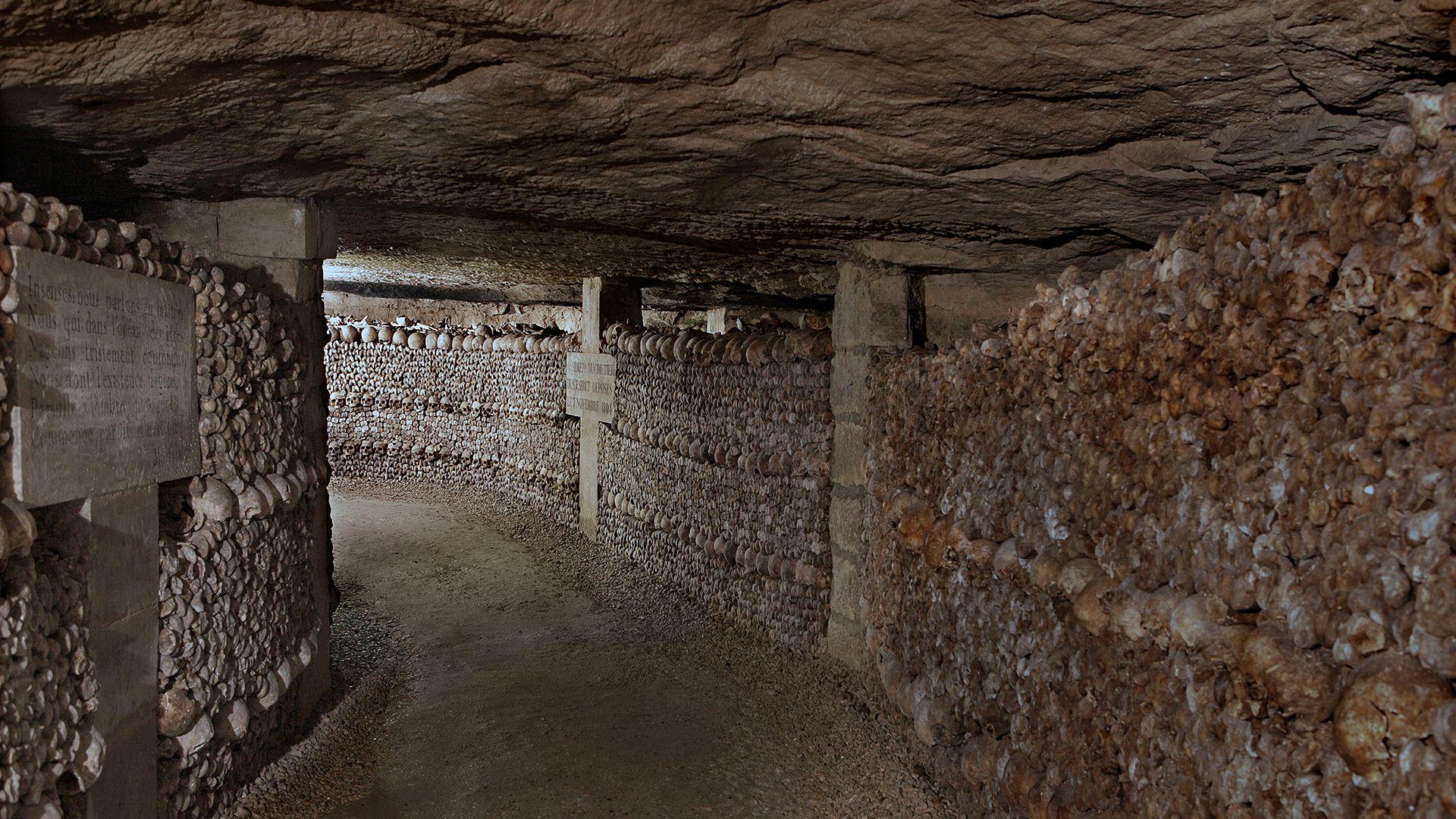
Prepare your visit with a virtual tour and enrich your visit with informations about exhibitions and activities
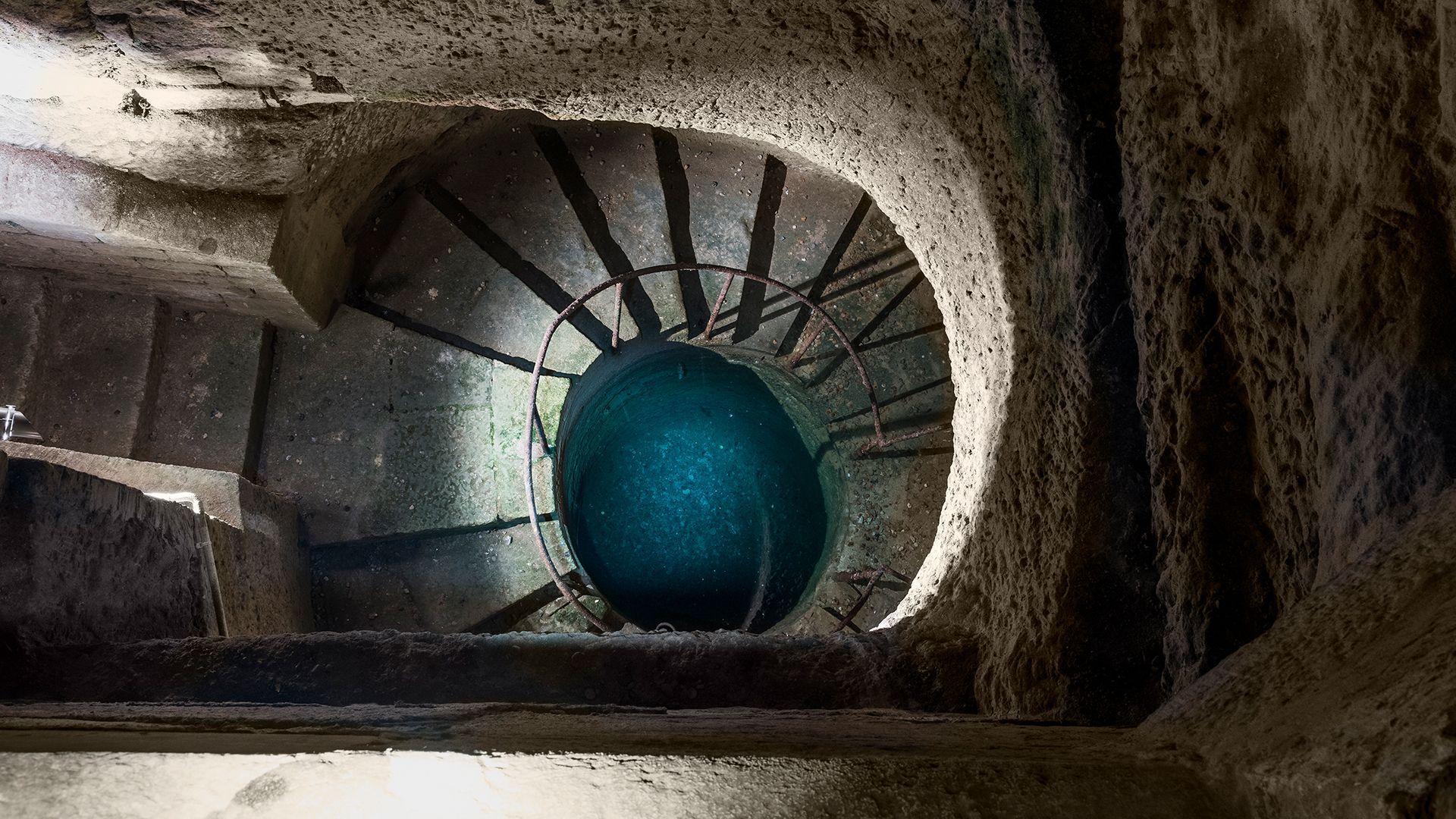
Increase your knowledge
Virtual tour, online resources to increase your knowledge
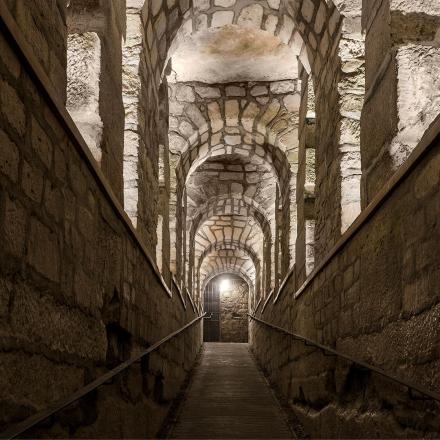
Tour Offers
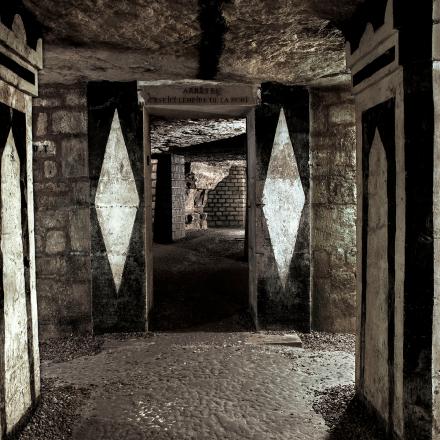
Virtual visit
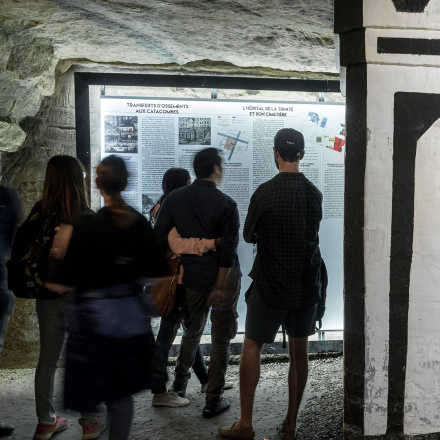
Online Resources

IMAGES
VIDEO
COMMENTS
The Paris Catacombs. A veritable labyrinth in the heart of underground Paris, the Catacombs were installed in the tunnels of former quarries. ... Online booking is strongly recommended (except free rate tickets). Opening hours. Tuesday to Sunday. 9:45 - 20:30. Last admission at 19:30. Adress. 1 av. du Colonel Henri Rol-Tanguy 75014 Paris ...
Palais Galliera, musée de la mode de la Ville de Paris; Musée du Général Leclerc de Hauteclocque et de la Libération de Paris - Musée Jean Moulin; Petit Palais : musée des beaux-arts de la Ville de Paris; Musée de la Vie Romantique; Maisons de Victor Hugo Paris / Guernesey; Musée Zadkine
The entrance to the Paris Catacombs is located just outside the Denfert-Rochereau metro stop. At the end of your visit, you will exit at 21 Bis Avenue Rene-Coty. Opening Hours: The Paris Catacombs are open Tuesday through Sunday from 10:00 to 8:30 pm. The last entrance is at 7:30 pm.
El free tour por el Barrio Latino de París recorre lugares muy pintorescos, como la Rue du Chat Qui Pêche (la calle más angosta de París), hasta monumentos solemnes, como el Panteón de París, donde reposan los restos de personajes ilustres como Marie Curie o Victor Hugo. Conocerás la Plaza de la Sorbona, la iglesia San Severino, el Museo ...
History of the Paris Catacombs. In 1786, Paris was struggling with epidemics and cemeteries without space. With the intention of freeing up places in their cemeteries, it was decided to transfer the corpses from various cemeteries and common graves to these tunnels. What you can visit today is a part of this complex labyrinthine structure.
75014 Paris ( 14th arrondissement ). Metro/RER: Denfert-Rochereau (M Line 4, RER Line B) Exiting the metro at Denfert-Rochereau, look for building with a light-green glass entrance area and ticketing booth, where you can access a long, winding set of stairs down to the catacomb tunnels (131 steps).
How to visit the Paris Catacombs. The catacombs of Paris are old limestone mines—the materials were used to create some of Paris' most iconic buildings above ground. Photo by Alex Guevara/Shutterstock. The full-rate ticket price is 29 euros (around US$32), with last-minute tickets priced at 15 euros (about US$17).
Full description. Get fast-track entry to the underground cemetery of the Paris Catacombs, composed of miles of underground tunnels lined with the skulls and bones of some 6 million Parisians. Join a local guide and explore the catacombs in a small group of no more than 19 people (6 people on select start times).
This tour is approximately 2 hours in length and it starts at either 4:30 pm or 5:30 pm, which means they are also pretty close to being night tours. €119.90 per person. Includes Paris Catacombs tickets. Availability: Tuesday - Friday. Hours: 4:30 pm, 5:30 pm. Duration: 2 hours.
How to visit the Paris Catacombs. The entrance to the Paris Catacombs is located at 1, Avenue du Colonel Henri Rol-Tanguy (Place Denfert-Rochereau), near Montparnasse. You can take the Metro to the Denfert-Rochereau station, then it's a short walk to the entrance. The one-mile underground circuit is one way and you'll exit from another ...
In the Paris Catacombs, there are 131 steps to go down and 112 steps to climb up. Buy tickets. Booking online is strongly recommended. Purchase a ticket. Tous les musées de la ville de paris . Discover the museums of the City of Paris. Musée d'Art Moderne de Paris; Maison de Balzac;
This structure is located in an area at the center of all skulls and bones within the Catacombs Of Paris, known as the Crypt of Passion. The massive eerie barrel shape holds more bones and skeletons within it and was erected in 1897 when an illegal concert featuring Chopin's Funeral March and the Danse Macabre by Camille Saint-Saens in the middle of the night was being held here.
The Catacombs of Paris (French: Catacombes de Paris, pronunciation ⓘ) are underground ossuaries in Paris, France, which hold the remains of more than six million people. Built to consolidate Paris's ancient stone quarries, they extend south from the Barrière d'Enfer ("Gate of Hell") former city gate; the ossuary was created as part of the effort to eliminate the effects of the city's ...
Paris Catacombs: Our most recommended tours and activities. 1. Paris: Catacombs Entry Ticket, Audio Guide, and River Cruise. Experience the fascinating vestiges of Paris' past with a ticket to the mysterious Catacombs. Discover the city's romantic side with an optional picturesque Seine River cruise. Witness iconic landmarks and uncover the ...
Guided tours in French for individuals on Thursdays at 1p.m.: Discovery of the Catacombs. Reservation online. Starting at age 10. Duration: 1.5 hours. No disabled access. Choice of guided tours for groups with a museum lecturer. Because of strong demand, we recommend you reserve the time slot for your visit at least four weeks ahead of time.
Full description. Beneath the dazzling lights of modern Paris lie the devilishly dark catacombs. On this small-group tour have skip-the-line entry and exclusive access to restricted areas. Explore the 200-mile maze of remains from roughly 6 million Parisians with an expert guide. Begin with a bone-chilling descent down the complex's 133-step ...
As of October 2023, the official "skip the line" tickets (including an audio guide in multiple languages) are €29 for adults, €23 for students 18-26, and €10 for kids 5-17 with an adult (they don't get an audioguide). Purchase them at this link (scroll all the way down to "Official ticket // Catacombs"). The last-minute tickets ...
Las Catacumbas de París son cada vez más frecuentadas y se trata de uno de los sitios turisticos de paris más solicitados por los viajeros de paso que buscan conocer otros lugares menos famosos que los clásicos monumentos y museos.. Se trata del mayor osario subterráneo del mundo de casi de 1,7 kilometros de largo, a 20 metros de profundidad. Se trata del cementerio más importante de ...
Some are free, like New Europe's tour, and go around the center of Paris, giving a historical overview of the city. Walks offer amazing in-depth tours starting from about 55 EUR. You'll get specialized guides and skip the lines to big attractions, like the Louvre. I wrote a whole guide to the best walking tours in Paris! 14.
Yes, they are a bit expensive, but its in good shape, has plenty of content in a small area (bones, sculptures, architectural stuff, etc.), and you may even have a guide that will go through the complex history. Reply. Award. 10 votes, 10 comments. May somebody help me with the unnoficiall guide of catacombs in Paris?
Clean, as in where I stayed (9th) - I saw Paris City services wash down streets every 2 days. Men attached to trucks with power washers. Also, people seem to put garbage in containers. Even when garbage is overflowing, it's stacked next to public garbage bins. I found Paris clean. Parisians had pride in their City. Also, the Métro.
Admission. Full rate: 29€ (audioguide included) Reduced rate: 23€ (audioguide included) Child rate (5 to 17): 10€ (audioguide not included) Children under 5: free admission. Audioguide: 5€.
To ensure safety and preservation of the ossuary, it is prohibited to enter the Catacombs with a suitcase, a large bag or a motorcycle helmet. Bags no larger than 40x30x20 cm are allowed. They must be carried on the front or held at your side. There is no cloak room because the exit is located at 21 bis, Avenue René-Coty, nearly 700 meters ...
Paris By Mouth - North Marais Food Tour. Price: 130 euros (about $141) Duration: 3.5 hours. If you want an intimate look at one of Paris' most fashionable and beautiful areas, snag a spot on ...
Tour Offers. Virtual visit. Online Resources. Tous les musées de la ville de paris . Discover the museums of the City of Paris. Musée d'Art Moderne de Paris; ... Paris Musées ! Discover the collections of all City of Paris museums. Explore the collections of all City of Paris museums. Voir le site de Paris Musées.
The 2024 ATP Tour is the global elite men's professional tennis circuit organized by the Association of Tennis Professionals (ATP) for the 2024 tennis season. The 2024 ATP Tour calendar comprises the Grand Slam tournaments, supervised by the International Tennis Federation (ITF), the ATP Finals, the ATP Masters 1000, the United Cup (organized with the WTA), the ATP 500 series and the ATP 250 ...